
arts culture food health history libations music outdoors people shops Spring 23 | Volume 6: Issue 23





All Aboard! The Mountaineer offers a supremely scenic journey over Crawford Notch. Call or Book online - ConwayScenic.com • ( 603) 356-5251 38 Norcross Circle | North Conway, NH A Choice of Heritage and Scenic Train Rides! • Take a step back in time and experience classic train travel on our Valley Trains or enjoy a scenic journey aboard the Mountaineer. • Seasonal excursions begin in April and run through November. All trains depart from our 1874 station in the center of North Conway Village. Choose from our scenic Mountaineer, or classic train rides to Conway or Sawyer River.




FOUNDER/PUBLISHER/CREATIVE
Dan Houde dan@wiseguycreative.com
MANAGING EDITOR
Cam Mirisola-Bynum
SALES MANAGER
Chris Pacheco ads@mwvvibe.com
DISTRIBUTION / CIRCULATION
Mt Washington Valley Vibe is published four times annually and is available for pick-up, free of charge, in over 300 locations throughout the White Mountain Region of New Hampshire and into communities of Western Maine.



MWV Vibe is also available at many New Hampshire Welcome Centers.
MWV Vibe can also be found in select retail shops, dining establishments, lodging properties, and grocery stores throughout the same area. If your business, or one you know, would like to make MWV Vibe available to its customers, please contact us.
©2023 Wiseguy Creative Media. All rights reserved. Content may not be reproduced or copied in any form, in part or in whole, without explicit permission. The views and opinions presented here are those of their respective authors and may not reflect the views of the MWV Vibe or its staff.
ADVERTISING
For advertising, feedback, and subscriptions, call (603) 986-5761 or email info@mwvvibe.com.
It’s one of my favorites times of the year … and signs of spring are plentiful. I love the winter and the snow, but the longer days and warming sunshine have an effect that I find hard to compare to any other time of the season.
The best part is having to decide whether to work out in the yard or go hiking/skiing on Washington. If you could see my yard, you would know which one tends to win out. This winter may not have been the best for snow in the Valley, but up high it’s a different world, with easily double the snow above 2,000 feet.
Even if you’re not a skier, I highly recommend a hike up the Tuckerman Ravine Trail to the Hermit Lake Shelter, better known as “Hojo’s.” Take a hike with a friend, the kids, or just you and the pup. The well-marked trail reaches Hermit

Lake (3,875’) in 2.4 miles. You’re guaranteed to make some great memories and meet some fun people. It’s an atmosphere like none other.
Pick a nice warm day, grab your Microspikes, and check the “Higher Summits” forecast at the Mount Washington Observatory website, www.mountwashington.org. The hike begins at AMC’s Pinkham Notch Visitor’s Center. Get there before 8 a.m. (did I just lose half of you?) as the lot fills up quickly at this trailhead. Be sure to stop into the Visitor’s Center to grab some breakfast or lunch and check out the topographical map of the White Mountains. It’s always best to do a midweek hike, as spring weekends get a bit crazier than you may be prepared for.
Shortly into the hike, you’ll pass the spectacular Crystal Cascade, which drops 100’ along the Ellis River. Further up the trail, you’ll twice cross over the Cutler River, which drains snowmelt out of the Ravine. These rivers are typically raging right into the summer season—and are always a sight to see. Finally, after the third bridge, you’ll begin to get awesome peeks through the spruce trees into the bowl as you near the shelter.
Once you arrive, Hojo’s offers a nice-size deck that is perfect for lunch or preparing for the next segment of hiking into the infamous bowl of the ravine, or the hike back down. The views and conversations here alone are worth the trip. If you take just one hike this season, make this the one … and I guarantee you, you will not regret it. Let us know how it goes and share some photos with us, too!
Happy trails!
Dan Houde, dan@wiseguycreative.com
4 MWVvibe.com THOUGHTS FROM THE PUBLISHER
for past editions or to subscribe? Visit mwvvibe.com/ subscribe.
Looking
arts food health history libations music outdoors shops Issue
The
view of Tuckerman Ravine from just above Hojo’s. WiseguyCreative.com photo
You’re guaranteed to make some great memories and meet some fun people. It’s an atmosphere like none other.
WRITERS & PHOTOGRAPHERS
Matt Maloney, Jackson, NH
Matt is a teacher naturalist at Tin Mountain Conservation Center in Albany, New Hampshire. Formerly the Adirondack Mountain Club’s coordinator for interpretive programs, he has a degree in environmental education from Antioch in Keene, NH.


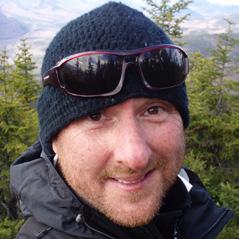
Lily Hartman, Seabrook, NH
Lily is a writer residing on the NH Seacoast who enjoys writing about health and outdoor recreation. She spends most weekends hiking the White Mountains and is part of Hiking Buddies NH 48, a hiking Facebook group. She also enjoys blogging about her adventures and going on trail runs.

Marty Basch, Conway, NH
Marty Basch lives in the Valley with his wife who knows him and loves him anyway. He tends to expound about travel, the outdoors, sports, and food, and has even won a few national writing awards for his humor pieces—if you can believe it.

Bernadette Donohue, Fryeburg, ME
Bernie’s love of adventure, beauty, and people started her 35-plus-year real estate career. Co-chair of White Mt Board of REALTORS Community Service Committee, creator of MWV Photo Contest/Calendars for Charities & Hands of Hope cancer survivor banner.

Mike Cherim, North Conway, NH
Mike is a hiker and skier, and a WMNF volunteer, lending some of his time to search and rescue and to trail maintenance. When Mike isn’t busy with those volunteer pursuits, his guide/outfitter company, Redline Guiding, keeps him and his merry band of guides pretty busy, offering guests plenty to do in all seasons.
Clay Groves, Conway, NH
Clay is the chief executive fish nerd of the Fish Nerds Podcast and a licensed fishing guide. You can hear Clay every day on Magic 104 and 93.5 WMWV, having fun making radio. He lives in the White Mountains with his wife Kristin and teenagers, Blue Jay and Zoe.



Maggie Kelly-Boyd, Portland, ME
Maggie Kelly-Boyd is a project manager for FB Environmental Associates, leading projects on watershed and river corridor management planning, water quality monitoring, and climate resiliency efforts within FBE’s Watershed Management and Community Planning division.

Cameron Twombly, Montpelier, VT
As a stream restoration engineer, Cameron utilizes ecology, engineering, and art to help heal and restore aquatic ecosystems. His work focuses on dam removal, natural channel design, aquatic organism passage, and floodplain reconnection. He grew up in the Mt. Washington Valley and still frequents its mountains, cliffs, and waters as much as he can.
Mark Dindorf, Hart’s Location, NH
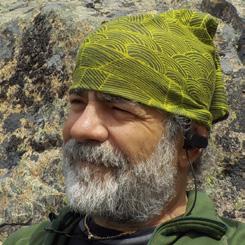
Mark chairs the Saco Swift Rivers Local Advisory Committee and the Board of Selectmen in Hart’s Location, where he and his wife Nancy have lived since 1990. Mark also serves on the board of directors of the North Country Council, our Regional Planning Commission. Mark is an avid outdoorsman, innkeeper, and general manager at the Notchland Inn.
Sarah Davidson, North Conway, NH
Sarah Davidson is a teacher, whitewater and outdoor recreation guide, backcountry skier, and avid hiker and runner. She is an adventure advocate and educator for everything outdoors. Sarah lives in North Conway with her family.


Rachel Freierman, Bartlett, NH
Rachel Freierman is a teacher, ski patroller, and farmer living in Bartlett, NH. When not working, she most enjoys sharing her love for the outdoors with her two young children.
Bob Cottrell, Freedom, NH
Bob is the curator of the Nella Braddy Henney History Room at the Conway Public Library. He has a master’s degree from the Winterthur Program in Early American culture in Delaware. He was born and raised in Florida and has worked in the history museum field since 1980.
Jeff Fongemie, Derry, NH
Jeff has spent the last 30 years working as a climbing guide, search and rescue team member, and avalanche forecaster. Currently, Jeff is the lead avalanche forecaster of the USFS Mount Washington Avalanche Center, and VP of the volunteer Mountain Rescue Service. In his free time, he enjoys mountain biking, sailing, and building wooden boats.
Jeremiah Beach, Bartlett, NH
Jeremiah has been a resident of the MWV for over 40 years and is a lifelong skier and cyclist. Through the years, he has owned and operated ski and bike shops, worked for the US ski team as a technician, and the USOC as a bike mechanic. He currently owns and operates Pro Tune in Glen and is the president of White Mountains NEMBA.
Additional Contributers
Dr. Trish Murray
Brianna Boisselle
Tom Earle
Dr. Cheryl Cullion
Kara Hunter
Ian Dowling

INTERESTED IN JOINING THE VIBE TEAM?
If you reside locally or have ties to the Valley and would like to offer your creative talents, please contact us at info@mwvvibe.com.
Spring 2023 5

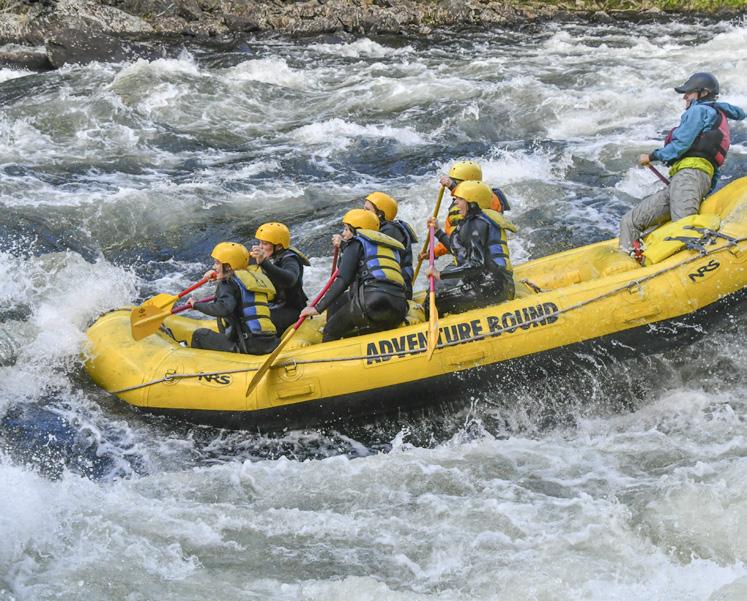


6 MWVvibe.com SPRING 2023 • CONTENTS 5 VIBE CONTRIBUTORS 7 REAL ESTATE CORNER 8 SMALL BUSINESS SPOTLIGHTS 9 NON-PROFIT SPOTLIGHT 26 HEALTH/FITNESS 78 LOCAL ART & HISTORY REGULAR FEATURES 44 - HIKING THE NH48 FEATURES 34 - CLASSROOM TO NATURE 60 - RIDING VALLEY TRAILS ON THE COVER A rider heads down the lower section of the single-track trail "Charlie Don’t Surf ", accessed from the top of Cranmore Mountain.
Brice
10 OVER THE HILLS SANCTUARY By Brianna Boisselle 12 SACO/SWIFT RIVER CORRIDOR MANAGEMENT By Mark Dindorf 18 BIODYNAMIC FARMING By Tom Earle 22 REMEMBERING THE OLD MAN By Marty Basch 26 FUELING YOUR ACTIVE LIFESTYLE By Dr. Trish Murray 30 SPRING SKIING AND OUR ALPINE ECOSYSTEMS By Jeffrey Fongemie 34 FROM CLASSROOM TO NATURE By Rachel Freierman and Sarah Davidson 40 WILDFLOWERS ALONG THE FOREST FLOOR By Matt
44 TAKING ON THE NH48 By Lily
54 IS YOUR DOG BIG-HIKE READY? By Dr. Cheryl
58 SPRINGTIME CROSSINGS By Mike Cherim 60 MOUNTAIN BIKING THE MWV IN 2023 72 SPRING FISHING VALLEY LAKES By Clay
78 ART TOUR OF THE NOTCHES By Bob
Photo by
Shirbach
Maloney
Hartman
Cullion
Groves
Cottrell
Photo by RideNoCo
Photo by Rapid Shooters
Photo by Lily Hartman
REAL ESTATE CORNER
By Bernadette Donohue
Nurturing Your Inner Child
Could an amusing and thought-provoking conundrum really be the true meaning of life? Recently, as I was showing a charmingly adorned vacation home, a seemingly silly wall hanging caught my eye. It said, “What if the Hokey Pokey Really Is What It’s All About?” As I pondered this whimsical question, it began to resonate with me on a deeper level, filling me with a profound sense of lightheartedness and joy.
Surrounded by nature’s lush greenery, remarkable foliage, rugged mountains, and crystal-clear lakes, people who live in the White Mountain region have a continued opportunity to return to their inner child in a playful and curious way. With direct access to an expansive natural playground, there are endless opportunities to experience and share some unforgettable adventures and build lasting memories with family and friends.
Last year, a large group of Badger Peabody & Smith Realty agents and staff joined together on a team-building excursion in the northern White Mountain region. Bumping along dusty mountain trails, climbing over steep terrain, being splashed by deep mud puddles, we bonded by the exhilaration of an exciting ATV adventure. Similarly, on a previous work-related outing, I was introduced to a zip-lining adventure. The following year, I took my eldest, and together we experienced heart-pounding thrills. Flying through the air, past fiery autumn colors, overlooking a stunning mountain range at Bretton Woods, was a mother-daughter bonding adventure that I will always treasure.
To live and raise a family in such an exciting and inspiring place like Mt. Washington Valley makes it easy to remember what life is about when surrounded
by nature and adventure. Maybe that’s why my younger self gravitated to this captivating area, which led me to remain, reside, and raise my family here as well. The inspiring spirit this region offers has become a cornerstone to life in the Valley and continually helps me to stay in touch with my inner child. Grateful to put down new roots in a place where living, loving, and playing are fundamentals of life.
Not surprisingly, over recent years, we have seen a dramatic increase in visitors and residents coming to live and play in the Valley. Home sales have soared with folks excited to experience the magic this area offers. Many also want to be part of a growing community who live and play here on a year-round basis. Like so many beautiful and desirable areas of the world, the pandemic created an influx, and thus, a shortage of housing and rental inventory with a quickened uptick in popularity. Thus, while the gap may seem vast for those looking to settle immediately, our regions are now seeing many encouraging signs for those looking to own or rent. As new properties are under construction, many others are in the planning stages. Also, there is a resurfacing of existing homes and condos due to property owners, changing needs and some exceptional market enticements. All of this will open doors to new listings in 2023. Patience may still be a necessity while waiting for the right property to surface, so keep in mind that the rewards remain great for all those willing to wait. In the meantime, be sure to indulge in some local fun to bring back that childish joy—truly one of life’s essential ingredients to health and happiness.
Living in the beautiful White Mountains of New Hampshire provides ample opportunity to nurture your inner child,

and if you allow yourself the freedom to indulge, this is a place that will allow you and yours to feel renewed, rejuvenated, and reinvigorated.
Bernadette Donohue, REALTOR & Certified Residential Specialist, CRS. Serving the real estate needs of NH and ME, since 1985. Contact Bernie at Badger Peabody & Smith Realty, BernieD@BadgerPeabodySmith.com, (603) 356-5757 x 310 or cell (207) 542-9967

Spring 2023 7
Open Daily at 11am (603) 733-5550 1464 White Mountain Highway Open Daily at 11am (603) 733-5550 6 Mountain Valley Blvd, No Conway
SMALL BUSINESS SPOTLIGHT



LAVENDER NORTH SKY
Lavender North Sky is a small business, located in the beautiful White Mountains of North Conway, New Hampshire, specializing in the design and creation of high-quality, hand-crafted items for women, children, and the home. Founded by owner and designer, April Fitzsimmons, the company’s mission is to create items with a focus on comfort, style, confidence, and love. All inspired by the beauty of the White Mountains.

They are dedicated to using top-quality materials and putting positive energy into every item they create—all with the belief that their love for crochet and passion for creating beautiful designs shines through in every piece made. Customers can be confident that they are receiving a top-quality product that has been crafted with care and attention to detail. From cozy scarves to textured hats to beautiful home décor pieces, every item is crafted with love, light, and positive energy.
Lavender North Sky’s children’s plushies are particularly special, being lovingly crafted with the intention that they become treasured heirloom items, to be passed down from one generation to the next. In this way, the company’s mission is to create items that can bring joy and warmth to the hearts of those who use them for many years to come.
Whether you’re looking for a cozy scarf, a stylish hat, or a cute and cuddly plushie for your little one, this shop has something to suit every taste and need. The unique and original designs are sure to make a statement and add a touch of warmth and charm to your home.

@LavenderNorthSky
HIGHLIGHTS INCLUDE:
• Original and unique designs
• Handmade (with love, of course)
• Highest quality materials and softest yarns used
• Plushies – STANDARD 100 by OEKO-TEX®

Certification/safe for sensitive skin
• Wholesale pricing available
For more information, call (603) 490-5176 or visit www.lavendernorthsky.com.
THISTLE & BONE GARDENS

Kori Dickinson, a native of the White Mountains, having grown up always opting for time playing in the dirt over time indoors, spent many hours with her father tending to the family’s garden, excited to see what they could bring to the table. Working outdoors was something Kori didn’t have to grow to love, but something she found hard to live without. After more than a decade of tackling landscape and garden design projects in the area, Thistle & Bone Gardens (TBG) was created.
TBG works to revitalize their clients’ properties through landscape restoration, as well as vegetable and perennial garden installations.
Maintaining a yard or garden in an area that is notorious for erratic weather patterns, inconsistent daylight, and harsh seasons can prove to be a challenge. TBG works with the natural habitat to foster growth through permaculture practices and create a unique and timeless space that is aesthetically pleasing without the damaging effects of unnatural pesticides and fertilizers.
Have plans to start a new veggie garden, spruce up a neglected yard, or simply breathe some fresh life into your green space? Kori will work with you to create a thoughtfully designed space for you to enjoy.
HIGHLIGHTS INCLUDE:
• Sustainable permaculture practices
• Perennial and vegetable garden installation
• Classic and natural landscape design and restoration
• Garden maintenance plans
For more information, call (603)-960-1241 or visit www.thistleandbonegardens.com.

8 MWVvibe.com Tell us about your unique Valley business at info@mwvvibe.com.
@thistleandbonegardens
SMALL BUSINESS SPOTLIGHT

JEWELRY BY TIM AND FRIENDS
The businesses below are members of White Mountain Independents! Learn more at www.whitemountainindependents.com.


Tucked away in North Conway Village resides the treasure of an on-site, old-fashioned jewelry workshop. Over 40 years in the making, Jewelry by Tim and Friends has evolved so that many in-house services can be performed while you wait. Sizings and repairs in platinum and all karats/colors of gold, along with watch batteries and mechanical servicing of timepieces are accomplished right there.

The breadth of offerings accommodates custom jewelry design, evaluation, repair, antique restoration, and so much more. Customer empowerment through education is offered through every project’s creative process. Everyone at the shop takes pride in guiding clients through the experience of making informed decisions—it is a cornerstone value of their business model.
The staff at Tim’s is trained and certified by the Gemological Institute of America (GIA), considered to be the world’s foremost authority in gemology. Precious gemstone purchases are accompanied by independent laboratory reports, usually from the GIA, and all materials are ethically and responsibly sourced.
A passion that began in the heart of a childhood hobbyist has journeyed into becoming an eclectic jewelry store. Here many decades of experience and wisdom are available for your benefit. Heirloom quality pieces are created every day to showcase your special occasion, event or “just because.” Visit by appointment to preview the shop and experience all the offerings that make this small, local business special … and truly one of a kind.
HIGHLIGHTS INCLUDE:
• Driven by attention to detail
• Friendly guidance in all projects

• Natural gems in heirloom-quality creations

• Work performed on site
For more information, call (603) 356-2189 or (603) 733-7880; visit www.jewelrybytimandfriends.com.
BAVARIAN CHOCOLATE HAUS
Bavarian Chocolate Haus is an old-fashioned candy store at the entrance to North Conway Village, next to the Handcrafter’s Barn. All the chocolates are made by hand, and the owner is usually in the kitchen, where you can observe him making his delicious creations through a huge glass window as you enter the shop.
The Bavarian Chocolate Haus was created in 1991 by Ed and Doris Gazda, whose love for chocolate and people quickly made them a favorite destination for chocolate confections for all who visit or live locally. Current owner and chocolatier, Scott Ferrari, has continued this tradition, purchasing the business in 2008 with his husband David Hallett. In 2017, they opened a second store in Bridgton, Maine.
The adage that you “Never work a day in your life if you love what you do” could be Scott’s motto; he loves chocolate and the many visitors who come to the store every year. If you’ve never tried his delicious chocolates, you’ll be sold after the first bite. Whether you’re a regular, seasonal, or yearly visitor, you’re a friend who Scott appreciates and thanks for your ongoing support and business.
The next time you’re in North Conway Village, stop by the shop, and see— and taste—for yourself the magic that’s created and sold within its walls!
HIGHLIGHTS INCLUDE:
• Old-fashioned candy shop charm
• Watch chocolates being made by hand
• Holiday items and locally made NH maple products

• Shipping services available upon request
For more information, call (603) 356-2663 or visit www.bavarianchocolatehaus.com.
Spring 2023 9
/twpsaledakis
Starting with the desire to give a few dogs in need a second chance, a small but mighty nonprofit has emerged from Berlin, New Hampshire.
Over the Hill Senior Dog Sanctuary is a small, in-home rescue for senior and special needs dogs. Brianna Boisselle, founder and president of Over the Hill, runs the rescue out of her home in Berlin, New Hampshire. From what started with a few sick dogs and a passion to help others, a small but mighty nonprofit emerged.
From working at a sled dog kennel to an animal shelter and vet office, Boisselle saw the number of dogs that needed a second chance. Dog after dog would join her little pack. Dogs with kidney failure, heart disease, blindness, deformities, and behavioral issues filled the bed at night. Despite working two jobs, the expenses of owning these dogs were adding up. That’s how in the summer of 2022, Over the Hill Senior Dog Sanctuary was born. By becoming a 501(c)(3) nonprofit, Boisselle was able to fundraise money for the seemingly never-ending bills. In 2022, the dogs that call Over the Hill home racked up close to $20,000 in expenses. Boisselle has rescued over 20 dogs, most of which are over 10 years old.
sled dogs, dogs that generally live their lives outdoors. Once the dogs retire from their jobs, not many people are knocking down doors to adopt them. Since the dogs are used to living outdoors, new
deemed “unadoptable.” Frankenstein, an Alaskan husky puppy, was born with a severe deformity in her front legs. Without a welcoming, experienced home, Frankenstein would have been euthanized. Instead, she was bottle-fed, and her twisted legs and virtually upside-down paws were splinted and corrected. Frankenstein has troubles with arthritis and her thyroid, but lives a very happy life at Over the Hill. Frankenstein’s best friends are a street dog rescued from Puerto Rico and a husky who was deemed unadoptable due to behavioral issues. Together, the three make an odd bunch of lively huskies who keep the old residents young at heart.
environments can be a bit of a learning curve. Behavioral problems can certainly be a hard obstacle to overcome, though— unlike the popular saying—old dogs can, in fact, learn new tricks. Things like warm beds, couches, and dog toys may
Senior dogs are certainly difficult to find homes for. As dogs age, arthritis sets in, and problems start to arise. Their faces turn grey, their body becomes weak, and they become less desirable to some. That’s why Over the Hill chooses to keep
Senior dogs are certainly difficult to find homes for. As dogs age, arthritis sets in, and problems start to arise. Their faces turn grey, their body becomes weak, and they become less desirable to some. That’s why Over the Hill chooses to keep its dogs as opposed to rehoming them.
Over the Hill is dedicated to providing a forever home for dogs in need, no matter how short their time may be. Most of the pack is made up of retired


seem foreign to them at first. Once they settle in, they’re very appreciative of their new digs. Showing them the ropes of the sweet retirement life is Over the Hill’s favorite part of welcoming dogs.

Not all the dogs are retired sled dogs. Some have other ailments that make them less adoptable—or perhaps,
its dogs as opposed to rehoming them. Some dogs have had three, four, or even five homes before landing at the safe haven. It’s important that the dogs are given a stable environment with a cohesive routine. Finding yet another home while their time is limited just isn’t worth it.
Juggling the many hats of caring for
10 MWVvibe.com NON-PROFIT
SPOTLIGHT Over the Hills Sanctuary
Retired sled dogs soaking up the sun. Moe (10), Skidder (13), and Zima (11) all were rescued after failed adoptions. Photos by Brianna Boisselle
The pack patiently awaits cookies.
THREE WAYS TO LEND A PAW!
With so many dogs to feed and take care of everyday, we have our hands full. In 2022, expenses were over $19,000. Vet expenses are the biggest expense and every dollar helps continue to rescue senior dogs in need. No donation is too small. Donate via PayPal, Venmo, or Facebook or go to www.overthehillsanctuary.org/ways-to-help.


This annual sponsorship helps us provide housing, superb medical care, food, and lots of love. Go to www.overthehillsanctuary.org/sponsor-a-dog to learn more about each dog and begin helping today!



DONATE TO WISH LIST 3

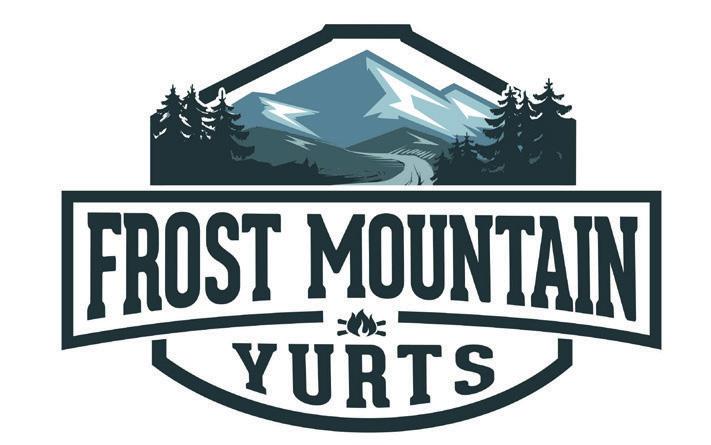
Were always in need of durable dog toys, supplements, chews, dog treats, cleaning supplies ... but all donations are greatly appreciated! Check out our wishlists on Amazon and Chewy for our most recent needs. These lists are always up to date with our most-needed items. For direct links to both of websites, go to www.overthehillsanctuary.org/ways-to-help.
many dogs is no easy feat. There are, on average, eight to 12 dogs in the pack at any given time. Many of them have medical conditions, receive medications, and eat special diets. Adapting to the current pack dynamics is a constant task. Some dogs prefer keeping to themselves on their bed, while others like to romp around outside with their friends. The dogs usually find pack life fulfilling: there are buckets of toys, and the dogs even have their own full-sized bed.
Of course, with a house full of senior friends, there are certainly a lot of goodbyes. The constant goodbyes are the hardest part, as each dog is a true member of the family. Once a new dog enters the pack, the heartache eases. Boisselle remembers each dog fondly, but knows the dogs that have left
would want another dog to take their place. It creates something good out of something so difficult.
In Spring 2023, the rescue will welcome several new dogs. The rescue will spend its first summer hosting events and spreading the word of their mission as a nonprofit. The biggest challenge the rescue faces is the financial burden of going the extra mile for end-of-life care. In November 2022, the rescue lost a dog named Happy who struggled with heart disease and had a heart-based mass. The rescue spent over $5,000 to ensure he had the best chance of living out his days with a wagging tail. As the rescue continues to grow, the dream is a bigger home with more space for plenty of senior dogs.
Over the Hills Sanctuary
Brianna Boisselle, Founder and President Berlin, NH • (603) 631-5676


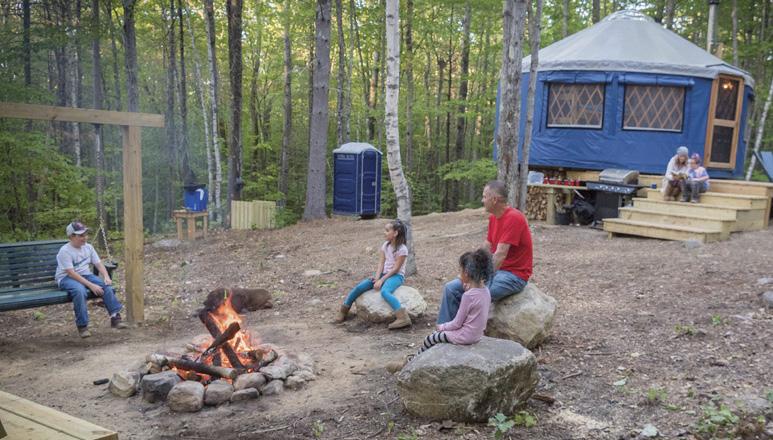
www.overthehillsanctuary.org

Spring 2023 11
(802) 233-7010 www.FrostMountainYurts.com Brownfield, ME OUR SECLUDED YURTS HAVE EVERYTHING YOU NEED FOR A PERFECT GETAWAY! ALL THAT’S MISSING IS YOU! Bring drinking water, sleeping bags and a cooler full of food.
A DOG
Sponsor Goose! $75 Sponsor Moe! $75 Sponsor Pictish! $75
DONATE 1 SPONSOR
2
BernieD@BadgerPeabodySmith.com C: 207.542.9967 O: 603.356.5757 2633 White Mountain Highway North Conway, NH 03860 Cheers,Bernie Finding JOY in your journey home Bernadette Donohue, REALTOR®, CRS, GRI, 37 YEARS
Saco and Swift River Corridor Management Plan Being Developed Advisory Committee Seeks Public Input

12
WiseguyCreative.com photo
By Cameron Twombly, Maggie Kelly-Boyd, Mark Dindorf
The Saco River and Swift River headwaters both start in the White Mountains of New Hampshire, slowly forming distinct channels and draining numerous clear, cold, mountainous streams, as they flow to their confluence in the Town of Conway. The Saco River continues towards the Maine border on its the 136-mile journey from source to sea through forested landscapes, agricultural areas, village centers, and urban areas until eventually emptying into the Atlantic Ocean. The Saco and Swift rivers support diverse aquatic ecosystems and offer the White Mountain region a wealth of recreational, economic, and ecological resources. These unique river systems provide innumerable opportunities for fishing, boating, wildlife viewing, and other recreational and educational activities to local communities and visitors.
These rivers are among the few recognized by the State of New Hampshire as significant resources under the Rivers Management and Protection Program, and therefore require a Corridor Management Plan (CMP), which includes the assessment of the river’s resources, values, threats, and the creation of an action plan to ensure future protection of the rivers.
The Saco-Swift River Local Advisory Committee was formed to guide the management of uses along the Saco and Swift rivers while providing leeway for natural processes and preparing for the impacts of climate change. Local Advisory Committee members are appointed by their municipalities. Members of the committee represent the corridor communities of Albany,

13
Updated plan intends to share the vision and values of the community members that live and play within the river corridors.
Bartlett, Conway, and Hart’s Location, as well as the communities of Madison and Jackson, and the White Mountain National Forest. The Local Advisory Committee provides commentary and local insights to New Hampshire Department of Environmental Services reviewers when wetlands permits, or other permits potentially impacting the river corridor, are submitted to the department for consideration.
The Local Advisory Committee, with consulting help from FB Environmental Associates, funding from the Clean Water State Revolving Fund, and guidance from the New Hampshire Department of Environmental Services, is in the process of updating the historic Corridor Management Plans for the Saco and Swift rivers, which were published in 1994. This updated plan is intended to share the vision and values of the community members that live and play within the river corridors. To accomplish this goal, the Local Advisory Committee is seeking input from local community members that will be incorporated into the development of the final plan. Members of the community are being asked to provide feedback on their perception of the various values provided by the rivers, as well as key threats to those values.
THE RIVER CORRIDORS
River corridors are biologically diverse areas, representing aquatic, wetland, and terrestrial habitats all in close proximity, consisting of rapid geological and ecological transitions. These areas are critical habitats for plants and wildlife and provide a source of drinking water, water purification, flood control, recreation, and fertile soils. The river corridor is defined by the Rivers Management and Protection Act of 1988, as the river channel and the land area located within the distance of 1,320 feet (1/4 mile) of the normal high-water mark, or to the landward extent of the 100-year floodplain, whichever distance is greater.
The natural resources present in the Saco-Swift River Corridor include high-quality rivers and a unique landscape of rugged mountains and cliffs. The Saco River originates at Saco
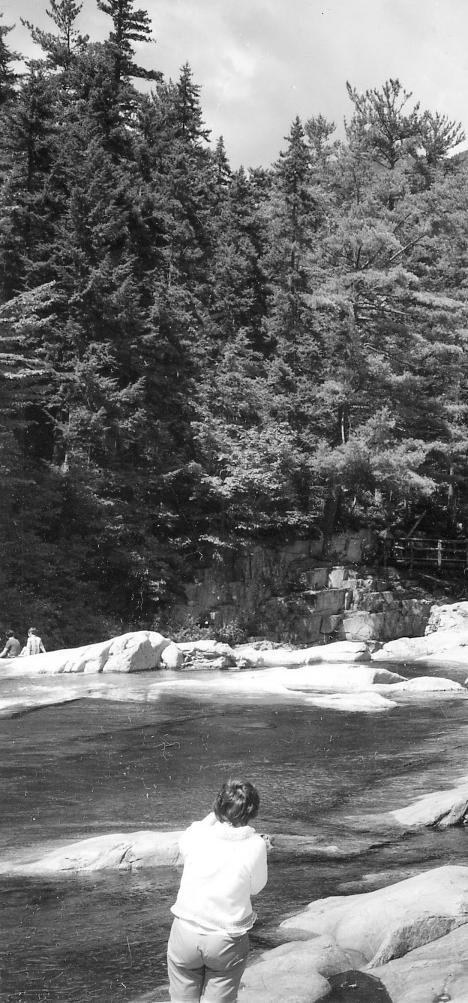

ABOVE LEFT: Tubing and boating on the Saco River is very popular. The COVID-19 pandemic caused intense increases in recreational use of the region. As one local stakeholder described the increased use on the Saco River, “Every weekday is now like a weekend, and every weekend is like the Fourth of July." The Local Advisory Committee identified recreational overuse as a management concern for the river corridors.
FB Environmental
Two back-to-back intense storms in late October, 2017, caused
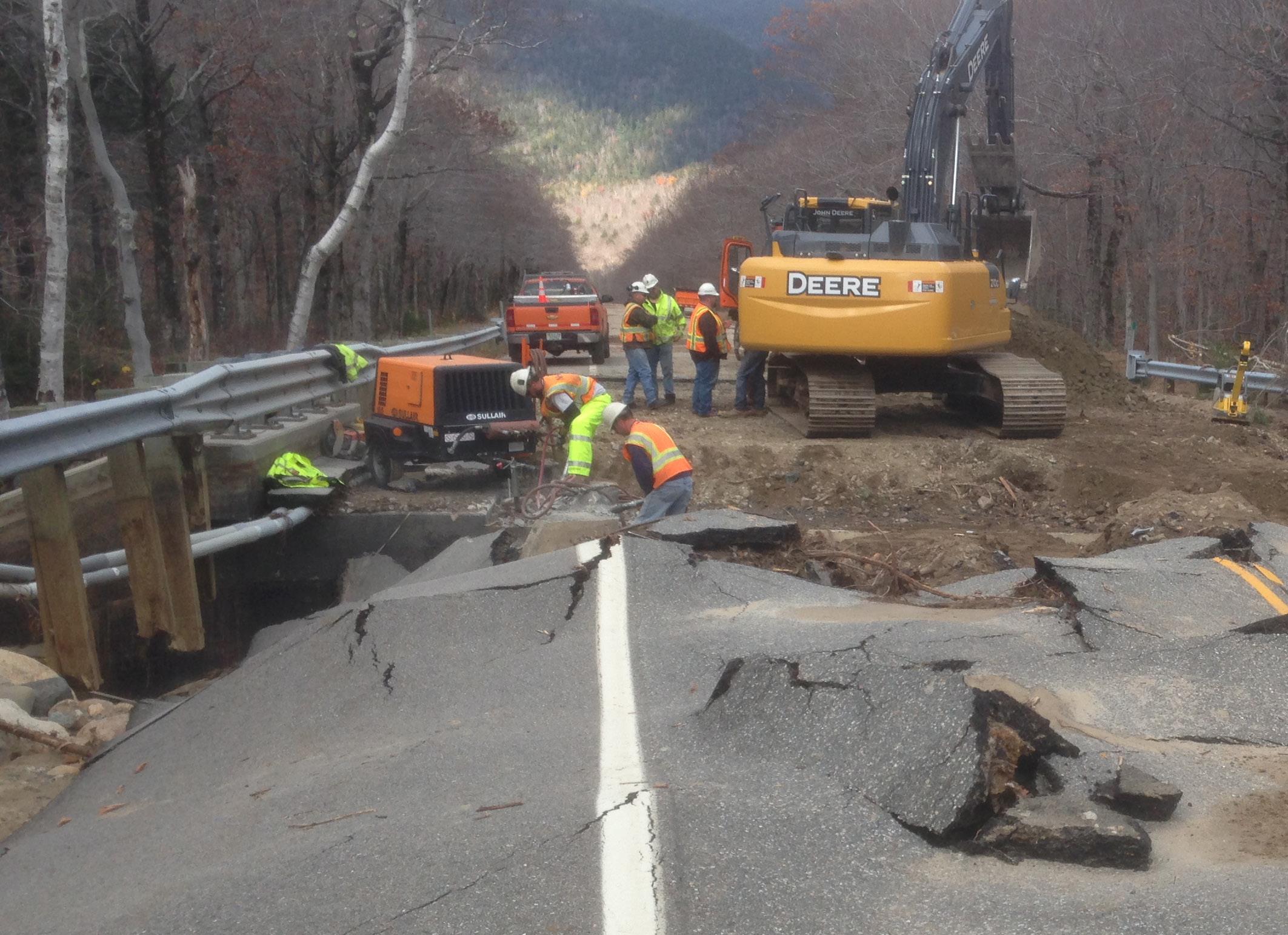
14 MWVvibe.com
Photo credit:
. ABOVE:
Lake on the southeastern border of the Town of Carroll, and then passes through the towns of Hart’s Location, Bartlett, and Conway before reaching the Maine border. In this 40-mile journey, the Saco River drops almost 1,500 feet in elevation, transforming from a small, steep, mountain stream to a broad, meandering river with outstretched floodplains in the lower elevations. The Swift River originates on Mount Kancamagus in Livermore at approximately 2,770 feet above sea level and flows through the forested landscapes of Livermore, Waterville Valley, and Albany until it converges with the Saco River in Conway approximately 26 miles later.
The resources of both river corridors are impacted, managed, and utilized in some way by the communities that surround them. The rivers have been impounded for recreation, confined for safe passage,
In recent decades, forested land, forested wetlands, and row crops have been steadily cleared and replaced by open fields and residential development. Though these land-use changes are slight, they indicate the larger trend of low-density urban sprawl and increased development in the region.
and used to dilute and transport pollutants. Water resources in the area are managed for drinking water and waste management. Historically, the Saco-Swift River Corridor and the surrounding landscape was home to a rich population of indigenous peoples, the Abenaki People. As settler communities grew in the 1600s, English settlers claimed ownership of Abenaki ancestral lands, and inflicted harm, violence, disease, and environmental degradation through the process of land dispossession. Over the subsequent centuries, rapid industrial expansion and development surrounded the Upper Saco River region, altering the river’s landscape.

In recent decades, forested land,
PROFESSIONAL SUMMER THEATRE
Nunsense
Dan Goggin • June 29 - July 8
Arsenic and Old Lace
Joseph Kesselring • July 13 - July 22
The Stranger
Agatha Christie • July 27 - August 5
Fully Committed

Becky Mode • August 10 - 19
Baskerville: A Sherlock Holmes Mystery
Ken Ludwig • August 24 - September 3

104 Main Street, Tamworth
Tickets: 603-323-8500
barnstormertheatre.org


Spring 2023 15
Our 93rd Season!
flooding damage throughout the river corridor, with the first storm causing saturated conditions and exacerbating flooding during the second storm. Above, road repair along Route 302 in Crawford Notch. Photo credit: Mark Dindorf.
Both the Swift River and Saco River have been enjoyed for recreation for decades. Here, families enjoy the Rocky Gorge on the Swift River in 1966.
MOUNTAIN VIEW SERVICE CENTER (603) 323-8135 307 WHITE MOUNTAIN HIGHWAY CHOCORUA, NH 03817 Cindy & Dennis MANAGEMENTDrootin TEAM Servicing all Makes and Models ASE Certified NAPA Autocare
Photo credit: USFS
forested wetlands, and row crops have been steadily cleared and replaced by open fields and residential development. Though these land-use changes are slight, they indicate the larger trend of low-density urban sprawl and increased development in the region. This highlights the importance of land-use planning and regulation within the river corridors in order to protect valuable riparian resources into the future.
Furthermore, impacts of climate change will continue to cause more frequent severe storms, resulting in flooding along the Saco-Swift Corridor. Severe flooding in developed areas, such as the portion of the Saco River in Conway, can mobilize contaminates from floodplains when infrastructure is damaged and severe erosion and sedimentation occur. Changing precipitation patterns are expected to cause greater
annual precipitation in the Northeast, as outlined in a recent National Climate Assessment completed by the U.S. Global Change Research Program. Despite greater precipitation amounts annually, shortened winters and increased winter precipitation falling as rain will likely result in earlier spring runoff and lower summertime peak flows, both of which affect the Saco and Swift corridors. Two of the most recent major flooding events to hit the Saco-Swift Corridor were Hurricane Irene and an October 2017 flooding event. High river levels caused by Hurricane Irene peaked in late August 2011, and resulted in damage to over 100 homes, several businesses, bridges, and trails in the Mt. Washington Valley. The flooding in October of 2017 was a result of a storm from October 24 to 27, causing saturated conditions, followed by Tropical Storm Phillipe (October 29 to 30).
THE CORRIDOR MANAGEMENT PLAN
The Saco-Swift River Corridor Management Plan is intended to help guide management of both rivers over the next 10 years from 2023-2033. During the development of the plan, starting in 2020, the Local Advisory Committee identified several management issues for the corridor, such as a lack of local regulations protecting the land area around the corridor and high recreational use (including lack of regulated public access for recreation). Building on these concerns, a completed assessment of natural, managed, cultural, and recreational resources identified other notable threats to the Saco-Swift River Corridor as flooding, development, riverbank erosion, water quality degradation, and recreational overuse. The land-use ordinance and regulation assessment

16 MWVvibe.com
Map of the Saco-Swift River Corridor, encompassing the river channel and the land area located within the distance of 1,320 feet (1/4 mile) of the normal high-water mark, or to the landward extent of the 100-year floodplain, whichever distance is greater. Credit: FBE.
also identified challenges for riverside communities, especially optimizing use of natural resource setbacks, low-impact development and green infrastructure, and regulatory protections of groundwater, aquifers, and all surface waters. Compounding the impacts of these threats, the population of the region has grown and spurred additional development and use of the region’s natural resources.
Ultimately, the overall goal of the plan is to serve as a guidance document for corridor municipalities to balance the multiple uses of the Saco and Swift rivers. As part of a region that places high importance on its natural resources and its many values, including for economic and recreational purposes, ecosystem and habitat purposes, and utility services, the management and protection of the Saco-Swift Corridor must balance multiple uses while not compromising the quality of its unique resources. Specifically, key goals are to first, manage the resources of the Saco-Swift Corridor, with a particular focus to manage flooding, recreational resources, and natural habitats; and second, to protect the resources of the Saco-Swift Corridor, with a particular focus on protecting natural habitats, wa-




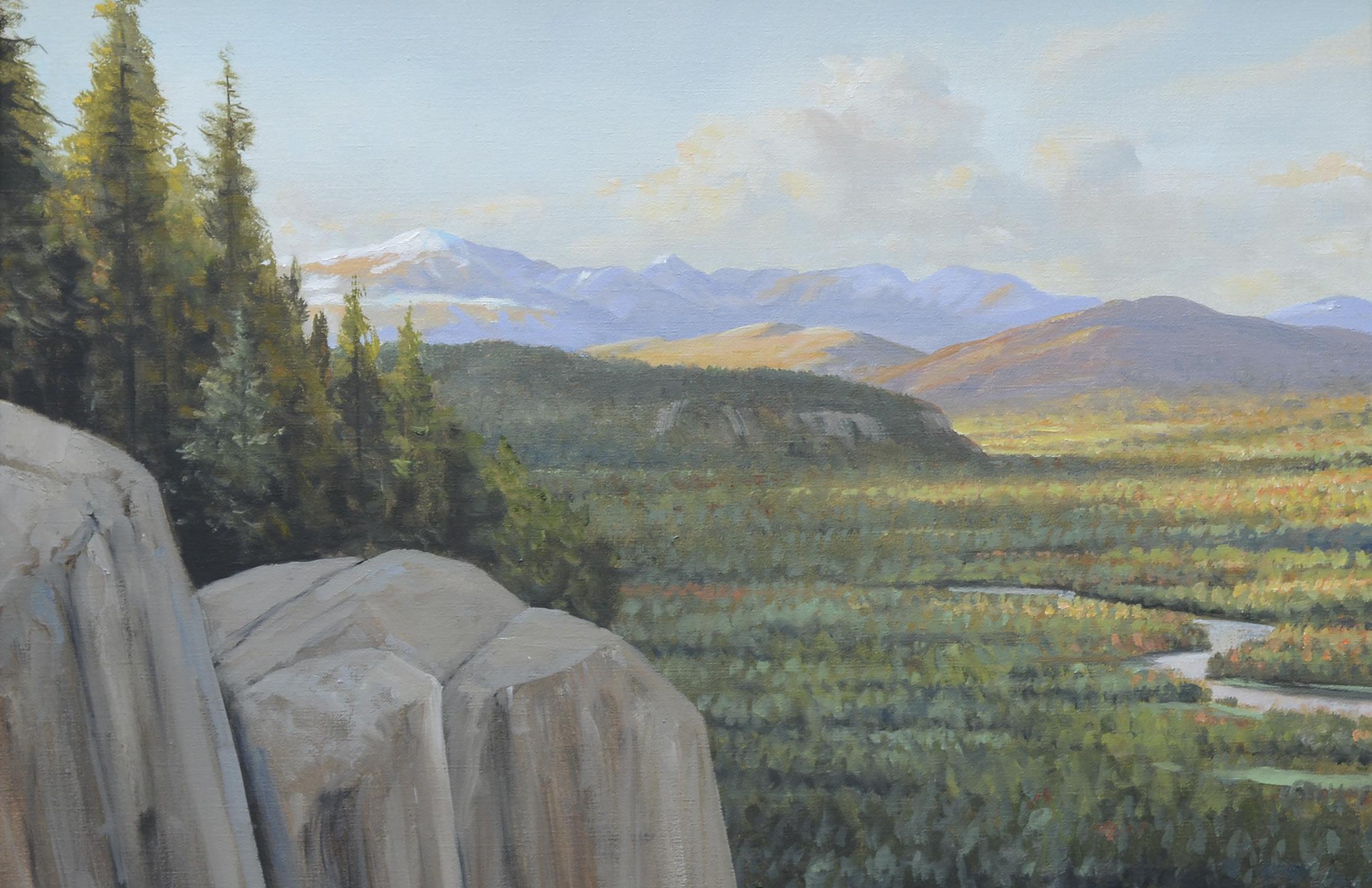
ter quality, in-stream flow, and building climate resiliency.

The completed draft of the Corridor Management Plan can currently be viewed at www.SacoSwift.org.
COMMUNITY SURVEY
The Local Advisory Committee encourages all members of the public to provide their input, including concerns and why they value the river, by partaking in the community survey.

A final version of the plan is expected in late Spring 2023 after public input is incorporated.



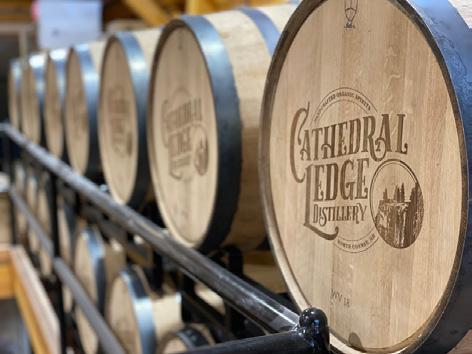
To complete the community survey, please scan the QR code above or visit www.SacoSwift.org. The survey is open until May 18th, 2023.





Spring 2023 17 Position yourself for success by partnering with the 2022 & 2021 Realtor® of The Year. Each office is independently owned & operated. tbrealtypartners.com c: 603.986.5286 e: theresa@tbrealtypartners.com o: 603.569.HOME Realtor® in NH & ME THERESA BERNHARDT
WiseguyCreative.com photo
3340 White Mtn Hwy , N Conway 603-730-5696
Above: The Saco River originates at Saco Lake and then passes through the Towns of Hart’s Location, Bartlett, and Conway on a 40-mile journey to the Maine border. Through Conway, much of the Saco is a meandering river with outstretched floodplains that help store and absorb flood waters, as shown here during high spring flows in May 2020.”
CathedralLedgeDistillery.com
Certified Organic Vodkas, Gins & Whiskeys Tours, Tastings, Cocktails & Snacks
Reminiscing about 50 Years of Farming … and Biodynamics
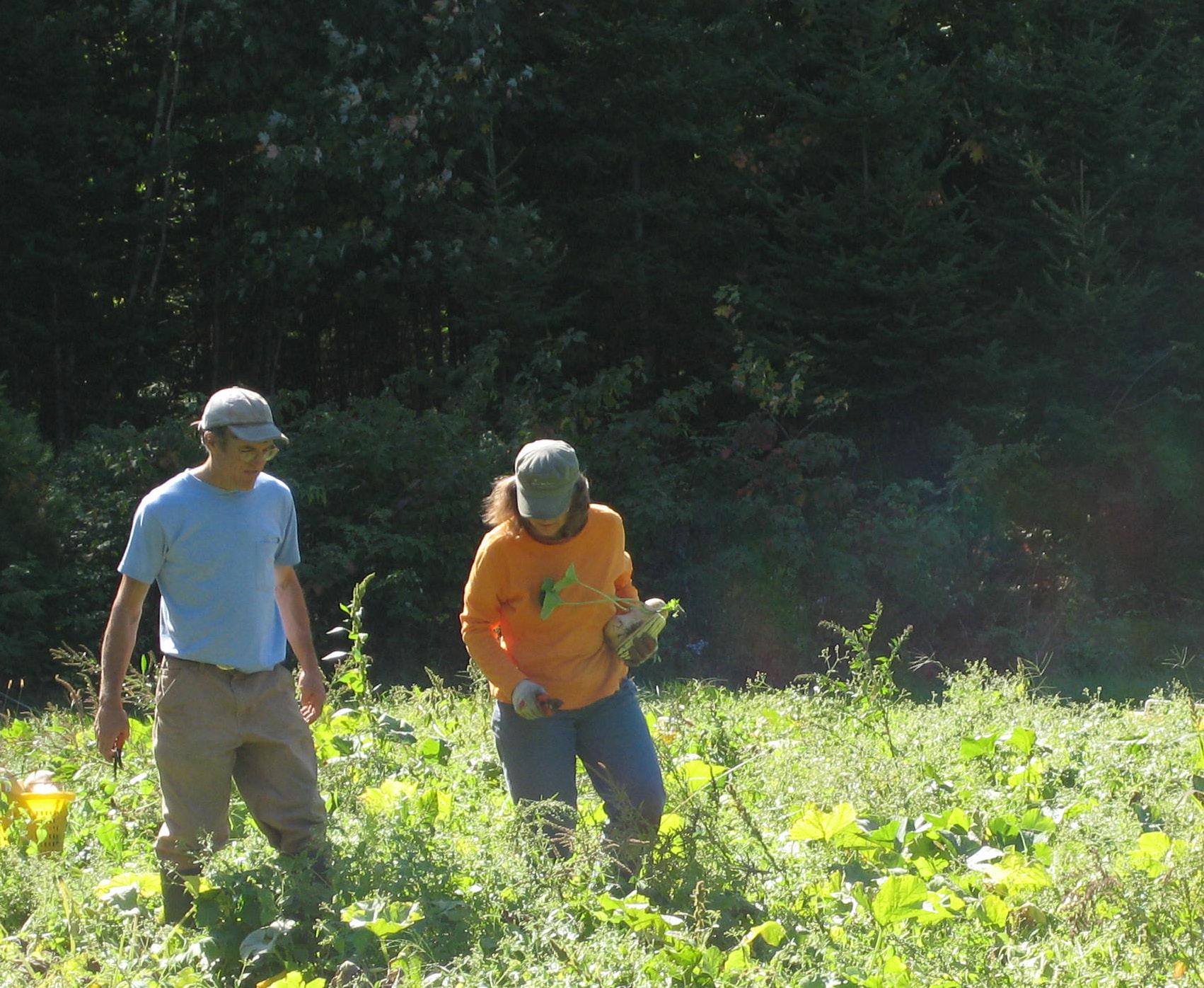 Tom Earle, Earle Family Farm
Tom Earle, Earle Family Farm
The History in a Half-Century of Change
Ihave had the good fortune of living a full life on the land where I was born. I have been asked to sift through 50 years of actively gardening and farming to distill bits of interest for others. Throughout my farming tenure, I have practiced a technique called biodynamic farming, which has—over the years— resulted in vast improvement of my soil and ability to farm. This place, where I live—now 130 acres—was bought by my parents in 1952. The old house, barn, stable, and 100 acres of land, had a purchase price of $5,000. It was their good fortune
married and determined to see what I might do with this place. A garden in its own right, with its boulder-strewn acidified pastures, seasonal streams spreading generously through mature woods, vernal ponds, and stone walls.
In 1980, small farms in New England were already in a century of decline. Growing up in a place that was so nearly wilderness, made this decision for me. It was a huge relief, of course, for my parents, that one of their children had come home to roost. It was miraculous that my wife Elizabeth, who had
From the age of 19, a consistent mentor for me has been the collection of eight agriculture lectures that Rudolf Steiner gave at the request of farmers in what is now western Poland in 1924. As a result of these lectures, the biodynamic farming and gardening movement has spread to all continents, and throughout our country.
that land prices, on rural dirt roads in New Hampshire, still reflected the value that a farmer or logger might yield from them.
My parents, Richard (“Rink”) and Nancy Earle, were among those couples who traded the promise of a “booming” post war economy for a rural lifestyle. My dad was a devoted skier from the 1930s onward, a “professional” ski instructor (among many other eclectic talents), and my mom was a devoted mother, gardener, community volunteer, and an advocate for protecting the gorgeous lake down the road.
My education had very little to do with gardening. My mother may have wished otherwise, but skiing, hiking, baseball, bicycles, fishing, tennis, and swimming, were mostly what my three brothers and I lived for. Rural New Hampshire offered all of this, and the space to just wander and explore the woods! No surprise that years later, at the age of 26, I came home again,
grown up a city girl in Montreal, and had a huge heart for nature and for people, agreed to it! This was a decision for the heart. Our personal challenge was to make this a life of the heart.
Gardening /farming is an immediate teacher of life. Mentors can also encourage this learning. From the age of 19, a consistent mentor for me has been the collection of eight agriculture lectures that Rudolf Steiner gave at the request of farmers in what is now western Poland in 1924. As a result of these lectures, the biodynamic farming and gardening movement has spread to all continents, and throughout our country. As with organic farming, to own the title, a farm certification is necessary. Our farm is not a certified biodynamic farm.
I do want to give credit where credit is due. Over the years, I have been fortunate to visit and meet many biodynamic farmers. Three of the leading thoughts that these farmers are
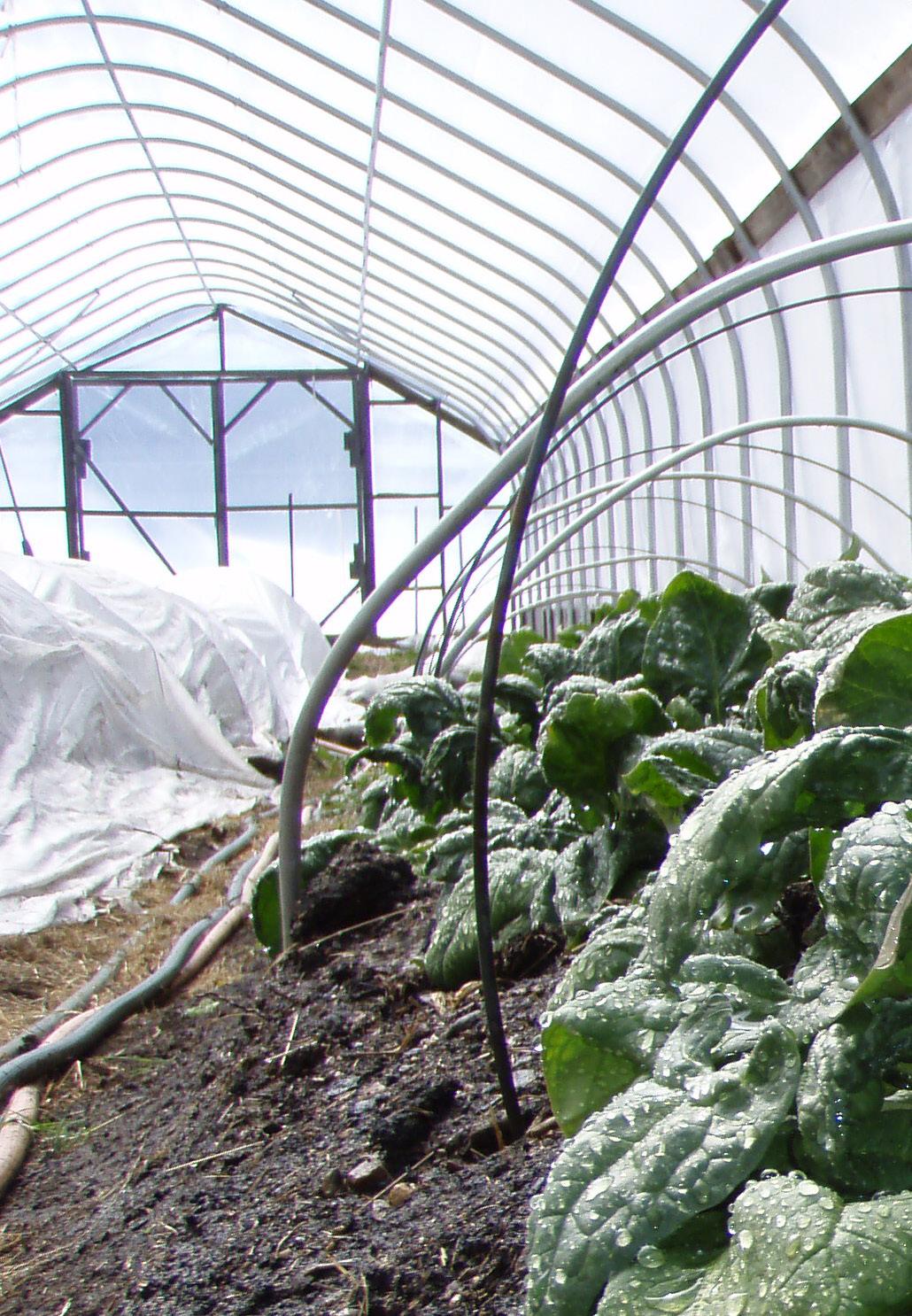
18 MWVvibe.com
Photos by Tom Earle and Andy Bernard
WHAT IS BIODYNAMIC FARMING?
The principles were originally developed by Rudolph Steiner in 1924. The principles and practices use a holistic, ecological, and ethical approach to farming and gardening. Practitioners can choose to become certified, which uses the USDA Organic Standards as a base upon which biodynamics call for additional requirements.
These principles include:
• The farm as a living organism

• Cultivation of biodiversity
• Bringing plants and animals together
• Generation of on-farm fertility
• Compost is alive with the use of preparations
• Cultivation of awareness (a conscious and creative conversation with nature)
• Supporting the integrity and diversity of seeds and breeds
• Enhancement of soil and plant health
• Holistic approach to pest and disease management
• Contribution to social and economic health
More than a certification, biodynamic farming is an approach to living and stewarding the land. There is more embedded philosophy, along with ways of being on and with the land, the animals, and the plants than other certifications provide. In this regard, it is much more akin to the ways in which native communities live and steward land than, say “non-GMO verified” or “fairtrade certified.” Despite some similarities to permaculture, which has more of an ecological science approach, biodynamic considers ecology as well as metaphysics.
WE ARE PASSI NATE ABOUT OUR FOOD AND OUR COMMUNITY

WE ARE ABOUT OUR FOOD AND OUR COMMUNITY
We WORK pro-actively with local businesses and organizations to help keep it a wonderful place to LIVE, WORK, AND PLAY.
Since 2014 thanks to our guests we have donated over $2,096,000 to local programs and non-profits, all thanks to the patronage of our guests, like you!
In addition, the VO also donates over $13K in member gift certificates to over 180 Organizations/Charities in the MWV area, each year!

★ The Valley Originals is a 501 (c)3 Non-Profit Organization ★

Spring 2023 19
Feel diningaboutgood out!
continuously realizing, have proven the most valuable—and simultaneously the most challenging—in our farming experience. They are as prescient today, as they were 100 years ago in 1924: How do we maintain fertility in our soils? How do we manage the rise of health problems in our animals? How do we keep a high level of nutrition in the food we produce?
The first thought is that gardening/farming is fundamentally an act of stewarding the soil. All of time—past, present, and future—is in every handful of soil. Our role is to value it,


nurture it with life now, and for the generations to come. Along with this comes the recognition that soil is a birthright for all living things. Farmers and gardeners are the earth’s essential caretakers of all things biological, as well as the foundation for the earth’s primary social movement. Ours is a task of inclusivity, the “ground” from which all basic needs are met. Living soil supports all that lives, whether microorganisms, plant, animal, or human.
The second thought is that a farm is healthiest when it is experienced as an individual organism. Every aspect—soil, plant, animal, or people—actively interrelate, through the living systems they create, within a farm’s legal boundaries. Living systems that sustain themselves within these boundaries are the essence of “economy.” Economy in its original meaning (from ancient Greece) strictly meant: manager of a household.
The third thought is an outcome of this farm economy. As much as possible, all of the decay that organic systems produce is useable as compost on the farm. Manure and animal bedding, crop and garden refuse, leaves, tree shrub and berry prunings, food waste, wood ash, tree damage from storms, even construction waste (if not industrially altered), or cardboard (if it’s not covered in colored ink or plastic tape), can all have a use. By careful “household management,” the gardener/farmer can, over time, utilize this waste stream to provide all of the fertility requirements that a garden/farm requires. A tee-shirt I saw once read “Compost Rules.” I am a firm believer!
Putting these three ideas into action has readily occupied our life. Our farm is unrecognizable from the 1970s. Pastures that were mostly ground blackberry, wild strawberry, ferns, moss, and goldenrod, now radiate an intense green flush of verdant grasses with the first warmth of spring. Garden soils the color of road gravel are now a rich dark and deep brown. Irrigation is still required, but we are not encumbered by it. Tunnel greenhouses produce crops year round. In our barn stalls, sheep and chickens patiently await the green grass and intense insect life of spring.
Our small mixed-fruit orchard, a biodiverse mix of trees, shrubs, and perennial herbs, is also the host environment for honeybees. Over 600 maple trees throughout the farm produce sap for maple syrup sold through our farmstand. There, people

20 MWVvibe.com
PRACTICING BIODYNAMIC FARMING IN YOUR GARDEN

Think about how you can close the loop of your systems. Integration of animals allows you to use their fertility rather than importing it.
Approach the garden as a whole organism—what are weeds or diseases telling you about the imbalance of the garden?
Follow the biodynamic calendar for things such as sowing seeds and harvesting roots, leaves, or flowers. The biodynamic calendar takes into consideration the whole cosmos—the sun, moon, planets, and stars—as important factors within agriculture.
Integration of biodynamic preparations—in other words, preparation is a natural input that improves soil fertility and plant health. This includes compost, and liquid sprays that are prepared using a certain methodology.

ADDITIONAL SOURCES

• Community Supported Agriculture (CSA) project at EFF: earlefarmandy@gmail.com


• Winter CSA program at EFF: www.thefoothillfarmalliance.com
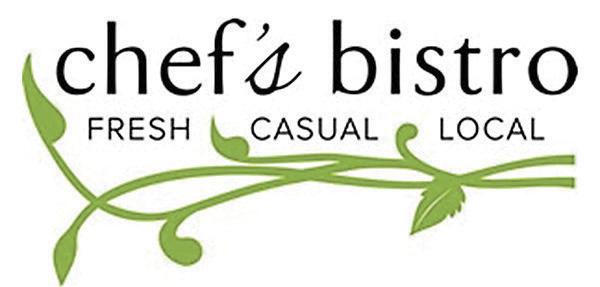
• Biodynamic Farming Association: www.biodynamics.com

• Mt. Washington Valley Eaters and Growers: MWVEG@gmail.com, www.mwveg.com
come and go regularly, picking up produce in season, or eggs, or maple syrup. Others enjoy working with us as volunteers. Over 60 apprentice/interns have worked with us as co-workers, either for a growing season(s) or during sugar season, spring planting, or harvest.

These three leading ideas are a moving target. Life and farming both have shown me an ebb and flow, a constant growth and decline. The years yield many personal, as well as farm, changes. The great tragedy of losing my first wife, Elizabeth in the prime of life. The great fortune of having Ruth, my second wife, join me six years later to help me on the path to healing from that loss! When Ruth and I enjoy our six grandchildren, we often realize appreciation is the greatest reward. Nurturing this gratitude with another generation of farmers is our work now.
Tom and Ruth Earle have been gardening and farming in South Conway since 1971, and 1998. For additional information, contact Earle Family Farm (EFF): earlefamilyfarm@gmail.com
The Mt. Washington Valley Eaters & Growers (MWVEG) guide can help you find local farms, what they offer, summer and winter CSAs ... and so much more. Visit www.mwveg.com for an interactive map, including a searchable database of farms and local food information in the region.


Spring 2023 21 (603) 356-4747 • ChefsBistroNH.com 2724 White Mountain Hwy, No. Conway Village, NH Please check for our latest spring hours! Located on main street in the heart of North Conway village, we are your neighborhood restaurant serving up fresh, local and delicious food in a warm and friendly atmosphere. LOCAL, FRESH, AND FUN FOR EVERYONE!
Western Maine & New Hampshire Lakes & Mountains Carol Chaffee, REALTOR® www.carolchaffee.com (207) 240-1641 • (800) 450-7784
Artist, Lisa Middendorf, will hold a Paint & Sip event, themed “Old Man on the Mountain, Anniversary of the Fall”. The event will be on May 5, 2023, 6-8 p.m. for $30. Held at the Littleton Studio School at 23 Ammonoosuc St., Littleton, NH. Tickets may be purchased online at www.nh.stirupthepaint.com/event. For more information, email Lisa at stirupthepaintnh@gmail.com.

Twenty Years Later, Don’t Take the Old Man of the Mountain for Granite
By Marty Basch



Do you remember where you were when you heard about Old Man of the Mountain falling? I don’t. It’s not like it was 9-11 or the day John Lennon was shot, or other comparable events—depending on your generation. I remember where I was on those days. Nonetheless, New Hampshire was crestfallen on May 3, 2003, the day he crumbled into rubble, a landmark ambassador no more.

Word of his passing traveled quickly in the internet age, and soon his admiring mourners made their way to Franconia Notch and its fallen mecca, placing remembrances like flowers and such as a tribute to New Hampshire’s most famous face.
The Old Man of the Mountain and his demise is a case of legend with many Valley connections over his modern lifetime, which came crashing down 20 years ago this spring.
There was the time a youthful Brooks Dodge decided the Old Man needed a beard. Dodge, who would become a White Mountains icon himself with a storied U.S. Ski and Snowboard Hall of Fame career that included competing in the 1952 Olympics and being a key player in Wildcat’s invention, and friend Bill Putnam (the respected late broadcaster) made a stealth trip to the notch one night. They climbed up to the ol’ fella and tied some pine trees to his chin, thus giving the Granite State’s original rock star a goatee.
The Old Man’s legacy remains a stoic symbol of the jagged land by Profile Lake he once oversaw. Old Man memorabilia is as ubiquitous in New Hampshire as Granite State granite. The image of his old self is on shot glasses, license plates, quarters, t-shirts, key chains, among others, all bound for that kitchen drawer of knickknacks. There’s even an Old Man of the Mountain bonded bourbon crafted right here in the Valley in the heart of Tamworth at Tamworth Distillery. The Valley’s perennial craft brewery, Moat Mountain in North Conway, produces a seasonal bourbon barrel-aged Old Man of the Mountain Belgian tripel, due out this fall.
Though I have yet to see any Old Man of the Mountain cannabis offerings. Who wouldn’t want profile-shaped gummies and chocolate? Can you imagine tapping your inner George Thorogood by having one bourbon, one gummy, and one beer? Now that’s getting stoned.
Kudos to The Man who looked fabulous until his demise. No shots of botox for that rocky dude. It was cement, chains, rods, and whatnot for an uplifting facelift that led to his rugged looks. The Man was manicured too, his al fresco alpine styling
23
GLOW BOWL NIGHTS LEAGUES FULL BAR & MENU BIRTHDAYS & SPECIAL EVENTS COMEDY LIVE MUSIC FACILITY RENTALS (207) 625-9508 www.archiescandlepin.com 135 FEDERAL RD, PARSONSFIELD, ME
staff sprucing him up with a garden hoe, at times, to clean out his ears.
But he was no spring chicken. Though his true age is cloaked in mystery, a couple of surveyors first took note of the formation in 1805, making him at least 198 when he fell. But American Indian legend traced back to the early 1600s says that by following the
youthful and steady.
Whether he was hundreds, or thousands of years old, it makes no matter. The man had way more birthdays than you or I, even if we combined our ages. Now remember those two youthful blokes who gave the Old Man whiskers? Seems the facelift was soon discovered, and the trees
zer, but perhaps those not getting enough headlines were those who kept the face famous. It wasn’t until the early 1900s that he started receiving some TLC from Rev. Guy Roberts of Whitefield and Massachusetts quarryman Ed Geddes, when he started showing his age.
Enter the Neilson clan. In 1960, Plym-
There was the time a youthful Brooks Dodge decided the Old Man needed a beard. Dodge, who would become a White Mountains icon himself with a storied U.S. Ski and Snowboard Hall of Fame career that included competing in the 1952 Olympics and being a key player in Wildcat’s invention, and friend Bill Putnam (the respected late broadcaster) made a stealth trip to the notch one night. They climbed up to the ol’ fella and tied some pine trees to his chin, thus giving the Granite State’s original rock star a goatee.
Great Merrimack River north you’ll find a mountain with a stone face. However, some geologists peg him at about 12,000 years old. The Old Man, though, never talked about his age.

His good looks were secured by admirers, dating to the early 1900s, when observers noticed his forehead start to slip. So they turned to cosmetic geology on the five ledges that comprised the lodestar by using a turnbuckle to secure the rocks. That started the tradition of alpine caregiving to keep him
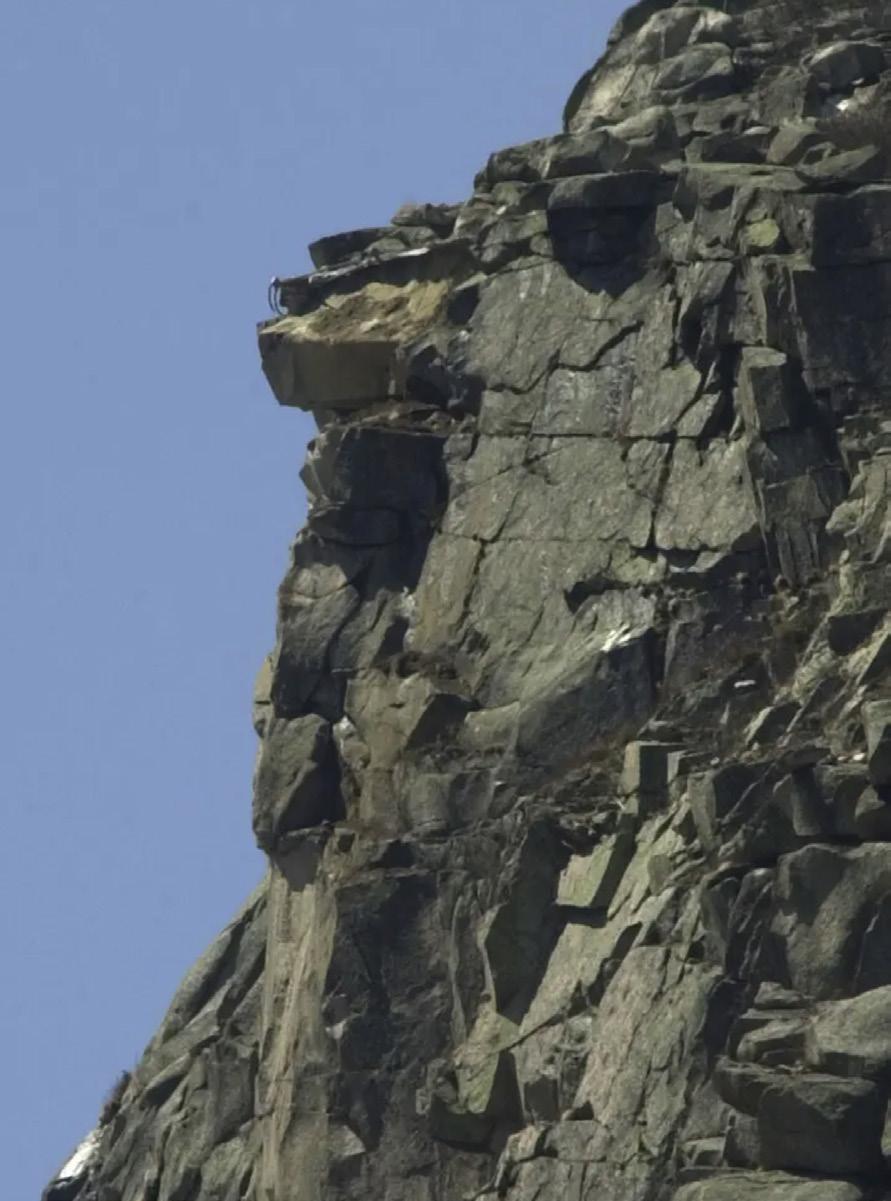

removed in advance of the monolith’s 150th birthday in 1955, which attracted a wealth of luminaries—from state officials to congressmen to President Dwight D. Eisenhower giving a speech in the partly cloudy notch that day. When Ike was asked what he thought of the icon, he gave a natural response of remarkable, wonderful, and interesting … but also added, “What does the Old Man of the Mountains (sic) think of us?”
That is something we will never know.
But what we do know is that aside from Eisenhower, there were plenty of other famous faces who gazed upon the gee -
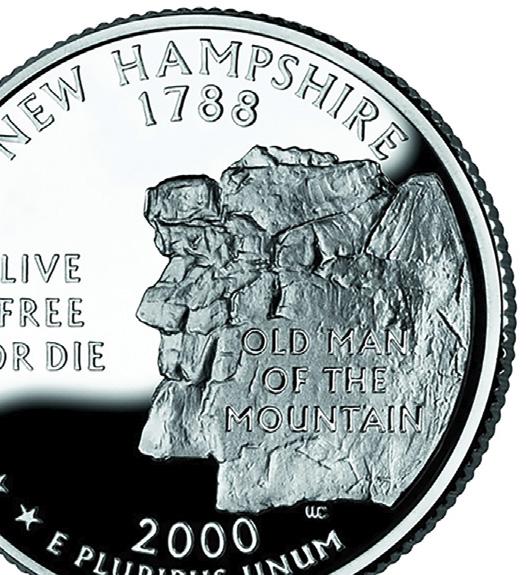
outh’s robust Niels Neilson Jr., who first saw the rock in 1947, became the first official caretaker of the Old Man. He oversaw the man’s face, sometimes hanging from a boatswain’s chair, to give him a shave and a haircut as he called it. Thankfully, he didn’t give him a side part with a small quiff! Neilson, who later enlisted his son David and David’s wife Deborah as part of the team, sealed cracks and kept stock of the Old Man’s movements. Niels worked on him for nearly 30 years.
After he died in 2001, some of his ashes were buried in the Old Man’s left ear.
Though the Old Man is gone, his her-
MWVvibe.com
Before and after. New Hampshire’s famed face-shaped outcrop of Conway Granite, known as the Old Man of the Mountain, adorned the side of Cannon Mountain and was a treasured icon for generations. Today, visitors are greeted by a plaza, where, by looking through a profiler suited to their height, they can
The Old Man of the Mountain continues to be featured on the New Hampshire state quarter, which was first issued in 2000.
Courtesy image
Courtesy image
experience an optical illusion that the Old Man is back on the mountain, where it had long stood the test of time.

itage lives on through the non-profit Old Man of the Mountain Legacy Fund. The fund did its due diligence in creating the Old Man of the Mountain Profiler Plaza in Franconia Notch, dedicated some eight years after his fall from 1,200 feet above the sparkling and apt-named Profile Lake.

There, visitors walk among the 1,000 paver stones etched with names and memories of the Old Man, and can also gaze
A man who spearheaded the memorial was none other than Mr. Tourism himself, the late Conway-born Dick Hamilton, a Kennett High School graduate.
Another prime player in the Legacy Fund is its president geologist Brian Fowler.
up through seven “profilers” to see the face live on.
The Valley’s presence is felt there, too. One of those stones is engraved with the name of longtime Story Land owner, Stoney Morrell. A man who spearheaded the memorial was none other than Mr. Tourism himself, the late Conway-born Dick Hamilton, a Kennett High School graduate.
Another prime player in the Legacy Fund is its president geologist Brian Fowler. He’s a Mount Washington Observatory trustee who lived in Madison for a spell. When the Old Man collapsed, Fowler surmised he fell first from his chin, which led to the end of those famous ledges New Hampshire never takes for granite.
Spring 2023 25 Shop our expanding list of outdoor brands including Swix’s first US outlet store as well as Merrell opening this spring. Plus, other tax-free favorites Columbia, Eddie Bauer and Craghoppers. Adventure runs deep Everything you need to get outside settlersgreen.com | 888-667-9636
Courtesy image
By Dr. Trish Murray
FUELING YOUR ACTIVE LIFESTYLE
REGARDLESS OF YOUR INDIVIDUAL DIETARY NEEDS, THE QUALITY OF WHAT YOU CONSUME CAN DRIVE THE SUCCESS OF YOUR ACTIVE LIFESTYLE
When it comes to leading an active lifestyle, spring in the Mt. Washington Valley is full of amazing opportunities. Whether you’re enjoying the tail end of ski season, getting out on the hiking trails or back in the saddle for some cycling, it is a great time to get outside and explore!

A healthy diet is essential to fueling an active lifestyle. In my functional medicine practice, I often get questions about the best foods to eat. People want to know
sensitivities or health conditions? What about personal preferences? How do you like to eat? What type of activity level are you trying to sustain? There is no easy answer or a definitive, one-size-fits-all diet for everyone. Sometimes it takes trial and error to figure out the best approach for you.
Regardless of your individual dietary needs, the quality of what you consume is important to consider. What you put into your body can affect your stamina,
everything the great outdoors has to offer. The “rainbow concept” of eating is the basic starting point I promote in my clinic. It includes lots of variety, colorful fruits and vegetables, lean protein, and healthy fats.
Getting back to basics, the food we consume can be categorized into three major macronutrients: carbohydrate, fat, and protein. How much of each you consume or in what proportion is the subject of many debates and differs from
what they should eat. Should they go low-carb? Fat free? High protein? Vegan? Vegetarian? Carnivore? What’s the best diet for a healthy, active person on the go?
The answer is … it depends. What are your goals? What foods work well for you, personally? Do you have any food
energy levels, cognitive function, mental state, and your overall physical health. Eating a lot of overly processed junk food is not going to do you any favors. Healthful, whole foods, including colorful fruits and vegetables, lean protein, and healthy fats will help sustain you so you can enjoy
person to person. However, the basic recommendations for the average person are 45-65% carbs, 10-35% protein, and 20-35% fat. If a person is focused mostly on weight loss, then the basic recommendations are 10-30% carbs, 40-50% protein, and 30-40% fat. Even within these
26 MWVvibe.com
FITNESS/HEALTH
What you put into your body can affect your stamina, energy levels, cognitive function, mental state, and your overall physical health. Eating a lot of overly processed junk food is not going to do you any favors.
Courtesy of Redline Guiding
PROTEIN POWERHOUSES
“Complete” proteins include all nine essential amino acids that our bodies need to get from food.
Examples include:

• Eggs, beef, chicken, turkey, pork, lamb

• Fish and shellfish
• Dairy: milk, cheese, yogurt
• Soy: tofu, edamame, tempeh, miso
Vegetables, nuts, grains, beans, or legumes tend to fall short of meeting the required level of essential amino acids on their own, but they can be combined to form a complete protein.
Here are some ideas:
• Quinoa + chickpea or lentils
• Hemp seeds + chia + nuts
• Peas or beans + rice
Protein powders may come from eggs, milk (casein, whey) or plants (soy, peas, hemp). You can also find collagen protein powders from animal or fish sources. Powder may contain artificial colors, flavors, or added sweeteners, so read the labels to ensure you know what you’re buying
recommendations, there is a lot of room for individualization. Let’s talk about some basic rules of thumb from which to build your own dietary approach.
Each of the macronutrients has a different role to play in our diets. Protein is an essential nutrient that plays a vital role in maintaining good health. It is a building block for muscles, bones, skin, blood, and other tissues, and is also necessary for the production of enzymes and hormones. To maintain optimal health, it is important to consume enough protein on a daily basis. Some of the best whole food sources of protein include lean meats, poultry, fish, eggs, beans, nuts, and seeds. Vegetarians and vegans can get protein from plant-based sources such as soy, quinoa, lentils, and beans. Protein powders can also be used, but should only be included as a supplement to a balanced diet. One caution is that excess protein that is not metabolized or utilized for energy will be converted to glucose (sugar)

or fat. So, the saying, “everything in moderation” is good to keep in mind.
Many of us lived through an era of low-fat diets and may have been taught that fat was bad for us. You may be surprised to learn that dietary fat is actually essential to our health! Fat gives us energy, helps our body absorb vitamins, and supports the growth of our cells. It also protects our organs and helps keep cholesterol and blood pressure under control. The key is to focus on selecting the healthiest types of fats, which include monounsaturated and polyunsaturated fats. Sources of these include nuts, seeds, extra-virgin olive oil, avocados, and fish such as salmon, cod, mackerel, herring, tuna, and trout.
The final macronutrient is carbohydrates. Carbs include starchy and non-starchy varieties. Carbs often get a bad rap because sugar-laden, overly processed junk food is typically high in carbohydrates, but with little nutritional value. Many people forget, however,
Along the spectacular South Coast of Wales! Pembrokeshire~the secluded beaches and sandy coves, sweeping bays and craggy cliffs, and tidal estuaries that wind into steep sided valleys to woodland plateaus make this coastal footpath one of the finest in Britain!

Space is limited! Book your spot today! bit ly/Wales2023
Interested but want to learn more before you book? Please contact: brenda.holidaysafoot@gmail.com

Healing Dimensions
Massage Therapy

“Bridging the Mind and Body through Touch”
Julie Sargent, LMT- NH Lic. # 3358 Member AMTA,

Nationally Certified

Spring 2023 27
www.juliesargentmassage.com (603) 502-5326 24 Pleasant St. Conway, NH
Some of the best whole food sources of protein include lean meats, poultry, fish, eggs, beans, nuts, and seeds.
Courtesy image
Smart Carbs
Healthful, nutrient dense carbohydrates include fresh, colorful, whole fruits and vegetables and minimally processed, whole grains.
For example:
• Tomatoes, strawberries, blueberries, blackberries, oranges, pomegranate, melon
• Lettuce, broccoli, cauliflower, eggplant, sweet potato, spinach, squash, beets, kale
• Quinoa, wild rice, steel-cut oats
Fabulous Fats
Full-fat foods are actually often more healthy than reduced or low-fat varieties, as they tend to be lower in sugar and less processed.
Healthy fats to add to your diet include:
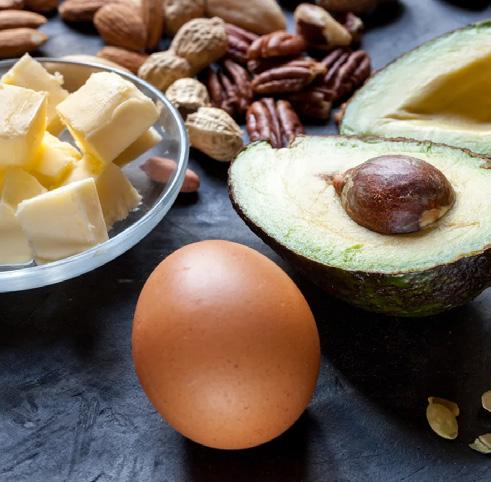
• Coconut milk and coconut oil
• Avocados
• Nuts and seeds
• Dark chocolate (with 70% cacao or more)
• Fatty fish such as salmon and mackerel
• Extra-virgin olive oil
that nutrient dense whole foods such as fresh, seasonal fruits and vegetables and whole grains are also in the carbohydrate category. The main function of healthy carbs is to provide our bodies with energy.
Carbohydrates come in two different forms. Simple (fast-burning) carbs are the quickest form of energy because they are small molecules that are broken down and absorbed quickly by our bodies. Simple sugars, including table sugar, honey, and maple syrup, are examples of “fast burning” carbs. Complex (slow-burning) carbs are composed of long strings of simple carbohydrates. They must be broken down into their simple components to get absorbed, and therefore, supply the body with energy more slowly over a longer period of time. Some examples of complex carbohydrates include whole grain breads, beans, and root vegetables such as potatoes.
If you’ve eaten a sugar-laden breakfast pastry or bowl of cereal for breakfast only to find you’re hungry and sluggish 20 minutes later, you’ve experienced fast-burning carbs and the sugar crash that follows. A better choice to start your day would be some old-fashioned oatmeal with a tablespoon of nut butter, some berries, and a splash of full-fat coconut milk. This will give you a good mix of protein and healthy fat to make you feel satisfied, along with slow-burning carbs for sustained energy.
If you’re packing snacks for the trail, a mix of healthy carbs, protein, and fat will serve you well. Carbohydrates provide energy in a readily available form for your body, while protein and fat will keep you feeling satisfied for longer. Regardless of which specific menu items you include in your diet or in your daypack, a well-rounded selection of minimally processed, healthy whole foods will help fuel your active lifestyle all season long … and for years to come!
Mighty Macro Trail Mix
For a healthy snack on the go with a mix of protein, carbs, and healthy fat, mix up a batch of this healthy do-ityourself trail mix:

• 1/4 cup raw nuts (walnuts, pecans, almonds, or a mix)
• 1/4 cup raw cashews
• 3 chopped, pitted Deglet Noor dates (no sugar added)
• 1 Tbsp chopped 82%+ dark chocolate OR cacao nibs
• 1 Tbsp pure coconut flakes (no sugar added)
Dr. Trish Murray is a highly accomplished physician who has been certified in internal medicine, osteopathic manipulative medicine, energy medicine, and functional medicine. She is the founder of Discover Health Functional Medicine Center in Conway, New Hampshire, and a partner in the Discover Health Movement Membership. Dr. Trish takes an individualized, holistic approach to health to help you take control of your health and transform your life. For more information, visit www.discoverhealthfmc.com. Discover Health Functional Medicine Center • (603) 447-3112


28 MWVvibe.com
Courtesy images
Courtesy images




Spring 2023 29 (603) 307-1066 • www.ncoliveoil.com Two Stores! At Settlers Green and at 2730 White Mountain Highway, No. Conway, NH Over 80 different Olive Oils and Balsamic Vinegars. Non-GMO, gluten free, and no preservatives or added sugar. FIND SOME FASCINATING OLIVE OIL FACTS AND OUR RECIPE COLLECTION AT WWW.NCOLIVEOIL.COM Visit us in North Conway Village or Settlers Green next to the White Mountain Cupcakery!
Spring Skiing and Our Fragile Alpine Ecosystems
By Jeffrey Fongemie, Mount Washington Avalanche Center
At the avalanche center, we talk daily about mountain hazards that have the potential to harm us—skiers/ boarders, climbers, and hikers. Consider though, that as individuals and as a very large ski community, we have the ability to also cause harm to our mountain ecosystems. Think back to the last time you “topped out” a gully in the springtime. What was there? Snow? Blocks of exposed rock? Short, shrubby plants, and mats of low-growing vegetation?
The answer to all these questions is probably yes, which means we have a choice of which surfaces to travel on.
Often after a tiring climb up a 1,000-foot ski run or a technical climbing route, the last thing we think about is what is under our feet; and
handful of plants that grow nowhere else in the world, has done an incredible job at adapting to the harshest winter environment on the planet over thousands of years. These adaptations allow even the smallest flowering plants to survive through hurricane-force winds, deep snowpacks, sub-zero temperatures, and all types of precipitation. Unfortunately, these plants have not had thousands of years to adapt to the patterns and impact of backcountry skiers and off-trail wanderers—and even a couple of bootprints can be catastrophic for these fragile species.
Trampling and disturbance of alpine vegetation are most commonly seen adjacent to trails and in high-traffic areas, including Mount Washington, around huts and shelters, and near the Auto Road;
Trampling and disturbance of alpine vegetation are most commonly seen adjacent to trails and in high-traffic areas, including Mount Washington, around huts and shelters, and near the Auto Road; and increasingly, we are seeing this disturbance at the top of most of our popular ski runs.

often the easiest thing to do is find the softest places to step and the path of least resistance. For fragile alpine flowers and vegetation, this can be a death sentence.
As a conservationist and former caretaker, I have spent countless hours talking with folks about the effects of trampling and leaving the durability of a trail or the snowpack. A common response is, “The plants have survived the harshest weather conditions on the planet. I don’t think stepping on them is any worse.” I wish this were true, but it is not. Alpine vegetation, including a
and increasingly, we are seeing this disturbance at the top of most of our popular ski runs.
Trampling is no one individual’s fault, but rather a product of our community travel habits in the mountains. Sure, Tuckerman has been dealing with this issue for years (and it shows) but with a huge increase in use to other ravines and more remote zones, we have a critical chance to evolve our travel behavior as a community.
WHAT CAN WE DO?
Most of the ski lines and climbing routes in the
30 MWVvibe.com
>>>>>>> WHITE MOUNTAIN BACKCOUNTRY
MWAC photo
Presidentials are not right next to a trail, so traveling off-trail to access these routes is expected. How we do this as a community is incredibly important for the health of these ecosystems, and luckily, there are a few critical steps we can take to drastically mitigate alpine plant trampling.

Like the Leave No Trace principle says, travel and camp on durable surfaces. For us, this means walking on snow, rock, and trail whenever possible. We know how awkward it can be to walk on alpine schist in hard boots—just think of it as a little extra training, and get your poles out for balance.

Unless there is significant snow coverage, lose the idea that your approach route will be in a straight line. It will likely not be straight nor the path of least resistance. It might add a little distance and time to your day, but the mitigation of your negative effect on the ecosystem is well worth the cost of a few extra steps.
Talk to your group about this ethic, and spread the word. Consider not going to a super remote objective that has all but melted out, and instead wait until there is good coverage. It’s not going anywhere!
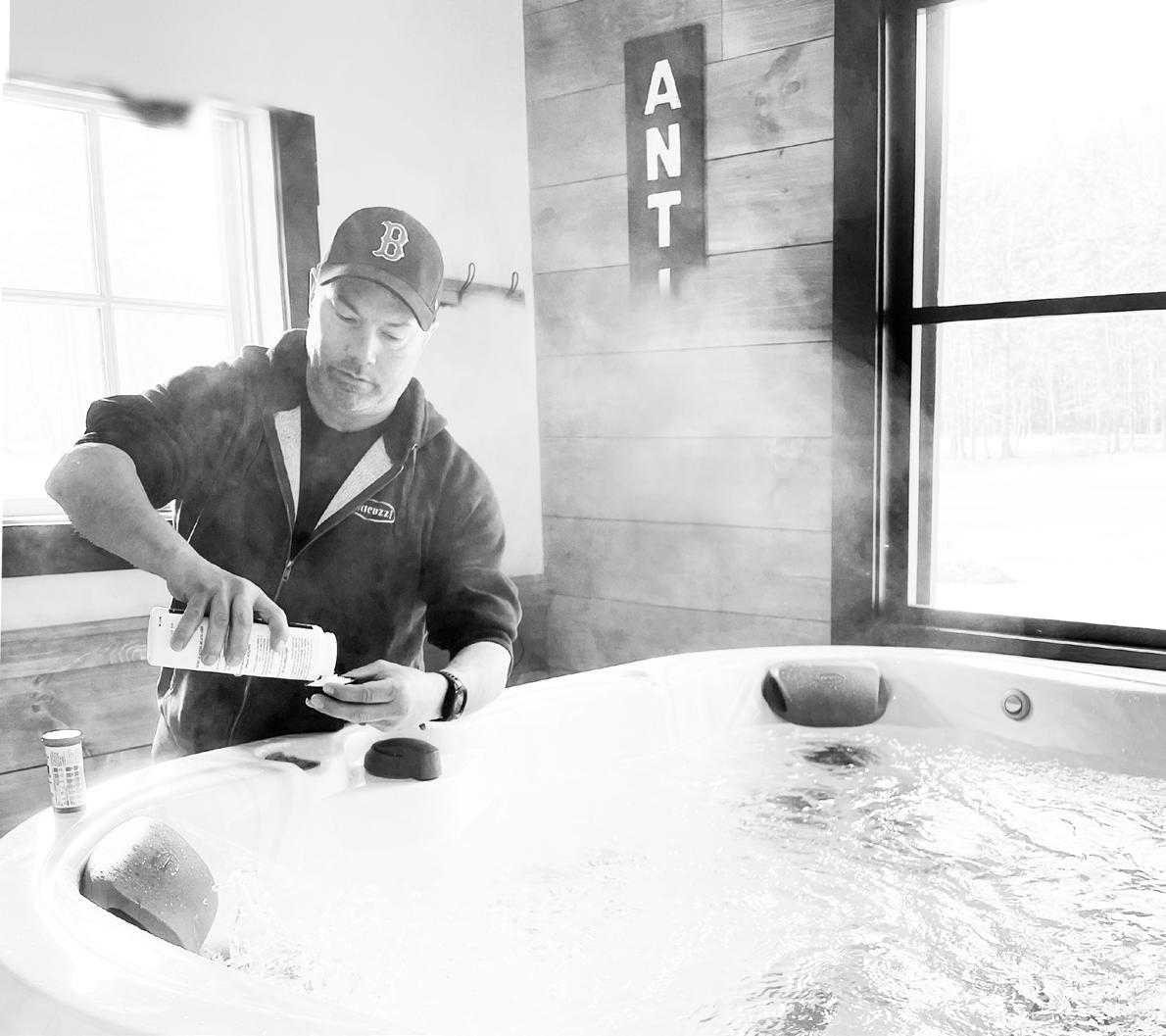
As the Mt. Washington Auto Road opens up this year and many folks will take advantage of this mechanized ski access, Great Gulf is one of the areas where we see this impact most, in addition to the Eastside ravines. If you do find yourself driving your car up to top-access big mountain skiing, please use your fresh legs to take an environmentally conscious approach to your line, which might include a winding route and lots of rock hopping.

Spring 2023 31
Trampling and disturbance of alpine vegetation are most commonly seen adjacent to trails and in high-traffic areas on Mount Washington, around huts and shelters, and near the Auto Road. Perform at your peak. Add hydrotherapy to your White Mountain lifestyle with a Jacuzzi. www.WMHotTubShop.com
MWAC photo Southside Building at White Mountain Trading Post 15 Town Hall Road, Intervale, New Hampshire
The largest Jacuzzi showroom throughout New Hampshire.
chemicals and hot tub tools fully stocked regularly scheduled service available
covers, stairs and umbrellas displayed in a variety of styles MAINTAIN
ACCESSORIZE SERVICE
WiseguyCreative.com photo
ABOVE: Some of the area on the sides of the Auto Road may be flat and may appear to be good for parking, however the Auto Road restricts parking to the designated pull-offs and lots in order to mitigate the impact on the alpine zone.
ABOVE RIGHT: Parking areas are well designated and give hikers and skiers safe access to trails leading to spring skiing.
Just as different climbing and skiing areas across the country have written and unwritten ethics and rules, we would love to see the White Mountain backcountry community wholeheartedly adopt this ethic as the norm of backcountry and spring backcountry skiing in our alpine zones. Like the adage, “You don’t know what you got until it’s gone,” we are incredibly lucky to have amazing ski terrain on our public lands right here in New Hampshire. For current and future generations, let’s take care of it.
The Mount Washington Avalanche Center’s primary focus from Oct/Nov until the end of May is to provide avalanche safety information for people recreating, working, or traveling in the Presidential Range.
MWAC acts as the lead agency for search and rescue for the winter months, and serves as a professional avalanche resource for people seeking assistance with snow and avalanche safety in the east. For more information go to www.mountwashingtonavalanchecenter.org
Between lift-served and backcountry skiing is “slackcountry”— where you use your legs for some of the time, but you get a mechanical advantage to access your line.
There is no better way to fully experience the slackcountry than on the Mt. Washington Auto Road, typically opening for Drive Yourself tours to the summit in mid-May.
The timing of the road opening often coincides with fantastic spring skiing on the eastern facing snowfields on Mt. Washington and steep gullies in the glacial cirques of the mountain.
Long after the ski lifts have closed, and while many turn their attention to mountain biking, climbing, or golfing, it’s a privilege to be able to drive to the summit and get in some spring turns with a relatively short hike back up to your car.
However, the skiable terrain is home to some of the most fragile and endangered plant species. And while these plants may look tough, and have evolved to withstand extreme winds and cold temperatures, they are not meant to be trampled by a ski boot or foot. Skiers must walk on rocks only, or follow existing trails.
Like all Auto Road visitors, skiers
must park in designated areas—not along the sides of the road. Parking lots are demarcated with boulders to prevent encroachment into the alpine.

And even though there is a road, there is no ski-patrol. Rescue efforts for an injured skier could take many long and cold hours. Skiers must choose a line well within their ability.
Voltaire (or Spiderman) said, “With great power comes great responsibility.” If you have the luxury of skiing late into May, it is imperative to act as stewards of the environment, respect the code, and encourage your friends to do the same.
So walk ONLY on the rocks, even if this means taking a circuitous route. Park in the designated areas ONLY, even if this means parking at the summit and walking on the road. And choose your ski-line wisely to keep everyone in your party and yourself safe.
Be sure to note the closing time of the Mt. Washington Auto Road, typically 4 p.m. in early May. This means the last time you can depart the summit is 4:45 p.m. If you linger too long, you’ll find yourself locked behind the gate at the base.
Visit www.mt-washington.com for hours and dates of operations, vehicle and weight restrictions, and Drive Yourself information.
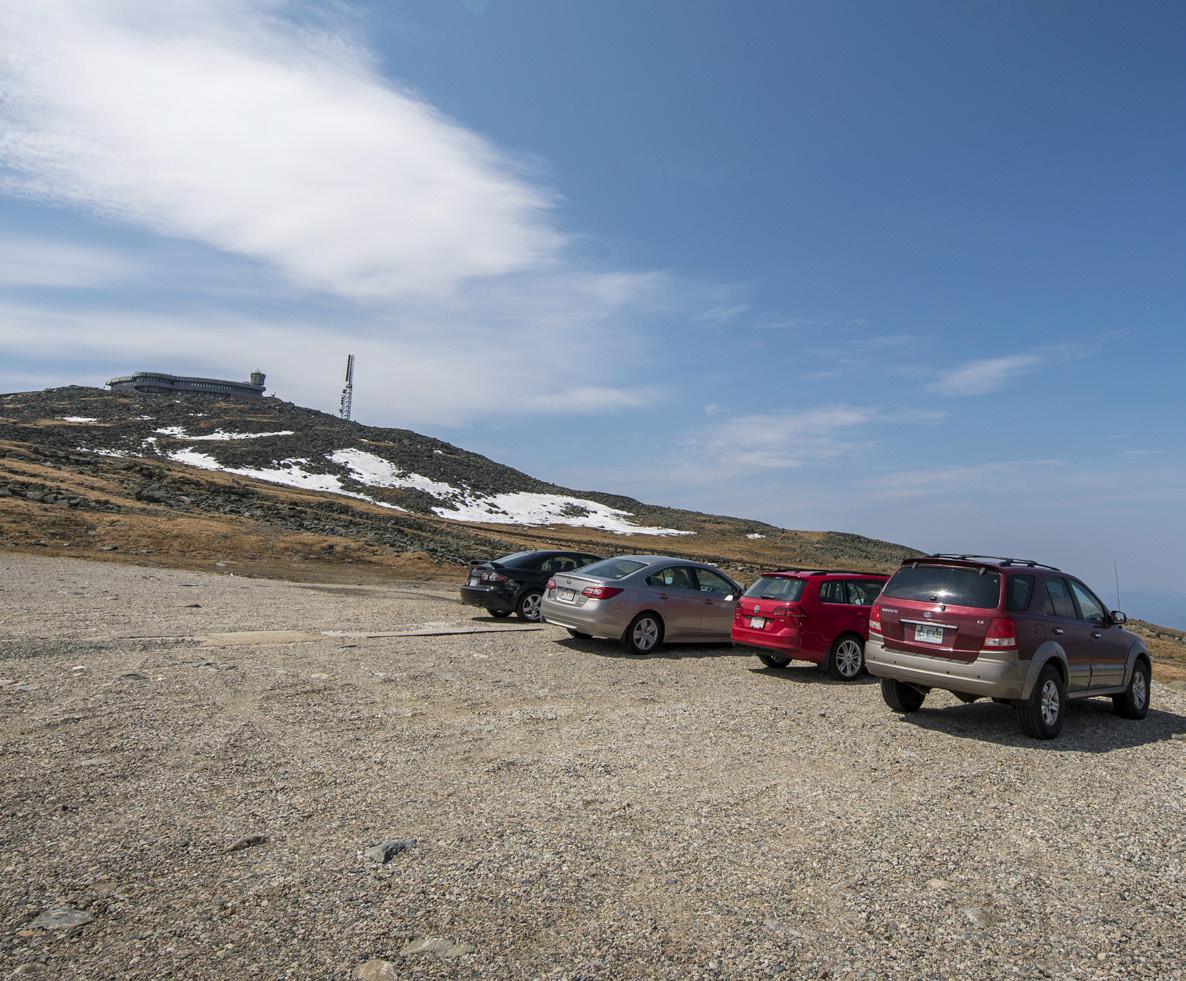
32 MWVvibe.com
SLACKCOUNTRY ON THE MT. WASHINGTON AUTO ROAD
MWAC photo WiseguyCreative.com photo

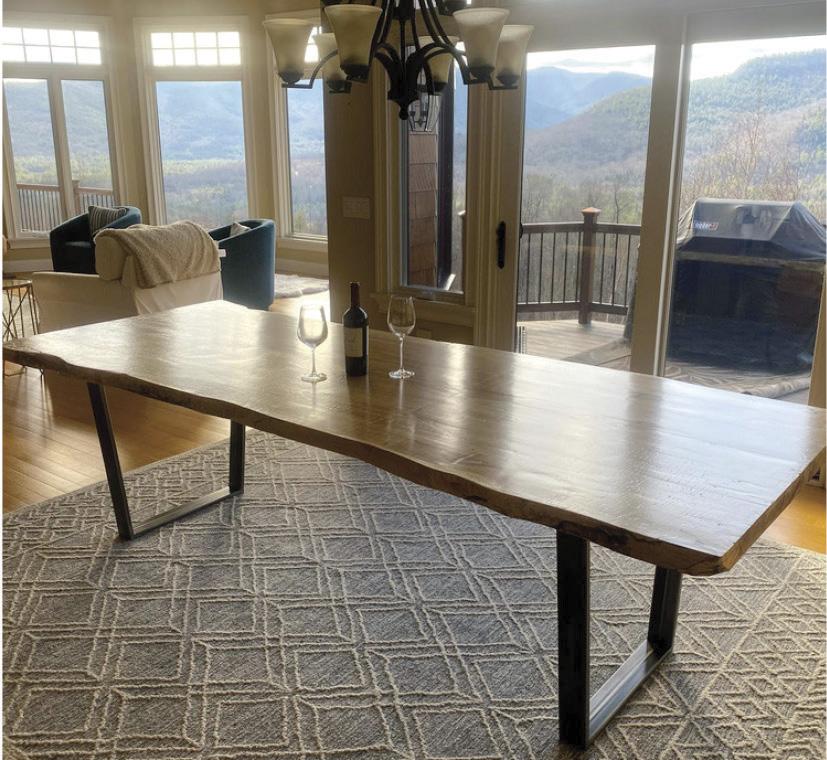



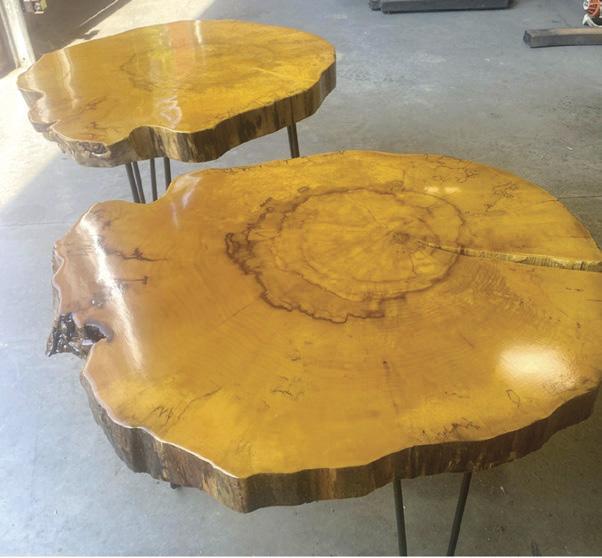



Spring 2023 33 We specialize in making one-of-a-kind, live-edge furniture, featuring ... • custom dining • conference tables • high-top tables • coffee table • benches • mantles • bar tops • raw, unfinished slabs We also offer tree removal, lot and view clearing, custom sawing, and wood chips. Call us today and you’ll see ... WE’RE REAL GOOD WITH WOOD ! East Branch Timberworks is located in Intervale, NH, in the heart of the White Mountains East Branch TIMBERWORKS EastBranchTimber.com • greg@eastbranchtimber.com (603) 387-4572 • 14 Town Hall Road, Intervale, NH /East_Branch_Timberworks @EastBranchTimberworks
Out of the Classroom & into Nature


34 MWVvibe.com
A Growing Sense of Stewardship
By Rachel Freierman and Sarah Davidson
It’s 4 p.m. on a Wednesday afternoon in late January. Snow has started to fall, and the wind picks up as the seventh-grade class from Northeast Woodland Chartered Public School in Conway, NH crosses the frozen ponds of Carter Notch. Packs feel heavy on the students’ backs, loaded down with three days’ worth of clothing and food for a stay at the Appalachian Mountain Club’s Carter Notch Hut. For many, the hike is their first backcountry winter experience, and it has been challenging and not without moments of self-doubt for some students. As the group climbs the final rise to where the hut sits nestled amongst fir and spruce trees, the relief at having reached the destination is palpable. Fatigue is replaced with excitement as the students settle into bunkrooms, don their cozy layers, and get a feel for a winter hut stay. The students are accompanied by their class teacher, Mike Fitzharris, and their
many backcountry learning experiences for middle school students at Northeast Woodland, as part of their outdoor education curriculum. The school, which is currently in its third year and was the first public Waldorf school in the Northeast, prioritizes time outside for students in all classes. Outdoor education is a class for firstthrough eighth-grade students. The curriculum of the outdoor education program leverages the incredible outdoor opportunities in the Mt. Washington Valley to work toward the goal of building a sense of place for students while simultaneously helping them deepen their understanding of self and community.
SENSE OF PLACE
We begin building this sense of place in 1st through third grade through outdoor exploration, games, and art that help students develop skills to observe

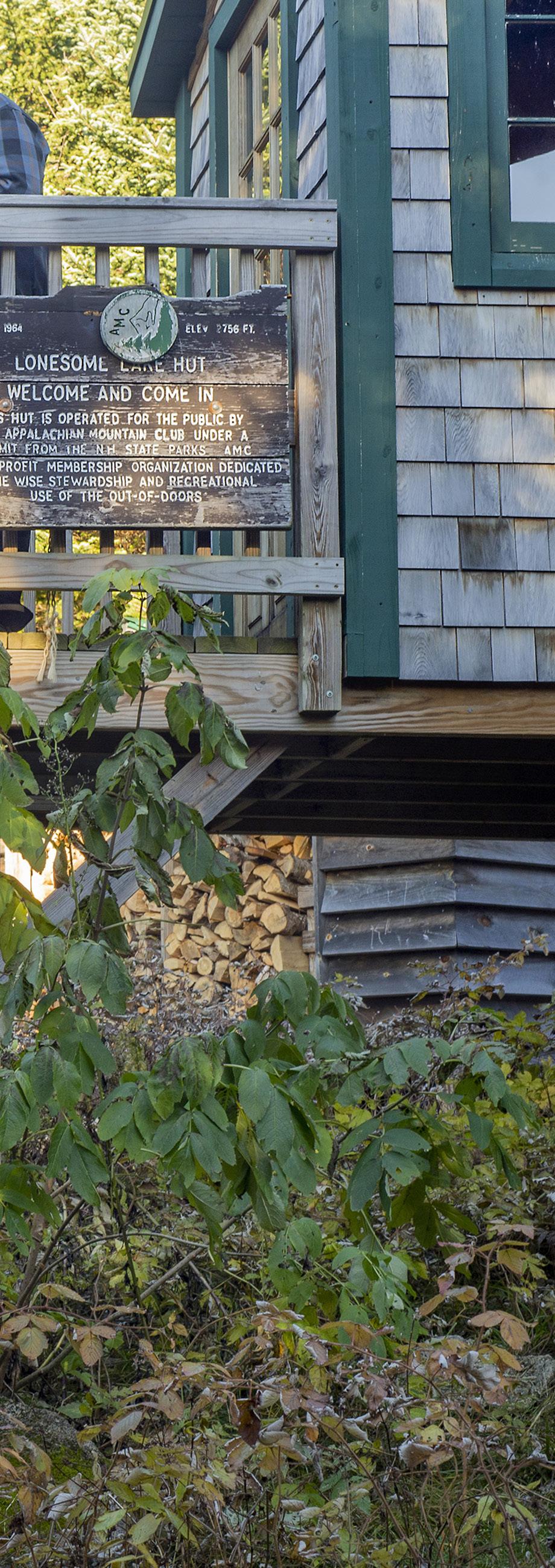
For the next 48 hours, the group will live together in the backcountry hut. They will take turns preparing meals for each other, assisting the caretaker in drilling through two-foot-thick ice, exploring the area, learning to manage their needs in a remote setting, and observing the winter ecosystem in connection with a climate change curriculum they have been studying back at school.
outdoor education teachers, Sarah Davidson and Rachel Freierman. For the next 48 hours, the group will live together in the backcountry hut. They will take turns preparing meals for each other, assisting the caretaker in drilling through two-footthick ice, exploring the area, learning to manage their needs in a remote setting, and observing the winter ecosystem in connection with a climate change curriculum they have been studying back at school.
This winter hut trip is just one of
the world around them. We connect to and expand upon the traditional Waldorf curriculum. In fourth grade, we focus on local geography through a mapping unit that involves the students navigating back to school from Cranmore Mountain, and later incorporates multiple field trips to explore the length of the Saco River Watershed, from the headwaters in Crawford Notch to the outlet in Saco, Maine. In fifth grade, we focus primarily on botany, as the students learn all about the plants and fungi of the region, tap
Spring 2023 35
Photo by Spring Smith Studios
Photo by Travis Hartman
trees to make maple syrup, and ultimately create a field guide as a class.

As the students enter middle school, our focus on science grows, helping students deepen their understanding of this ecosystem and connect to natural spaces elsewhere. In sixth grade, we study local geology and the geologic history of the White Mountains, which leads us into mountain weather and how to properly prepare for a backcountry adventure. In seventh grade, looking through the lens of change, we first explore the history
Boulder Loop Trail to study the impacts of forest fire in relation to forest succession, provide hands-on opportunities for students, not only to develop real life, local connections to the content they’re learning, but also build familiarity with the incredible outdoor spaces that exist in this valley. While some of the students certainly have similar opportunities with family members or friends, for many, these opportunities are unique to their school experience and create an inclusive way for young people growing up in
“I had a lot of fun in outdoor ed class at Northeast Woodland. One of my favorite experiences was traveling to Caratunk, ME for a four-day adventure with my class. I especially enjoyed white water rafting on the Kennebec River with my teachers and friends. I hope to train to be a whitewater guide.”
- Abigail Lain, Fryeburg Academy ‘26

of logging in the White Mountains and forest succession, before segueing into climate change and building an understanding of how this ecosystem, as well as our local economy, might be impacted by a changing climate. Finally, in eighth grade, students spend much of the fall learning about the history of public lands, including the White Mountain National Forest and other local lands, and how the historical narrative of what it looks like and means to be outside has oftentimes excluded large groups of people. In the winter, eighth graders transition to studying the snowpack and learning about avalanches, before carrying these risk management skills into a springtime wilderness medicine unit.
Of course, any of the topics above could be learned about in a textbook and taught to students sitting at desks. It is not just the content that strives to cultivate a sense of place, but the method by which it’s taught and the “classroom” that is utilized. As much as possible, our class time is spent outdoors, primarily in our outdoor classroom atop a hill on our school’s campus or walking the public trails down to the Saco River. We also strive to get students off campus to further enhance and enliven the curriculum. These field trips, such as rock climbing on Cathedral Ledge as part of our geology curriculum, traveling to Hermit Lake Shelters for an overnight as we learn about avalanches, and hiking the
this valley to access and build a connection to the mountains, rivers, and forests of our region.
SENSE OF SELF
In an outdoor setting, especially a remote wilderness setting, students need to be ready to adapt to the present moment. This is why we value the importance of a developed sense of intuition in combination with leadership, cooperation, and communication skills. We want students to observe the natural world around them and have reverence and respect for it, to work with the different elements, and to practice skills for self-reliance. These factors help develop a strong sense of self. Immersed in nature, we must trust ourselves and rely on one another to meet our most basic needs of fire, water, food, and shelter. We shed the layers of our differences and stand as equals with one another. We have the opportunity to see each other as we truly are, in our strengths and our vulnerabilities. The wilderness provides space for students’ individual gifts to shine. We seek to foster a culture at Northeast Woodland that embraces challenges of all kinds, whether physical challenges such a summiting a 4,000-footer, mental challenges such as facing a fear of heights on a rock-climbing pitch, or the emotional challenge of spending nights away from loved ones in a new environment without the comforts of home. Embracing these challenges and
36 MWVvibe.com
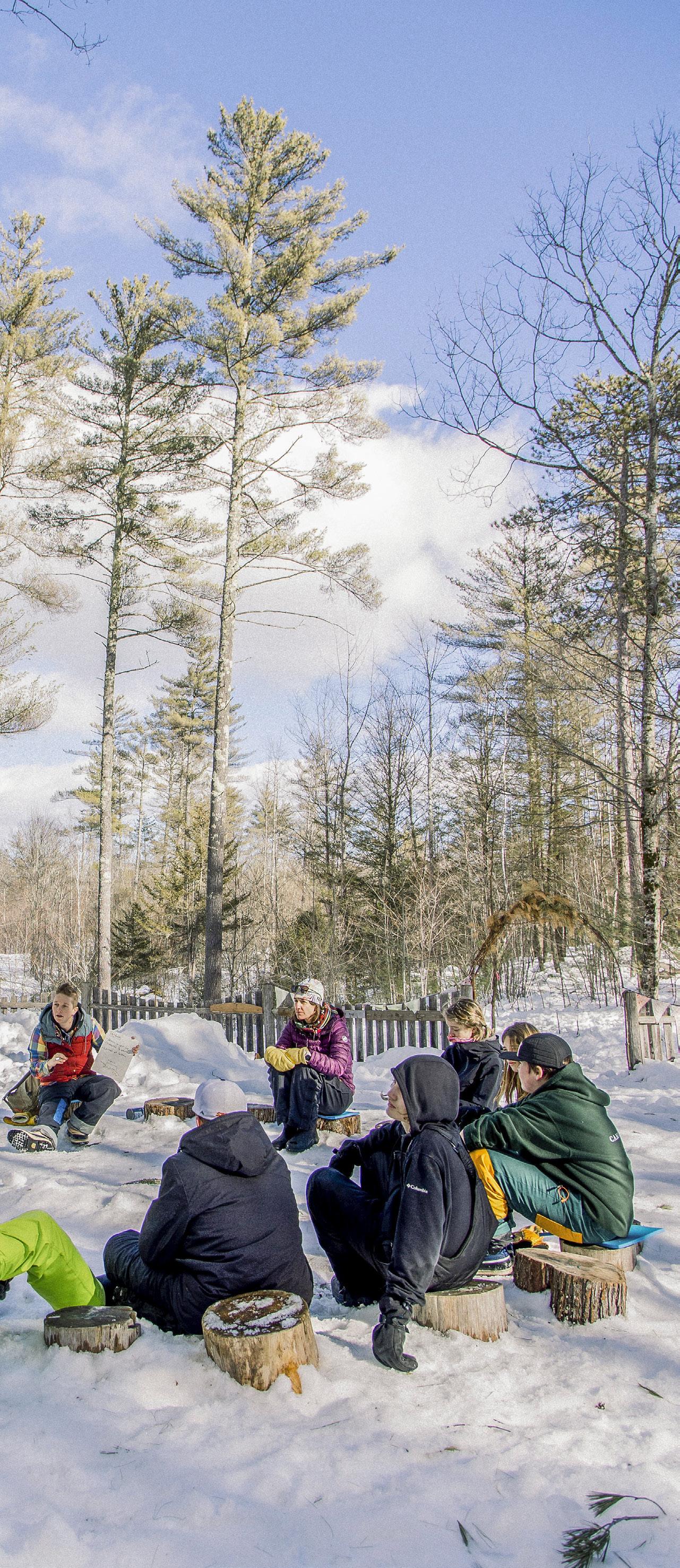



Spring 2023 37
Photo by Spring Smith Studios
Photo by Sarah Davidson
Photo by Sarah Davidson
Empowering Actions Through Risk

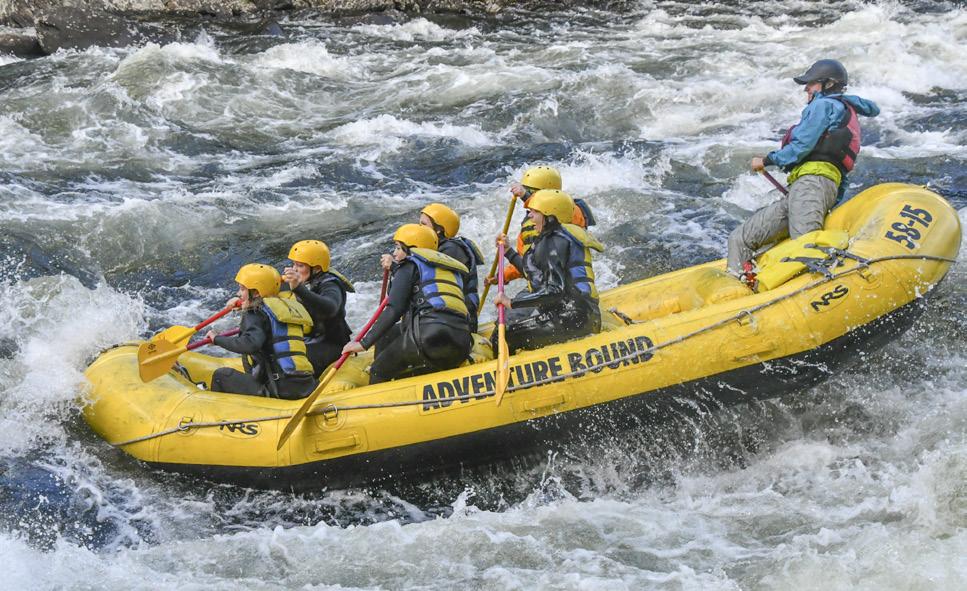
Risk and uncertainty are central to adventure and personal growth. Throughout the middle school years, we introduce, teach, and discuss how to manage risk in the outdoors. While it is not about eliminating risk altogether—an impossibility in any facet of life—but recognizing potential hazards and mitigating the consequences, or knowing when to say no and change the plan. This skill alone saves lives and empowers students to use their voice, mind, and training to make smart decisions. We hope this will carry over into everyday life.
When faced with a potential hazard, we ask, “What would happen if this or that?” We then come up with ways to manage or work around those hazards. If the risks are too high based on a number of factors, including experience, ability, or conditions, students are empowered to pivot. We want students to identify the real problems, then to explore the spaces between them. This is a skill that must be developed and practiced.
developing this new sense of knowing one another after having shared a unique and challenging experience builds lasting relationships that carry into the future and helps students develop self-confidence.
Our outdoor education curriculum combines these life skills with ecological and historical lessons from the land where we live, while engaging students in every aspect of the learning process. In the eighth grade year, we hand responsibility and leadership over to students so they feel a genuine ownership of their
SENSE OF COMMUNITY
An inherent aspect of outdoor learning is community development, which happens through the collaboration of individuals to accomplish tasks and embrace challenges. In a small valley where many students spend much of their school career with the same group of people, it is natural that strong friendships and community are formed. However, embarking on numerous backcountry adventures over multiple years with that group of peers, adventures that involve sharing tents, cooking meals for one another, and
“My favorite class of the week is outdoor education. The adventures I have with my classmates create a stronger bond between us, as well as push our comfort zone in an exciting and educational way.”
- Jenna Burnell, 8th grade

experiences. Students plan and facilitate day hikes for students in grades one through three. The eighth graders spend time learning and practicing different leadership styles and skills, including conflict resolution, giving and receiving feedback, and risk management skills. The younger students are thrilled to have an opportunity to hike, play, and learn with the older students, and most report it as the best field trip of the year. The eighth graders gain a new respect for themselves and a sense of accomplishment, along with a good night’s sleep.
pushing each other and oneself out of comfort zones and into challenge zones, can take those friendships and community to a whole new level. Outdoor learning also creates space for students to show up in different ways than they might in the traditional classroom. In our classes, we have seen multiple students step into leadership roles in the backcountry who often shy away from such roles in the school environment.
In addition to helping students build community within their classes, we also seek to help them look outward
to the vast array of incredible outdoor organizations operating in this region. Thus far, we have collaborated with the Appalachian Mountain Club, International Mountain Climbing School, Green Mountain Conservation Group, the Mount Washington Observatory, the Upper Saco Valley Land Trust, USFS Snow Rangers, Adventure Bound, and the Ecology School. These collaborations enhance curriculum by bringing in outside experts and voices and also emphasize the value of strong community—particularly in an outdoor setting—and expose students to connections that could extend beyond their time at Northeast Woodland.
Back in the seventh-grade classroom at Northeast Woodland, the students sit in a circle on the floor—surrounded by smelly gear, drying snowshoes, and some leftover snacks—as they share laughter, memories, and appreciation for one another from their time together in the woods. They also share their newfound understanding of what it means to travel in the winter backcountry and take care of one another, plus a growing sense of how our NH winters might be changing. It is our hope that by cultivating a sense of place, a sense of self, and a sense of community through thoughtful skill development, education, and appropriate risk taking, we will help build caring and safe adventurers and environmental stewards—students that see the collective good in caring for one another and our planet.
38 MWVvibe.com
Photo by Rapid Shooters
Photo by Rachel Freierman
North Conway’s Very Own Overnight Summer Camp


Camp Waukeela is located in an area of outstanding natural beauty where girls come to disconnect from electronics and discover their true selves. We offer a wide range of activities from arts and crafts, lake swimming, boating, tennis, horse-back riding, ropes, drama, and more!

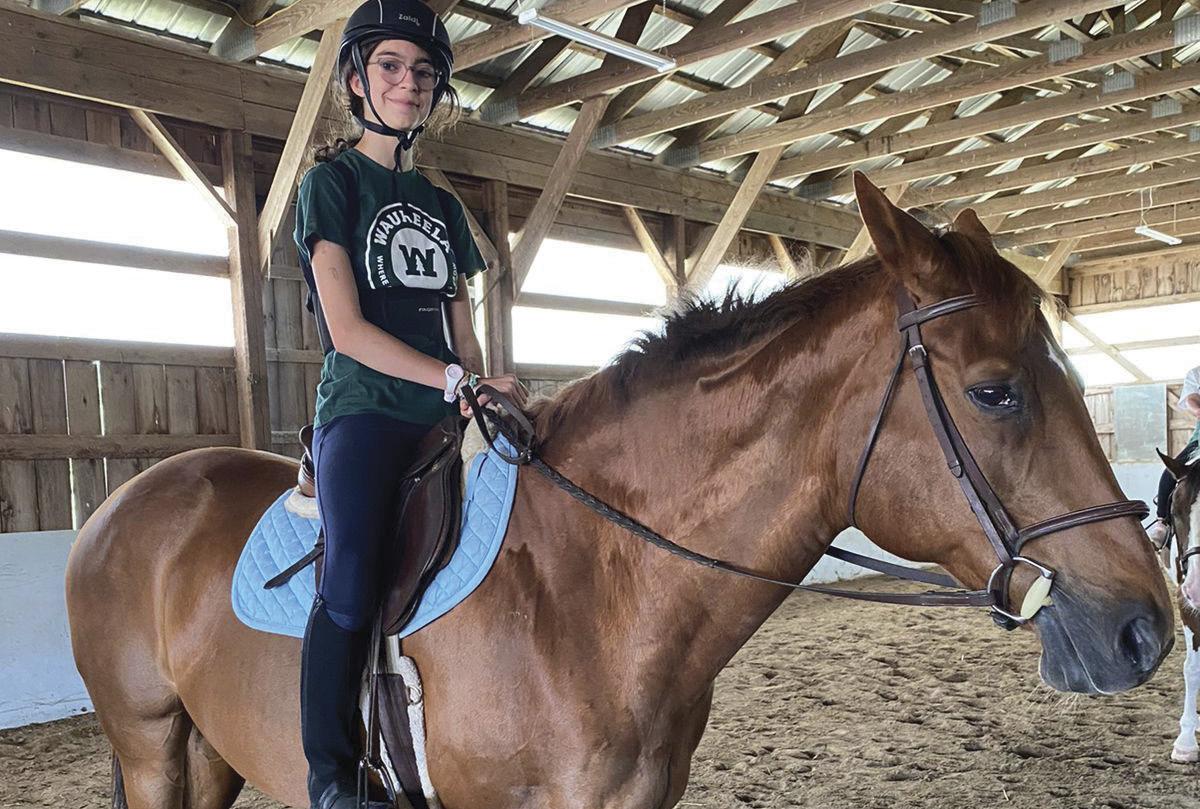

2023 DATES & SESSIONS
For girls completing 1st – 10th grade (Ages 7-15)
3 ½ WEEK SESSIONS
Session 1: 6/24 – 7/18
Session 2: 7/21 – 8/13
2-WEEK SESSIONS
(first-time campers only)
Session A: 6/24 – 7/8
Session B: 7/21 – 8/4
FULL SUMMER – 7 WEEKS 6/24 – 8/13
For rates and dates, plus camp videos and transportation, scan with your phone’s camera >

Spring 2023 39
Located on beautiful Crystal Lake in Eaton, NH!
(603) 447-2260 • Route 153, Eaton, NH • www.waukeela.com
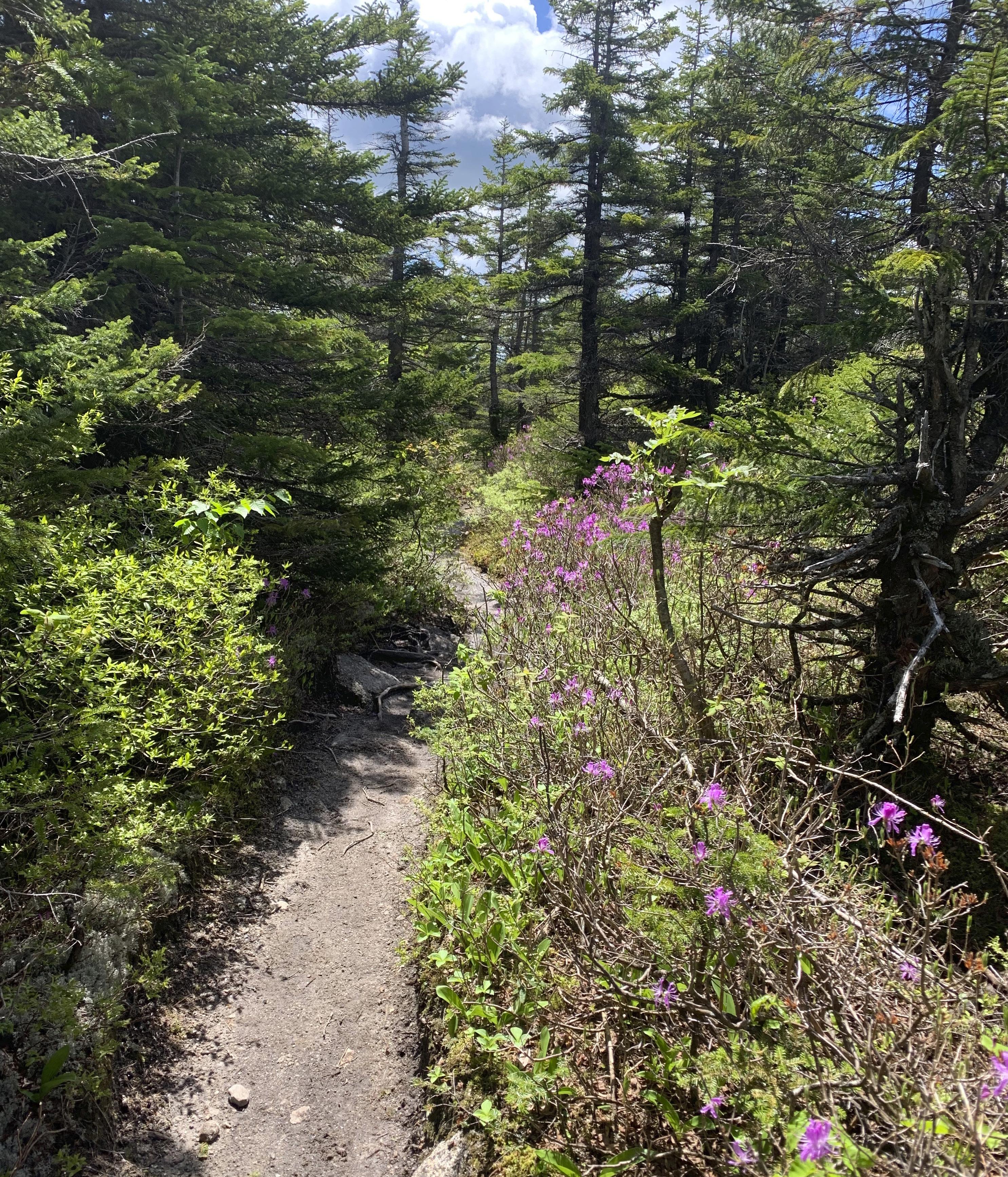 The trail along Zeacliff, which begins in Bethlehem, NH . Photo by Lily Hartman
The trail along Zeacliff, which begins in Bethlehem, NH . Photo by Lily Hartman
Wildflowers Along the Forest Floor
Words by Matt Maloney
Photos below by Lori Kinsey and Matt Maloney
Once we arrive past the halfway mark of springtime in the mountains, early hints of rejuvenated life that started with sap running up trees on warm days in March are no longer mere hints. Plant life is now on the cusp of the final bursts of change as buds swell and we edge closer to the greening of the mountainsides. There is one final and wonderful moment of anticipation before the buds burst with leaves, though. This is the anticipation of woodland wildflower season. Peaking around the middle of the month of May on the lower slopes within the mountains, this final prequel before leaf-out is an inspiring time of year.
The wildflowers that carpet the forest floor in mid-May, give or take a week, are often grouped into the category of spring ephemerals. These spring ephemeral wildflowers take advantage of the open, sun-lit canopy just before the trees leave-out and once the snow has finally melted from the ground, reinvigorating the soil with warmth. Differences in elevation mean that spring ephemeral wildflowers of the same species will bloom at different times in the region. As the snow melts at the higher elevations, the wildflower blooms—much like the tree leaves—will move up the mountainside with the warming soils. Some hardy species such as painted trilliums and trout lilies will even make it up above 4,000 feet elevation, or so, by June.
Spring ephemerals—like all our other woodland wildflowers—are perennials, blooming from year to year whenever they accumulate enough stored carbohydrate energy in their underground tubers. We’ve chosen to highlight five species for their beauty and as flowers that can be seen trailside. We’ve also included the most conspicuously blooming tree of May, the shadbush or serviceberry, which adds beautiful brush strokes of vivid white to the mountain stream sides and sunlit areas just before the tree buds burst.
Here are some wonderful wildflowers to seek out on a hike in May. Take your time, go slow, and look down!
After the spring ephemerals of early and mid-May start going to seed and after the delicate white blossoms of the Shadbush (Serviceberry) trees fall to the ground, another beautiful bloomer starts to be seen. Rhodora shrubs start blossoming in the latter half of May in wetlands and into the first three weeks of June on mountain tops. The brilliant pink or purple blossoms are quite a sight when seen in large colonies. Rhodora shrubs do well in acidic soils and they are almost exclusively seen in our region in swamps and bogs, pond edges, rocky summits and ledge areas, even making into the areas above tree line. All of these habitats typically have acidic soils in this area, allowing Rhodora to find a niche.
One of the most brilliant displays of Rhodora blossoms every year is the stretch of the Appalachian Trail just before and after the turnoff to Zeacliff, a popular viewpoint in the Pemigewasset Wilderness.
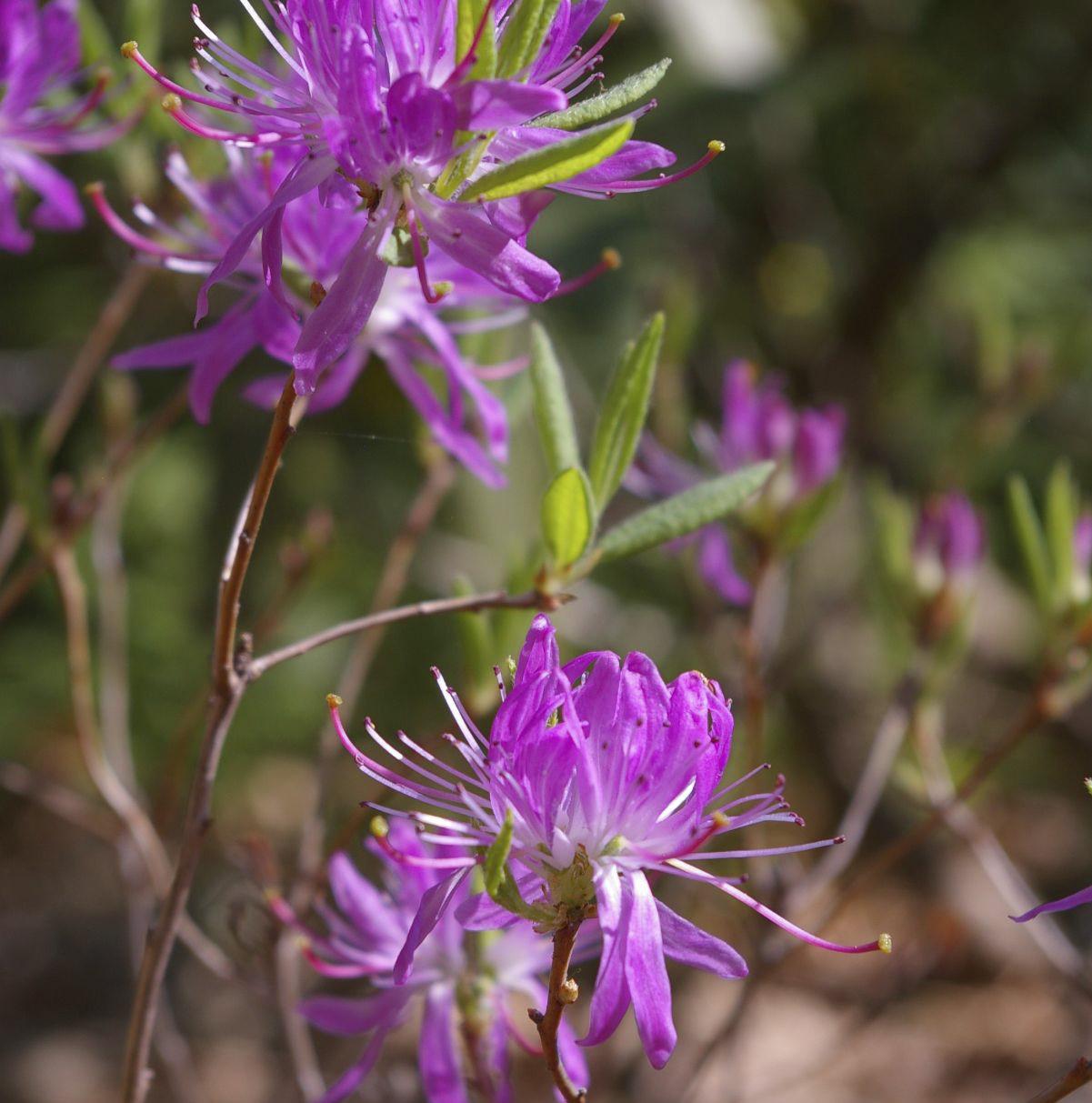
Spring 2023 41
Rhodora (Rhododendron canadense)
Trout lilies get their name from the brown mottled pattern on their waxy green leaves. The leaves come up from the base of the stem at ground level, so they are known as basal leaves, a key diagnostic term used in flower field guides. The mottled appearance of the leaves resembles the mottled or chained pattern on the backs of our native brook trout. Brook trout inhabit the running streams that trout lilies often grow alongside, as this flower in particular loves and needs full sunlight to bloom. When they are fresh, they have a sweet scent; and if you turn up their nodding, curled-up sepals, which resemble petals, you will see bright orange pollen dusting the long stamens protruding from the flower.
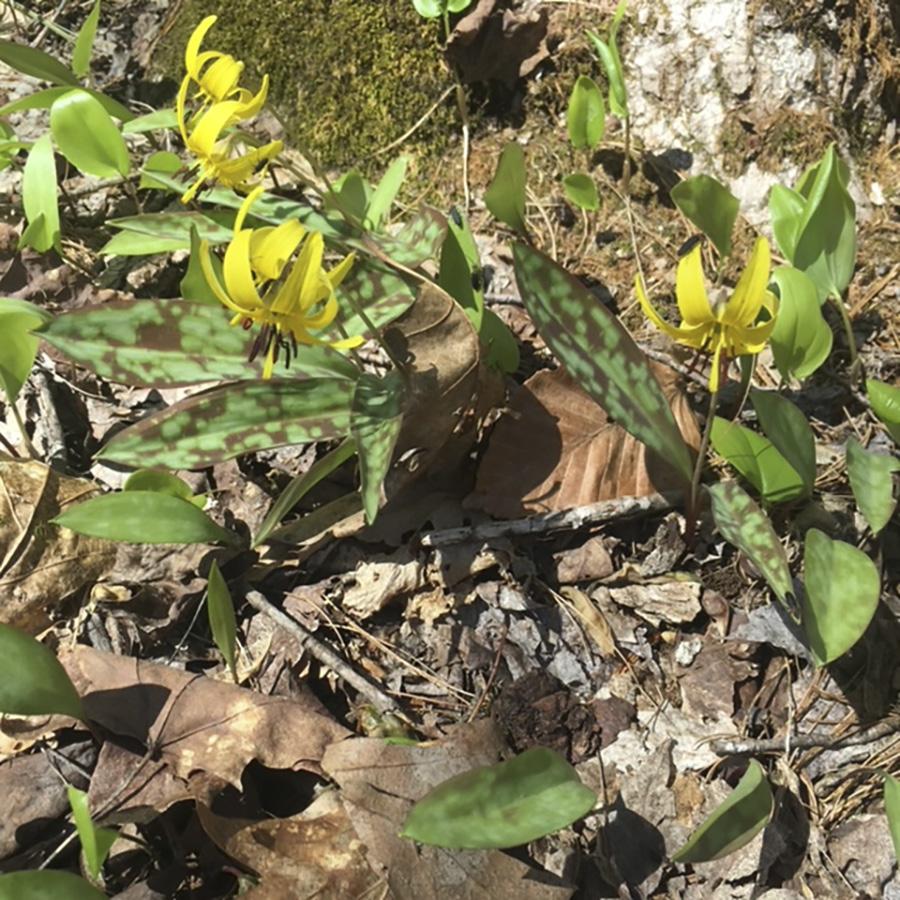
Red and painted trillium, our two common trillium species, bloom about a week apart and can be found concurrently at different elevations. Generally, red trilliums bloom first, followed in a week or less by painted trilliums. Red trilliums are sometimes referred to as stinking Benjamins for the way they attract pollinating flies to their odor, which some describe as resembling rotting meat. The smell is not strong, though, and much less offensive than rotting meat in my estimation. Painted trilliums can grow in large colonies that are stunning in appearance.


Dutchman’s breeches and their close cousin, squirrel corn, are found in rich, well-nourished soils, often at the base of springs or seeps where the naturally acidic granite soils of the area are neutralized. They are unmistakable when found on low-elevation trails. Dutchman’s breeches resemble old-fashion pantaloons hanging upside down on a clothesline, while the less common squirrel corn resembles a purple-fringed elongated heart. Squirrel corn has the wonderful smell of hyacinths. Both plants have identical deeply cut leaves resembling carrot greens.
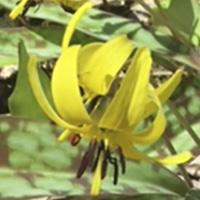
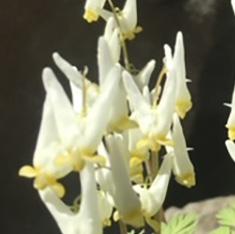
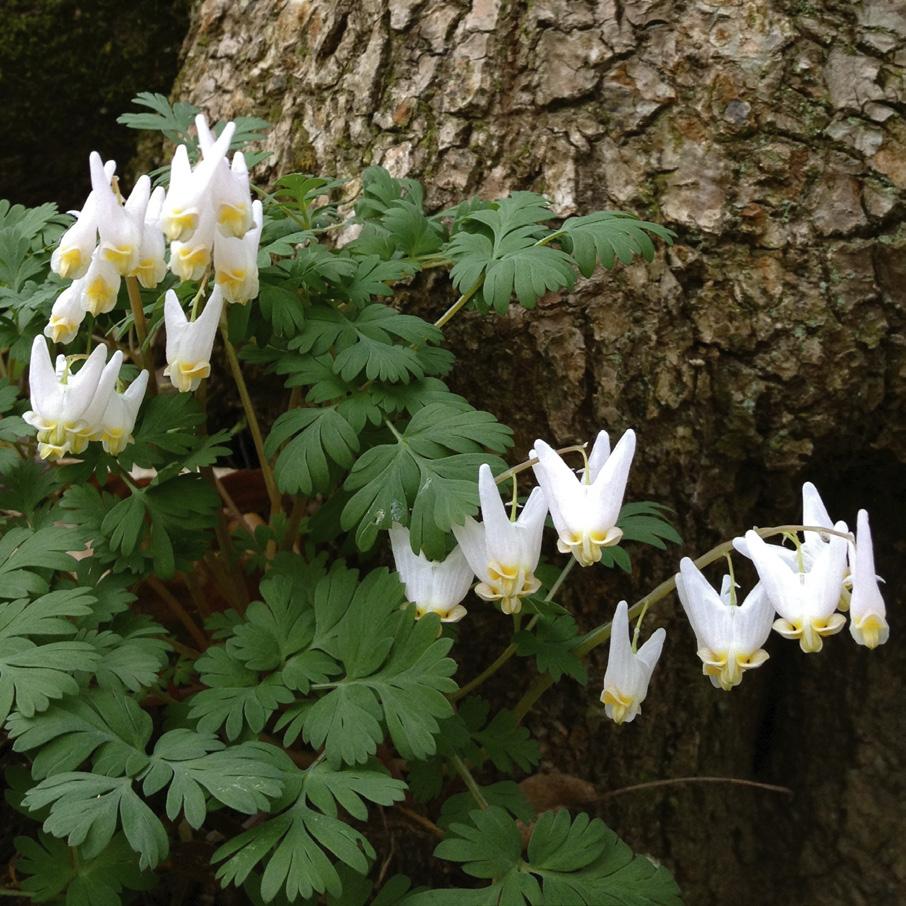

Pink lady slipper are a true orchid and bloom a bit later by the end of May or into June on mountain slopes. Their intricate design funnels insects inside the flower for pollination. These beautiful flowers will develop tiny spore-like seeds late in the summer. They do well in acid soils, so look for them amongst the needles of pine and spruce-fir forests.

Serviceberry, or shadbush, particularly loves the sunlit areas alongside mountain streams. Being a small tree, it permeates the landscape in the manner of greening leaves or fall foliage, forming white dapples along the mountain streams and on the lower slopes near cliffs. A drive through Pinkham or Crawford Notch is particularly memorable on a blue-sky day in May when the shadbush blossoms seem to float in the air.
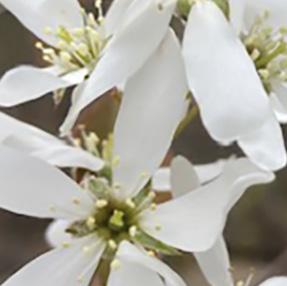
42 MWVvibe.com
Trout lilies (Erythronium americanum)
Painted Trillium (Trillium undulatum)
Dutchman’s breeches (Dicentra cucullaria)
TIN MOUNTAIN: WILD ABOUT NATURE FESTIVAL


Saturday, July 29, 10:00 a.m. -4:00 p.m.
Music @ 4 - 5:00 p.m. - Beg, Steal and Borrow

Cost: Family $50 M, $60 NM • Individual $25 M, $30 NM Concert - $15 M, $20 NM (included in price of admission)
Join the fun at this all-day festival celebrating nature! Presentations include a visit with live owls from “Eyes on Owls”, tree identification walk, wild edibles walk, mushroom identification walk, activities include owl pellet dissection, build a moose skeleton, build a bluebird nesting box and much more!

Tin Mountain Conservation Center, a non-profit environmental education and conservation organization, provides programs for children, families, adults, and communities that create a greater awareness and understanding of the natural environment. Since 1980, the center has offered hands-on programs in the schools, at summer camps, and within communities throughout northern New Hampshire and western Maine.


Spring 2023 43
Pink lady slipper (Cypripedium acaule)
McSherry’s Nursery (603) 447-5442 • McsherrysNursery.com 2599 East Main St. Center Conway, NH OPEN DAILY FOR ALL YOUR GARDENING NEEDS! •Spring Annuals •Herbs •Perennials •Trees, Shrubs •Dry Goods 10% discount for seniors and veterans Our roots grow deep in our community J & C Tree Service LLC (603) 348-7454 • www.JandCTreeService.com Affordable tree services, based in Fryeburg, Maine, servicing the Mt. Washington Valley region. • Tree Removal • Tree Pruning Professional and safe operation specializing in large tree removals
Serviceberry (Amelanchier)
 A spring day on Franconia Ridge. Photo by Lily Hartman
A spring day on Franconia Ridge. Photo by Lily Hartman
Planning Your Hike of NH’s 4,000-footers
 By Lily Hartman
By Lily Hartman
Iremember the moment when I kneeled in front of the Mount Adams summit sign for the first time. The day started with a 4 a.m. alarm ringing in my ears, and I rolled out of bed with a feeling of both uneasiness and exhilaration. A ball of fire built up inside of me as my friends and I pulled up to Appalachia Trailhead. The day was not sunny and bright as expected—clouds covered the vast sky and wind gusts howled angrily above treeline; but even so, I climbed with purpose over the daunting, rugged rocks that stick out in the alpine zone of the Presidential Range. As I approached the summit, I felt a sense of strength I had never felt before, and when I placed my hand on the sign, it hit me—I had officially climbed all 48 4,000-footers.
According to PeakVisor, experts believe that when the North American Plate made its way over the New England hotspot millions of years ago, it caused magma intrusions to form the granite, rocky terrain in New Hampshire we know today as the White Mountains. The state is home to over 48 mountains that are over 4,000 feet in elevation, and there are thousands of people who have climbed them all, according to reports by the AMC Four Thousand Footer committee.
It’s not hard to get hooked on climbing these mighty, exhilarating mountains, as they bring hikers a sense of strength and accomplishment after each hike. Hiking all 48 summits adds up to 225 miles. Not only that, hikers must climb over very difficult terrain to get to them, face thousands of feet of elevation gain on several trails, and be prepared to face unexpected, extreme weather conditions on any given day.
45
Do the Work
Matt Landry, the author of the book, Forward, Upward, Onward, where he writes about the life lessons hiking all 48 summits has taught him, says that at first, he thought, “Climbing the 48 was for other people; it wasn’t for me.” Then as he gained self-confidence, he asked himself, “You know what, why not me?”
Landry says that in order to complete the 48 list, you must put in the work and “one foot in front of the other,” and push yourself to go on those days when you are lacking motivation, because motivation is just a feeling. Once you begin hiking to each summit, eventually, the desire to keep climbing them will kick in naturally.
“The only way to get it done is to get out of bed and do it,” says Mike Cherim, the owner of Redline Guiding, who has not only finished the 48 several times (and in winter), but also the New England 67, 52-With-AView list, and other hiking lists. He advises hikers to start with tracking their hikes and enjoying one mountain at a time instead of focusing on the list right away.


Work Your Way Up
Several trails in the White Mountains require thousands of feet in elevation gain that first-time hikers may find daunting, but there are many moderate hikes on the list they can began with, such as Mt. Tecumseh trail to Mount Tecumseh, Crawford Path to Mount Pierce, Starr King and Kilkenny Ridge Trail to Mount Waumbek, and Garfield Trail to Mount Garfield.
“There are so many easier trails to learn and just get a little bit of knowledge under your belt and some miles under your shoes,” says Larry Yetter, the volunteer co-chair for the NH Chapter Excursions Committee at Appalachian Mountain Club (AMC), who has completed the 48, New England 67, and The Grid, meaning he has hiked every 4,000-footer each month of the year. He believes that it is important for hikers to gain education and experience to help ensure they hike safely as they continue on their journey.
Stay on Route
For 115 years, AMC has been releasing guide books and maps that hikers can utilize as they navigate, experience, and learn about the backcountry in the White Mountains. Hikers can buy these books and maps at The Mountain Wanderer in Lincoln, Appalachian Mountain Club Store, and Recreational Equipment, Inc.

46
WHAT TO EXPECT ON A SPRING HIKE
Being properly prepared for a hike is crucial, and what hikers bring on their journey depends on if they are day hiking or backpacking, the duration of the hike, and anticipated weather. Mike Cherim follows a “24-hour pack mentality” for day hikes, and looks at the forecast for both that day and night.
Spring is one of the most dangerous seasons to hike, says Cherim, as there are several risk factors that occur from melting snow and warming temperatures. Cherim’s water-crossing article on page 60 goes into detail on how to safely cross high-flowing water during spring. What to look out for when hiking in the spring:
Rising waters
Melting snow and rain cause water to rise, even more so as the day heats up. There are several trails in the White Mountains where hikers will encounter river crossings.
Snow bridges
These arcs form in creeks, rock cracks, and other terrain openings. As the season warms up, the snow gets soft, making these dangerous to step on since they could cave in.

Postholing
When the sun is beating down and the air gets warmer, snow will soften and hikers not wearing snowshoes in these conditions will likely plunge knee-to-waist deep into the snow, which may cause injury.
Ice chunks and rocks
Ice can widen cracks and split rocks. As the snow melts, there is a risk of these falling on hikers’ heads, especially on steep trails.
Winter weather and conditions
Mount Washington in April has an average temperature of 23.7 degrees and receives 33.1 inches of ice, hail, and snow; in May it has an average temperature of 36.3 degrees and receives 12.9 inches of ice, hail, and snow, according to the Mount Washington Observatory (MWOBS). Hikers should always check the weather and be prepared for winter conditions.
Ticks

Ticks carry diseases such as anaplasmosis, babesiosis, and lyme disease. Hikers can protect themselves by tucking their pants into their socks, and wearing light clothing and bug spray, such as permethrin or DEET.
Over
20
owned & operated restaurants


locally
Almost There
Albany • 603-447-2325
Barley & Salt
N. Conway • 603-356-1037

Black Cap Grille
N. Conway • 603-356-2225
Cafe Noche
Conway • 603-447-5050
Chef’s Bistro
N. Conway • 603-356-4747
Christmas Farm Inn
Jackson • 603-383-4313
Deacon Street
N. Conway • 603-356-9231
Delaney’s Hole
In The Wall
N. Conway • 603-356-7776
Horsefeathers
N. Conway • 603-356-6862
Joseph’s Spaghetti Shed

Glen • 603-383-6680
J-Town Deli & Country Store
Jackson • 603-383-8064
Max’s Restaurant & Pub at Snowvillage Inn
Eaton • 603-447-2818
Merlino’s Steakhouse
N. Conway • 603-356-6006
Moat Mountain
Smokehouse
N. Conway • 603-356-6381
Notchland Inn
Hart’s Location • 603-374-6131
Oxford House Inn
Fryeburg • 207-935-3442
Priscilla’s
North Conway • 603-356-0401
Red Parka
Steakhouse & Pub
Glen • 603-383-4344
Shalimar Of India
North Conway • 603-356-0123
Shannon Door Pub
Jackson • 603-383-4211
The Shovel Handle Pub
Jackson • 800-677-5737
Thompson House Eatery
Jackson • 603-383-9341
White Mountain Cider Co.
Glen • 603-383-9061
Wildcat Tavern Jackson • 603-383-4245
302 West Smokehouse & Tavern
Fryeburg • 207-935-3021
Spring 2023 47
★ The Valley Originals is a 501 (c)3 Non-Profit Organization ★
PHILANTHROPY WITH A TASTY TWIST
LEFT TOP: A group of friends, who met in Hiking Buddies NH 48, on Mount Madison at sunrise. LEFT CENTER: Franconia Ridge in Spring 2022. LEFT: A group from Hiking Buddies NH 48 heading down to Madison Spring Hut after summiting Mount Adams in April 2022.
Photos by Lily Hartman.
TRIP REPORTS & TRAIL CONDITIONS
The following sites typically provide essential trail conditions. TrailsNH.com: Collects just about every hiking trip report, trail advisory, and forest road closing in the Northeast. By following hiker blogs and hiking forums, TrailsNH helps you access the most current trip planning information anywhere.
NewEnglandTrailConditions.com/NH: A good collection of the most recent user-provided trail condition posts.
ViewsFromTheTop.com: New England backcountry and hiking forum.
FORECASTS & WEATHER CONDITIONS
Mountain weather is subject to rapid changes and extreme conditions. Typical weather apps are simply not designed to accurately predict the changing weather found below and above treeline. Always travel with adequate clothing, shelter, food, and water, and be prepared to make your own assessment of travel and weather conditions. When in doubt, turn around.
www.mountwashington.org: Mount Washington Observatory, Mount Washington and Higher Summits Forecast.

Mountain-Forecast.com: Dedicated mountain weather forecasts for major summits for climbers and mountaineers.
Forecast.weather.gov: NWS Recreational Weather Forecast specific to White Mountain higher elevations.
(REI). Several hikers also like to use apps, such as AllTrails, Gaia GPS, and Strava to navigate, although it is still important to carry a map and compass, which hikers can learn how to use at local organizations such as AMC, Redline Guiding, Northeast Mountaineering (NEM), and REI.
Even though Cormac Griffin, the sales lead at REI in North Conway, has completed the White Mountains Tracing, meaning he has hiked every single trail

Edition), hikers will find six topographic maps, trip-planning advice and safety, information on more than 500 trails and all 48 4,000-footers—along with information regarding any springs or accommodations along the way, such as lodges, campsites, shelters, shuttles, or huts. Cherim believes that the driving time and overall time commitment required to hike the 4,000-footers is what keeps hikers from completing the list, so staying at a
Andrew Barlow, the moderator of the group whose hiked all 48 4,000-footers twice, explains how hiking buddies is a great way to stay safe, socialize on your hike, and learn from other hikers’ experience and knowledge, and about other hikes on the list. The group is very welcoming, as there are several beginner-friendly, slow-pace hikes posted in the group for first-time hikers.
in the AMC White Mountain Guide, he still carries a map on every hike. He says that beyond water and food, navigation is the most important hiking essential. “The White Mountains are amazingly well marked; we have great signage and trail junctions,” says Griffin. “You’re usually not too far from a road, but that doesn’t mean you can’t get lost.”
In AMC’s White Mountain Guide (31st
local accommodation is a great way to save time or break up longer stays, such as when hikers face the Zealand Bonds Traverse, which are the furthest peaks from any road.
Find Your People
Yetter says that staying at huts, owned by organizations such as AMC or Randolph Mountain Club (RMC), is a great way
48
Photo from Redline Guiding
WiseguyCreative.com
photo
PLENTY OF HIKING BUDDIES
When hikers get out on a group hike, they’ll quickly find support, amazing friendships, and comfort in the mountains, as well as a desire to keep hiking since they’ll have others encouraging them to get out there. Having this support system not only allows hikers to encourage one another and share accomplishments, it is also much safer to hike in a group and it increases accountability, which is important to have on the trails.
Here are a few organizations where individuals can join group hikes:
Hiking Buddies NH 48: Join this Facebook hiking group where members can organize and post hikes in the events page and other members can sign up for the hikes listed. The experience level for each hike varies, but often range from beginner-friendly, short hikes all the way to a single-day Presidential Traverses and Pemi Loops. Request to join the Facebook group here: www.facebook.com/groups/956560951448114.
Appalachian Mountain Club (AMC): Join a volunteer trip leader on a guided group hike to various 4,000-footers and other summits. All guided hikes are posted at: www.activities.outdoors.org/search.
NH Women’s Hiking Group: Join this women-only hiking group where members can plan meetups to hike, seek out advice, and share photos and stories of hikes they have done. Request to join the Facebook group here: www.facebook.com/ groups/352206261595821

Redline Guiding:

Join an expert guide on a half-, full-, or extended-day hike up to a 52 With-A-View or 4,000-footer. View prices and more information for each hike at: www.redlineguiding.com/ adventures/hiking
Northeast Mountaineering: Join a professional mountain guide on a hike up to one or more 4,000-footers. View prices and more information for each hike at: www.nemountaineering.com/climbs/ 4000-footers-and-more.
Spring 2023 49
ABOVE LEFT: A hiker heads up the Willey Range Trail. LEFT: The view just below the summit of Mount Washington crossing through the alpine garden. Trampling and disturbance of alpine vegetation are most commonly seen in these high-traffic areas. It is imperative that hikers remain on the trails especially throughout the alpine garden.
to connect, learn from, and become friends with like-minded individuals on the trails. Having this support system allows hikers to encourage one another and share accomplishments. It is also much safer to hike with a group and it increases accountability. “To have that shared experience is incredibly meaningful; that’s what bonds people together,” says Landry.
A line that stood out to me in Forward, Upward, Onward was on page 28. Landry wrote, “We all have a tribe of people we can turn to, so we can feel validated, loved and accepted. Have you found yours? If not, are you actively looking for one?” When reading this line, I thought of the Facebook hiking group I found two years ago, Hiking Buddies NH 48, where I met life-long friends and companions who I still hike with regularly. The group was created in June 2020 by Benjamin Pease, and has grown to more than 16,000 new-to-experienced members looking for people to hike and finish their 48 with.
Andrew Barlow, the moderator of the group whose hiked all 48 4,000-footers twice, explains how hiking buddies is a great way to stay
safe, socialize on your hike, and learn from other hikers’ experience and knowledge, and about other hikes on the list. The group is very welcoming, as there are several beginner-friendly, slow-pace hikes posted in the group for first-time hikers.


Barlow says, “The biggest reason why people might join the group but never go on a hike is that they’re terrified that they’ll be too slow.” In fact, once hikers get out on a buddy hike, they’ll quickly find support, amazing friendships, and comfort in the mountains, as well as a desire to keep hiking them since they’ll have others encouraging them to get out there with a group.
“It is completely motivational; you learn a lot through buddies. It teaches you the ins and outs; it’s a companion, so it’s safe,” says Julie Saccardo, an admin of the group. On Saccardo’s first buddy hike on Mount Hancock and Mount Hancock, South Peak, she felt like she wasn’t going to be able to make it to the summit, but Pease kept telling her to just get to the next tree mark— one section at a time, pushing onward. She not only made it to the top that day, but also on every other 4,000-footer.
Breton McKenzie, store manager at REI in North Conway, explains how an REI membership, which costs just $30 for life, can support hikers on their 48 journey. REI members can buy and trade gear, receive free shipping, get a discount on rentals, and receive a year-long satisfaction guarantee, meaning if a piece of gear does not work for them, they have an entire year to exchange or return it. In addition, members get 10 percent back on eligible purchases.
• The 10 essentials: a knife or multitool, navigation, emergency shelter, first aid kit, extra layers, extra water, extra food, a headlamp with extra batteries, sun protection, and a fire starter
• A 21- to 35-liter day pack
• A water filter or tablets for water treatment
• A form of electrolytes, such as salt sticks, Nuun tablets, or energy gels
50 MWVvibe.com FUEL YOUR ADVENTURE NORTH CONWAY HOUSE OF JERKY 2 STORES IN NORTH CONWAY North Conway Village 2730 White Mntn Hwy (603) 730-5474 Settlers Green 2 Common Court - Unit D46 (603) 730-5515 THE LARGEST SELECTION OF JERKY IN THE REGION! • Beef Jerky • Turkey Jerky • Exotic & Game Jerky NorthConwayHouseofJerky.com ESSENTIALS FOR DAY HIKING AND BACK -
IN BOTH
PACKING
SPRING AND SUMMER CONDITIONS:
• Rain gear (pants and a jacket)
• A soft-shell jacket for insulation
• A hard-shell jacket to break the wind
• A whistle

• Bug spray for ticks, mosquitos, and black flies
• A gear repair kit
• Trekking poles
• Wet wipes
• Waterproof, mid-to-full-size boots (in the spring) or trail runners
• High gaiters (in the spring)
• Spikes (in the spring, when there is still melting snow)
• Snowshoes (in the spring, for trail sections where the snow is soft)
• Also good to have: a Garmin, handkerchief, a hat, and sunglasses
• For backpacking: a tent, sleeping pad, sleeping bag, and pillow that are packable, a stove, fuel, and cooking utensils, backpacking meals or food that won’t go bad, hygiene essentials, a 30- to 50-liter pack for 1–3 day trips and 50- to 80-liter pack for 3–5 day trips, and all of the items above.
Hikers can track the 48 with the AMC Four Thousand Footer Committee application, which they have to submit with an essay and pay a $15 application fee, after they have completed the list, in order to receive their patch and an invite to the Annual Meeting, Awards & Dinner event.

Affordable, Luxurious Rooms & Suites | Touchless Check-Ins/Check-Outs
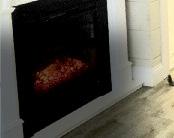




Outside Access To All Rooms | Dog Friendly | “Be Safe” Cleaning Protocols

Fire Pit, Picnic, BBQ Areas & Open Spaces | Cross-Country Trails On-Site Minutes To Trails, Parks, Story Land, Tubing, Canoeing, Shopping & More

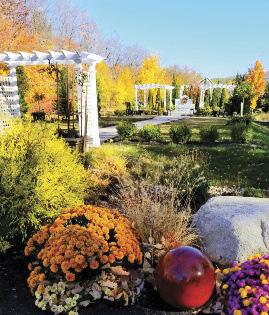
603-356-3551 | StarlightLodgeHotels.com
3537 White Mountain Highway | North Conway, NH

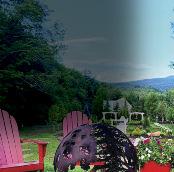


Spring 2023 51 J ULY 15 Meet at Great Glen Trails HIKE-A-THON Earn gear & support the Obs! OUR LARGEST ANNUAL FUNDRAISER
SEEKTHEPEAK.ORG Match up with
of
at Match
with
of
at
SEEKTHEPEAK.ORG
hikers
similarDetailsability.
up
hikers
similarDetailsability.
S T A R L I G H T L O D G E STARLIGHT LODGE N O R T H C O N W AY ORTH CONWAY
A Hi d d e n G e m I n T h e W h it e M o u nt a i n s VibeSpring2023_Layout 1 3/17/23 10:48 AM Page 1
Believe and Achieve
Landry also writes in Forward, Upward, Onward, “Don’t be afraid to endure discomfort sometimes. The rewards are far greater in the end for those who do.” Hiking is often an uncomfortable activity, especially on days when you feel tired or get in your head about how many miles you have left to go, but finding the mental fortitude to keep pushing toward each mountain builds character.
Griffin’s allure to these mountains was the unknown of exploring different places, as well as the challenge. He explains
NEW HAMPSHIRE 4,000-FOOTERS

The state of New Hampshire has 48 4,000-footer mountains (mostly in the White Mountains) listed below in order of highest elevation to lowest elevation.

A 4,000-footer is a mountain that has an elevation of at least 4,000 feet and a minimum of 200 feet prominence. All criteria is determined by the Appalachian Mountain Club (AMC).

# Mountain Elevation Prominence
1 Washington 6288’ 6138’
2 Adams 5774’ 804’
3 Jefferson 5712’ 742’

4 Monroe 5384’ 254’
how the physical and mental benefits of hiking these mountains becomes addictive. “You have a sense of accomplishment that is really hard to describe for people that haven’t climbed those mountains,” he says.
Every year, AMC holds an Annual Meeting, Awards & Dinner event where those who have completed the 48 list get together to receive an award and patch, which Yetter says is a great emotional high. When Landry went to this ceremony, he realized that he wasn’t alone on his journey; that many other hikers like himself are out there to face fears and problems head on, find closure and answers, and to self-conquer. He says that at the end of it all, you’ll get this realization that you’re a lot bigger than you thought you were.
52 MWVvibe.com
david@fishstreetdesign.com (207) 697-2277 • Fish St., Fryeburg, ME www.FishStreetDesign.com
5 Madison 5367’ 466’ 6 Lafayette 5260’ 3320’ 7 Lincoln 5089’ 180’ 8 South Twin 4902’ 1522’ 9 Carter Dome 4832’ 2830’ 10 Moosilauke 4802’ 2933’ 11 Eisenhower 4780’ 350’ 12 North Twin 4761’ 299’ 13 Carrigain 4700’ 2240’ 14 Bond 4698’ 299’ 15 Middle Carter 4610’ 720’ 16 West Bond 4540’ 299’ 17 Garfield 4500’ 820’ 18 Liberty 4459’ 379’ 19 South Carter 4430’ 230’ 20 Wildcat, A peak 4422’ 1034’ 21 Hancock 4420’ 1247’ 22 South Kinsman 4358’ 2240’ 23 Field 4340’ 1706’ 24 Osceola 4340’ 200’ 25 Flume 4328’ 408’ 26 South Hancock 4319’ 1247’ 27 Pierce 4310’ 235’ 28 North Kinsman 4293’ 2240’ 29 Willey 4285’ 256’ 30 Bondcliff 4265’ 299’ 31 Zealand 4260’ 246’ 32 North Tripyramid 4180’ 1320’ 33 Cabot 4170’ 2674’ 34 East Osceola 4156’ 316’ 35 Middle Tripyramid 4140’ 1320’ 36 Cannon 4100’ 740’ 37 Hale 4054’ 614’ 38 Jackson 4052’ 331’ 39 Tom 4051’ 331’ 40 Wildcat, D Peak 4050’ 1034’ 41 Moriah 4049’ 922’ 42 Passaconaway 4043’ 803’ 43 Owl’s Head 4025’ 825’ 44 Galehead 4024’ 264’ 45 Whiteface 4020’ 591’ 46 Waumbek 4006’ 1289’ 47 Isolation 4004’ 203’ 48 Tecumseh 4003’ 1739’ Printable list: www.4000footers.com/list_nh48_print.shtml
“Don’t be afraid to endure discomfort sometimes. The rewards are far greater in the end for those who do.”






GRE AT RAIL ADVENTURES thecog.com on mount washington all year long!
Is Your Dog Big-Hike-Ready?
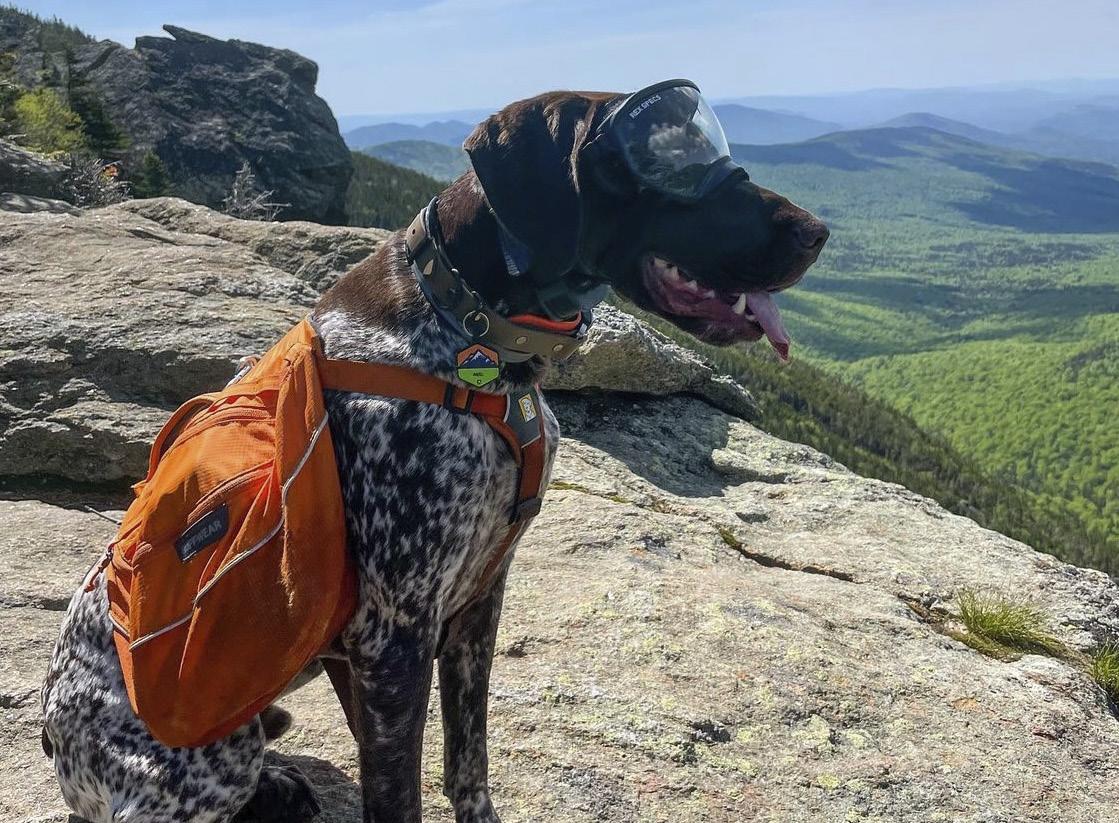 By Dr. Cheryl Cullion
By Dr. Cheryl Cullion
Hiking in the White Mountains is a strenuous affair. Being in good physical condition will make the experience more enjoyable and can help avoid muscle soreness. There are those who don’t mind winter’s frigid weather, donning snowshoes to enjoy winter’s beauty. Many of us, however, would prefer to spend the colder months sitting by a fire with man’s best friend at our feet.
Fast forward, and the ground has thawed—it’s time to get off that couch and get those feeble hiking legs in shape. Perhaps you have a routine, maybe walking up several flight of stairs daily, but what about your four-legged fellow adventurer? Is there something she should be doing to prepare? If you subscribe to the adage that each year in a dog’s life is equivalent to seven years of a human’s (which is not quite accurate), your furred friend has not been hiking for at least four years, and yet we expect her to hit the trail in peak condition. Dogs, like humans, need to condition for the rigors of hiking.
First, you should evaluate whether trudging up steep trails is appropriate for your dog. Puppies should avoid long hikes until all of their growth plates are closed (which can take up to 18
months). Although you may be eager to introduce your puppy to the joys of hiking, resisting such temptations may allow your companion to enjoy their hiking career much longer in their later years. Breeds with shortened snouts may be more challenged by the summer heat or hiking’s respiratory demands, and the hike should be tailored to their needs. Geriatric dogs may have aging issues, which may make what they were once able to do no longer feasible. We certainly don’t want our canine companions to miss out on our adventures, but we may need to make some compromises. Dogs should have an exam by their veterinarian prior to hiking to make certain they are ready for the trails. Updating vaccines, such as Leptospirosis and Lyme, might be worth considering, as is using flea and tick prevention.
So, what does conditioning for your dog include? Let’s start with endurance. It is important to start slow and easy, at least until you can assess what kind of shape your furred friend is in. Always start any kind of strenuous walk or hike with a 15- to 20-minute warm-up, think of it as a sniff and stroll to prepare the muscles for a more intense activity. Once the muscles are warmed up, try a 10- to 15-minute fast-paced walk with no sniffing or
54 MWVvibe.com
Whether this is the year for some big hikes with the family dog, or you’re excited to hit the trail with your new hiking companion, dogs, like humans, need to condition and be prepared for the rigors of hiking.
LEFT: Three-year-old German shorthaired pointer, Abel, is currently working on his fourth round of the NH48. Sporting goggles from Rex Specs and a pack from Ruffwear, Abel is also attempting the NH Grid (a peak-bagging list in the White Mountains where hikers climb each of the 48 White Mountain 4,000-footers each month of the year, requiring 12 x 48 = 576 summits to finish). Abel, @Abel_the_GSP, is a local Instagram sensation with over 4,000 followers and growing.
pee-mail. After the walk, a five-minute cool down of slow walking on flat terrain will help remove any accumulated waste and allow tired muscles to recover. Over the next five weeks, gradually increase the length and intensity of the walk while varying the terrain. Monitor how your dog does





Puppies should avoid long hikes until all of their growth plates are closed (which can take up to 18 months). Although you may be eager to introduce your puppy to the joys of hiking, resisting such temptations may allow your companion to enjoy their hiking career much longer in their later years.

the following day after a walk, is she still excited about the walk or does she want to remain curled up in her bed. If she chooses her bed, you may want to cut back on the difficulty of your walk
Even strength conditioning can be beneficial for hiking dogs. Strong and powerful muscles are not only important for ascending the mountain, but also assist with a controlled descent where it is easy for an injury to occur. Sasha Foster’s e-book Hike Dog! Exercises & Stretching to Go Higher (available on Dogwise.com), is an excellent reference for both strengthening and stretching your dog.
Despite your dogged preparation, it may be wise for both of you to elect an initial hike that is less arduous than when you were both in peak condition. Consider it a shakedown hike. Signs of fatigue that may indicate that your dog is having a difficult time are: a lowered head or tail, averted or glazed eyes, refusing treats, muscle trembling, a long tongue with a wide tip, slowing down, or refusing to move. These signs should be taken seriously, and you should stop and rest, and consider heading back down the trail.
Once you are confident that you are both in reasonable shape, it’s time to hit the more challenging trails. While on the trail it is critical that you and your dog are well-hydrated and take frequent breaks, particularly for older dogs or on hot days. Remember that dogs only sweat through their pads, and they cool their bodies through panting, so overheating is easy to do. And, again, cool-down walks are important.
Like yourself, you may want to consider stretching your canine partner. Many dogs will often stretch on their own; think of a downward dog position. If you observe your dog independently stretching you may want to encourage this behavior, rewarding it each time with a tasty treat. There are also what are referred to as static stretches, such as a hamstring stretch runners often do. Stretching your dog remains controversial, as dogs at least verbally, are unable
Spring 2023 55
Almost There Sports Tavern & Restaurant (603) 447-2325 • 1287 Route 16, Albany, NH Just south of the Kancamagus Highway Where Life is Good! OPEN EVERY DAY, BUT WEDNESDAYS, FROM 11:30AM PLEASE CHECK FOR OUR DAILY SPECIALS (603) 356-6031 179 Route 16/302, Intervale, NH Tile •
Vinyl • Hardwood • Carpet • Area Rugs Largest Flooring and Tile Showroom in the Mt. Washington Valley SHOWROOM HOURS: Monday-Friday: 7:30am-5pm Saturday: 9am-1pm (Closed Saturdays during July & August) Full design and installation available on everything we sell!
Luxury
PROTECTING YOUR PUP ON A HIKE

Dehydration
Dogs can become dehydrated when they lose more water and electrolytes than they take in, either through excessive sweating or panting. Signs of dehydration in dogs include dry mouth and gums, sunken eyes, lethargy, loss of appetite, and dark yellow or orange urine. Dogs require anywhere from ½ oz to 1 oz per pound of body weight. This figure varies on the amount of exercise your dog gets, so hiking dogs will need plenty of water.
Watch Out for Foxtails! Foxtails are a type of grass

seed that can be dangerous for dogs during hikes and outdoor activities. The seeds can become lodged in a dog’s fur, paws, or ears, and can cause a range of health problems, including infections and abscesses. Signs include excessive licking or chewing, pawing at their ears, or shaking their head. It’s best to stay on trails that have been cleared and walk in areas absent of tall grasses. If foxtails get on your dog, take the time to locate all the spiky seed structures that have attached themselves. Use tweezers to remove them or even a finetooth comb.
GOOD TO HAVE ON A HIKE
Emergency Rescue Harness for Dogs
The Pack-a-Paw rescue harness is a unique lift that allows you to carry your injured dog securely and comfortably on your back. The harness is lightweight and compact, designed for hikers to carry with them anywhere they take their canine. With the Pack-aPaw, you’ll never have to worry about your dog’s well-being on a hike.
Available at Mountain Dogware @mountaindogware www.mountaindogware.com
Bee Stings
If your dog is stung by a bee, the first step is to remove the stinger as soon as possible. You can use a credit card or the edge of a knife to gently scrape the stinger out, being careful not to squeeze it as this can release more venom. Then clean the area with soap and water and apply a cold compress or ice pack to reduce swelling. Keep an eye on your dog for signs of a severe allergic reaction, such as difficulty breathing or swelling in the face or throat. If these symptoms occur, seek emergency veterinary care immediately. You can


Leak-Tight Dog Water Bottle
Dogs need water on the trail just as we do. Simply squeeze the AutoDogMug® LeakTight and water fills the bowl for your pup to drink, release, and the remaining water returns to the bottle, not wasting a drop. It is available in three sizes and comes with a carabiner that can attach to a pack or your belt loop.

Available at Four Your Paws Only @fouryourpawsonly www.fouryourpawsonly.com
to say “Stop, that hurts,” potentially doing harm if the stretch is too aggressive. If you are interested in stretching your pup, it should never be painful and should be performed after the dog is already warmed up. (See Sasha Foster’s Book.)
Finally, what dog wouldn’t welcome a massage after a long day’s hike. Massage is not just a quick pet, but a focused, gentle stroking or kneading of the muscles worked during the hike. Massage helps relax the muscles and removes built-up toxins. It’s also a great bonding experience. Or better yet, treat both yourself and your dog to a massage with a professional masseuse. You both deserve one after all your hard work.
also give your dog a dose of Benadryl (diphenhydramine) to help relieve symptoms, but be sure to consult with your veterinarian first to determine the correct dosage for your dog’s weight.
Are Human First-Aid Kits Sharable with Dogs?

Be aware that certain medications, such as pain relievers or allergy medications safe for humans, can be harmful to dogs. Bug spray and sunscreen formulated for human use may contain ingredients toxic to dogs if ingested or absorbed through the skin. Always consult your vet.
Dog First Aid Trail Kit
The Adventure Medical Trail Dog First Aid Kit is uniquely designed with hiking dogs in mind. The kit includes numerous medical solutions and tools you need to address the types of injuries dogs encounter most on the trail, primarily to their paws. The assortment of dressings, bandages, and tools can help you be prepared when hiking accidents happen.
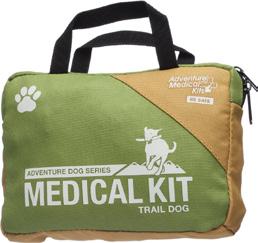
Available at Chewy @chewy www.chewy.com
Dr. Cheryl Cullion is certified in veterinary rehab and acupuncture. Her practice “Best Life Canine Rehab and Acupuncture” in Center Conway, provides caring and skillful rehab treatments, similar to those employed in physical therapy, to help dogs obtain their highest level of function and quality of life possible.
For more information, visit www.bestlifek9rehab.com, or call Best Life Canine Rehab at (603) 986-3768.

56 MWVvibe.com










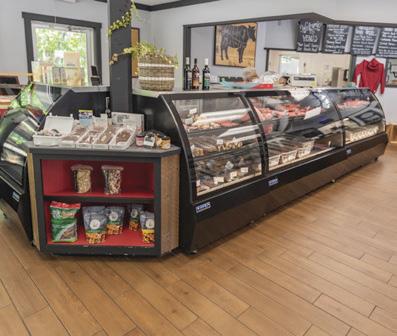





WHITE MOUNTAIN INDEPENDENTS WhiteMountainIndependents.com For charm, service, & distinctive products, we invite you to SHOP THE BLUE FLAGS in support of our small, locally-owned retailers! North Conway Village (603) 733-5144 • ItsMyGirlfriends.com Located in the Eastern Slope Inn No Soot, No Toxins, Burn Longer, Cost Less North Conway Village (603) 986-8969 • Soyfire.com 20% Off Fragrance of the Month Open Daily 10-5 (603) 356-3854 Est 1992 (603)356-3200 • WhiteBirchBooks.com Open Daily 10am-5pm BOOKS • CARDS • GIFTS Just south of North Conway Village Visit our store to pick up quick meals or to experience restaurant-quality food at home! VenosNH.com (603) 662-0615 715 White Mountain Hwy, Conway, NH SPECIALTY FOODS & MEATS
TO CROSS OR NOT TO CROSS: Springtime
Water-Crossing Tips
By Mike Cherim, Redline Guiding
It’s getting to be that time of year: spring, a whole new season of hazards to contend with. A time of year when staying dry is a real challenge, thanks to all the various forms of water out there. And crossings … oh, my. That ice-cold and sometimes turbid spring snow melt rushing toward the sea—standing between us and our next 4,000-footer or 52 WithA-View peak. It’s on this last point that we are going to focus: “water crossings.” To be clear, we mean crossing rivers and streams. Here are some water-crossing considerations. Some “pro tips.”
1. Icy Rock Hazards
Watch for spring ice when rock-hopping. A film of gin-clear “black ice” can form on otherwise good rocks to cross on. Knowing the science of rock-hopping helps, but use light traction and trekking poles to better the odds of success.

2. Again, Use Trekking Poles
As noted above, crossing rivers in this season requires good balance. Even when using other methods such as fording. Trekking poles will help, though you need to keep your hands free for them. Securely pack your boots, if applicable, instead of carrying them in your hands.
3. Varying Water Levels
Water levels are usually lower in the morning. Go then. If it’s questionable in the morning, and you’re returning the same way, know that it’ll likely worsen due to solar gain and snow melt as the day wears on. Try to imagine this ahead of time.
4. Weakening Snow Bridges
Natural snow bridges are usually firmer in the morning. Go then. If relying on a snow bridge, try to imagine crossing the
58 MWVvibe.com
Photo by Lily Hartman
same water body without it. It could disappear later in the day, trapping you on the wrong side. Crossing snow bridges on skis or snowshoes is advisable to spread out the load.
5. Rain Danger
Spring rains worsen the problem. Making a spring crossing when it’s raining, especially when coupled with spring snowmelt, is dangerous. The levels can quickly become unsafe: as a rule, water rushing above the knees should be avoided.
6. If Wading Through
The water will be like ice. The crossing must be quick—and it will likely be very painful. Plan well so you can dry yourself and change back into dry socks and boots on the other side. Know fording methods like facing into the flow or using your team.
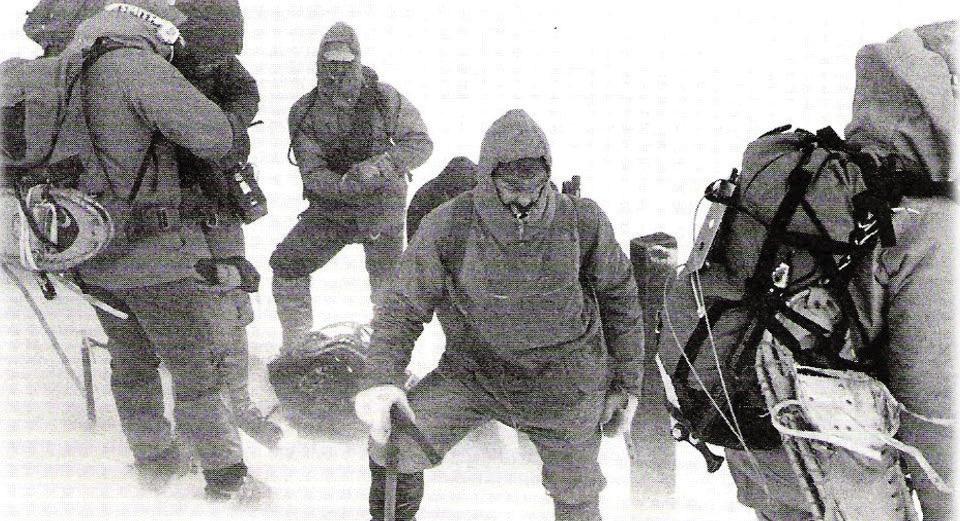
7. Packs Are Death Jackets
If one falls while wearing a pack on their back, they will land or immediately turn to the face-down position if the water is deep enough. Unbuckling the hip belt and sternum strap in advance will help with escaping this. Do note, however, this may affect balance. This must also be considered.

8. What Lies Downstream
Downstream hazards like an ice shelf covering the water creating a void could be a place of entrapment if one slips and washes downstream. Think about this before making that crossing. Entrapment is a deadly horror to avoid.
9. Staying Dry’s in the Bag?
Using bags will yield varying results, at least that is our take, but some do swear by wearing plastic trash compactor bags over their feet and taping them in place like boots to go hands-free. But you might want to tread lightly in stocking feet.
10. Trying Other Methods
Dry and wetsuit booties, puke bags and Crocs, rubber boots, or hip- or chest-waders. All are options, but they introduce the danger of filling with water if one falls while wearing such items. Know the dangers! Plus, they can be heavy/bulky.
11. Other Bodies of Water
If it’s actually a pond, go around. We
mean this in jest, hoping to elicit a smile … but we’re only halfway kidding. The serious message is to avoid the outflow end of the pond, as this area will be potentially wetter. And don’t cross the ice. And, now, to nag …
12. Don’t Cross the Ice
In the spring, ice is best avoided, both ponds and streams. If one does have to cross river ice, ensure all eyes on them for safety, and maybe belay them with rope. Also, try to distribute the weight over the widest area possible with skis or snowshoes.
And
of Course, There’s Always this Option to Consider: Don’t Do It!
Sometimes the best answer is to try another time. A time when it’s dry, when it’s easy, and not so dangerous. A time when water levels and flow rates are ebbing and not flooding.
Hikers in the know comprehend and often repeat the phrase that suggests the mountain will always be there for another day—but, that deadly torrent of water between them and their goals won’t be. In some cases, it will dissipate and reduce in as little as a few hours. Most of the time, common sense will tell us when it’s appropriate to try, but if you’re new to hiking, if you lack this experience and just aren’t sure, do some research online or pick up a book or map, and avoid trails with significant crossings.
And in the spring, know that even small, normally innocuous hops across a tiny trickle can end up being so much more—so wait on those, too. Like the mountain, your goals and the trails will be there for another day. The floods, not so much.
Courses include Wilderness First Responder, EMT, Wilderness EMT, Advanced EMT, Wilderness Medicine Bridge Course, Wilderness First Aid, and more.
Mike Cherim is the founder and owner of Redline Guiding located in Intervale. His company offers myriad activities from hiking and snowshoeing—the core activities they passionately began with—to more extreme offerings, such as mountaineering, backcountry skiing, and rock and ice climbing. Redline Guiding also offers several educational offerings, such as wilderness navigation, and Mike, being a NH JP, also officiates mountain weddings. To learn more, visit www.RedlineGuiding. com. To learn more about water crossings, contact Redline Guiding.

Spring 2023 59
WILD & RESCUE MEDICINE From people who have done what they teach
thekaneschools@gmail.com THEKANESCHOOLS.COM • Over 500 Craft Beers • Make Your Own 6-Pack • Just South of Storyland 779 ROUTE 16, GLEN, NH (603) 383-4800 Come by to say hi to BOOMER!
RIDING THE VALLEY A LOOK TO 2023
The Mt. Washington Valley has been an adventure destination for a very long time. Skiing, hiking, rock and ice-climbing, paddling, cycling, and fishing … a seemingly never-ending list helping to validate its many “best-of” adventure-based recognitions. It’s not surprising that mountain biking has been a popular pastime since its beginning days in the 80s and 90s. But within the past decade, and more so the past few years, mountain biking in the region has soared in popularity, thanks to a healthy mix of nonprofits, organized clubs, and private trail builders. From North Conway west to Bethlehem and north to Gorham, these rugged mountain towns have dedicated individuals and groups stepping up to organize and build a true mountain bike destination. Whether you’re in the mood for some natural single-track with roly-poly downhills; steep technical drops over slabs; or more aggressive, roller-coaster, machine-built trails with purpose, a vast variety of networks are popping up for all skill levels and abilities throughout the region. At the heart of these networks, you’ll find dedicated groups of volunteers working together with various organizations to create a community of riding opportunities for everyone. Read on to hear what some of these groups have planned for the upcoming season. From weekly rides and trail maintenance days to more complex projects and annual fundraisers, there are plenty of ways to become involved and join the healthy cycling community around you.
RIDE NOCO
, by Amanda Schweizer
Ride NoCo was founded in 2020 and aims to promote positive, progressive growth to make the Mt. Washington Valley a world-class mountain bike community. The organization serves as the primary trail stewards of the Hurricane Zone Network and Half Day Trail, the Valley’s most advanced downhill-specific trails. The Hurricane Zone is truly a unique trail system, boasting nearly 8,000 feet of vertical descent over 19 miles of trail. Ride NoCo’s biggest project to date, Tornado, was opened in spring of 2022, built by local trail builder, Corbett Tulip of Tulip Trails. As a berm-filled machine-built intermediate flow trail, Tornado is a great balance to the natural hand-built trails typical of the rest of the network. Instead of taking the Winter 2023 season off, Ride NoCo successfully maintained a groomed, snowy downhill track to give adventurous fatbikers the incredible opportunity
to descend roughly 1,000 vertical feet.
This season, Ride NoCo is focusing its efforts on restoring Half Day, an exciting descent off of Mt. Washington Valley’s iconic Cathedral Ledge. Half Day was originally a rogue trail that was adopted by the mountain biking community, and as such, it was not built with sustainability in mind. While the existing trail is beloved, it cannot remain open in its current state, as it does not meet the sustainability and safety standards of the landowners, the White Mountain National Forest Service. While the majority of the upper half of the trail will remain as is, the lower half will be rebuilt by hand under the direction of Knight Ides of Ideride. Ides is a highly regarded trail builder responsible for some of New England’s best trails, including Black Bear and Stormin’ Norman in the Kingdom trails network, as well as Surfs Up, a fast-flow connector trail in the Hurricane Mountain Zone.

Pairing Kight’s trail-building vision with Cathedral’s steep and rolling forest has great potential, however Ride NoCo cannot get started on this until they have met the fundraising goal of $10,000. Ride NoCo is looking to the Mt. Washington
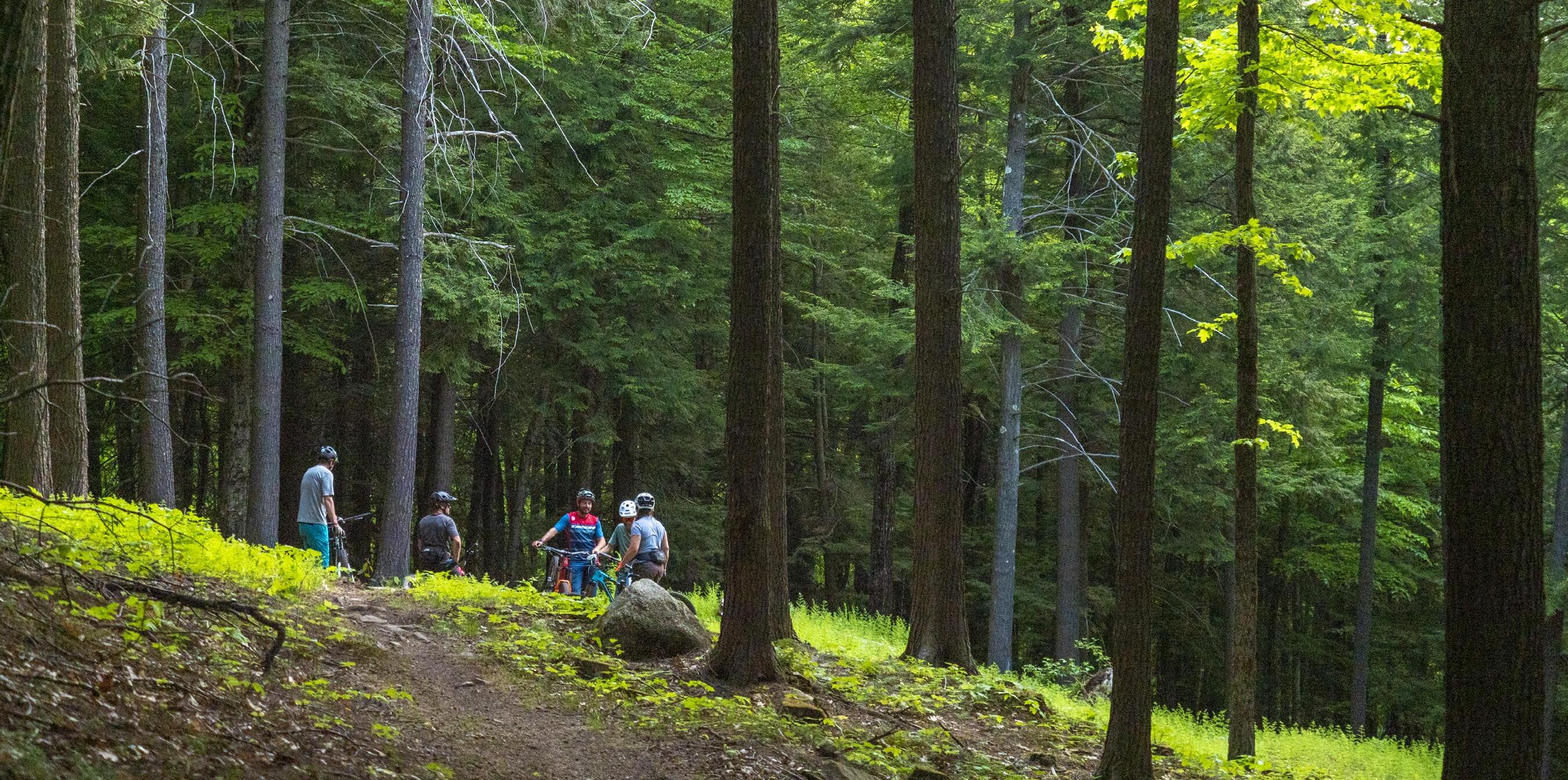
60 MWVvibe.com
GORHAM Coös Cycling Club * BETHLEHEM Bethlehem Trails Association * NORTH CONWAY RideNoCo • NEMBA *
Photo by Brice Shirbach @bricycles
Valley community, businesses, and supporters to meet the fundraising goal this spring. Unlike many trail projects, the stakes are high on this one: without a successful restoration, this unique trail is slated to be decommissioned. Consider assisting Ride NoCo in its efforts to save Half Day by visiting their website at www.ridenoco.org/donate to pledge your support.
Ride NoCo will be holding volunteer trail days throughout the season to clean up and maintain the trails. With no special skills or tools needed, these events are a great cost-free way to give back and meet others in the riding community. Trail days are typically followed by a fun group ride, which is a great way to get to know the network. In addition, Ride NoCo has two fun events in the works this summer to help raise funds and thank the community that makes it all possible. June 17 is the annual Hop Stroski Release Party at Saco River Brewing to benefit Ride NoCo’s trail efforts. Hop Stroski is an IPA brewed in honor of board member and valley legend, racer Pete Ostroski. Be sure to look for it in stores, as a portion of the proceeds will benefit Ride NoCo. Ride NoCo will be hosting a mountain bike festival Labor Day weekend with an evening of fun on September 2 at Ledge Brewing Company with live music, MTB movie screening, beer, and food. More details will be released as the event draws closer.
The beautiful and diverse Mt. Washington Valley is truly a mountain bike destination, with multiple trail networks sure to please all types of riders. Explore the trails and show your support by lending a hand at one of the trail days and by becoming a member at www.ridenoco.org/membership. Both individual and family memberships are available at various levels of support. All membership funds stay right in the Valley and go directly towards new trails, bigger berms, and better community access. Follow Ride NoCo on Facebook and Instagram for the latest updates.
2023 CAPITAL CAMPAIGN - DONATION OPPORTUNITY

Located on Cathedral Ledge, Half Day is an expert downhill trail that has safety and sustainability issues that will be addressed in reconfiguration and restoration projects. Check out www.ridenoco.org/projects for information.
TOP 2023 RIDE NOCO EVENTS & RIDES
(see website and/or social media for specific details)




April 22: Trail Day #1
May 20: Trail Day #2
June 10: Trail Day #3
June 17: Hop Stroski Release Party/Ride NoCo Benefit at Saco River Brewing

July 15: Trail Day #4
August 12: Trail Day #5
September 2-4: Mountain Bike Fest (Ledge Brewing-Sept 2)

October 21: Trail Day #6
RIDE NOCO
www.ridenoco.org
www.facebook.com/ridenoco
www.instagram.com/ride_noco
Spring 2023 61
frontsidecoffee.com
Frontside honors and celebrates the hard work and dedication of all the people who farm, harvest, sort and process the fine coffees we offer.
Freshly roasted coffee shipped to you!
NORTH CONWAY VILLAGE
www.ridenoco.org/trails-map


2023 CAPITAL CAMPAIGN PROJECT
Hurricane Highway
Surf’s Up
Hurricane
Surf’s Up Cranmore Connector
over 100 miles of rideable trails.

Ride NoCo is responsible for building and maintaining these trails in collaboration with local landowners and land managers. Please consider donating or purchasing a Ride NoCo membership. All proceeds go directly towards maintaining and expanding this trail network.

The chapter’s ongoing relationships with key stakeholders, such as the Forest Service, local governments, land managers, and individual landowners are important to current and future riding opportunities in the Mt. Washington Valley.
For more information please visit ridenoco.org or scan the QR code to donate now. We appreciate your support!
in a new curriculum that includes trail design, building, and maintenance through the school. In the future, NEMBA will pursue these grant opportunities to continue building and improving the trail systems they manage.
Volunteers make the world go round.

MWVvibe.com
Black Cap Trail
Red Tail
KettleRidge
KettleRidge
Kettle Ridge RedTail
Sendero Tornado KettleRidge Kandagnar
Highway
Kandagnar
Hurricane
Cathedral Ledge Map Kiosk Parking Easiest Difficult Expert Trails
CATHEDRAL
Mountain Zone HalfDay
HURRICANE MOUNTAIN ZONE
LEDGE
Photo courtesy of NEMBA
Mt. Washington Valley Bike Trails


Like the wheels on your bike that keep you rolling, there are countless volunteers who graciously give their time maintaining miles and miles of trails here in the Valley. There is no value you can assign to volunteers; they are priceless. Without their great effort, we would not have the world-class riding opportunities that we have.
The Valley has an amazing and diverse trail system, from raw backcountry single-track in the forest to flowing machine-built trails with easy access. White Mountains NEMBA creates and maintains world-class trails. Get involved, get together with other mountain bikers and friends, and help maintain and build



the future of this great trail system. The chapter will host three weekend trail events this summer. Saturday is a day to get dirty and take care of some trail work. Saturday evening involves gathering to share good food and good times. Sunday is all about riding! So, get involved by giving back and enjoy the efforts and friendships created around what you love to do.

Fundraisers, donations, grants, and volunteer labor are the tools that get the work done. NEMBA is a non–profit organization that collects membership dues and distributes them to the individual chapters. All other direct donations, grants, and fundraising go directly to the local chapter and are controlled locally.




Spring 2023 63 Enjoy a pint or a flight, and be sure to take some beer to go in growlers or cans! VISIT OUR FRYEBURG TASTING ROOM! VISIT OUR TASTING ROOM! (207) 256-3028 www.SacoRiverBrewing.com 10 Jockey Cap Lane, Fryeburg, ME Offering a variety of styles focused on high-quality, local brew! V S T A (603) 356-5084 Route 16/302 Intervale, NH Specializing in Craft Beer & Wine Kegs • Groceries • Gifts The Hoppiest Beer Store in the Valley! • OPEN DAILY • Sun – Thu • 8am – 8pm Fri & Sat • 8am – 9pm
www.wmnembachapter.org/maps
In the past year, funds were raised for the purchase of a Snow Dog, which is being used to groom winter fat-biking trails at Rogers Crossing in Bartlett and the Marshall conservation property in Conway. These funds also go towards machine operation and maintenance, tool purchases and replacement, and materials for trail work, such as lumber for bridges. Our annual fundraiser is held at Flatbread Company in North Conway each fall. NEMBA raffles items, accepts donations, and part of the proceeds from pizza sales that evening are generously given to the local chapter.
Mountain biking in the Valley is a part of the overall cycling culture and community fabric of this outdoor opportunity-rich place we call home. The Valley is fortunate to have so many groups, organizations, and committed individuals that come together to weave this fabric. Everyone is a piece of this fabric—whether you ride xc, enduro, fat bike, downhill, gravel, road, or whatever! Go ride your bike! And thank a volunteer!
TOP 2023 NEMBA FOCUS
The White Mountains Chapter was awarded the NEMBA “signature grant” for 2022. This grant will help fund the Pine Hill project on property owned and managed by the Upper Saco Valley Land Trust and adjoining Kennett High School property. This project will provide a new and sustainable competition trail for the Kennett mountain bike team, as well as connect new and existing multi-use community trails.
TOP 2023 EVENTS & RIDES
(see website and/or social media for specific details)
April 21: Membership meeting at Saco River Brewing in Fryeburg
June 17 and 18: Trail weekend #1
July 15 and 16: Trail weekend #2
August 26 and 27: Trail weekend #3
September 1: Membership meeting at Pro Tune in Glen
September: Annual fundraiser at Flatbread Company
September 22-24: Mt. Washington Valley MTB Festival at the fields of Attitash
NEMBA
www.wmnembachapter.org
www.instagram.com/wmnemba
www.facebook.com/wm.nemba.5
BRINGING A TRAIL TO LIFE … CONCEPT TO COMPLETION
We all probably have memories from back in the day of clearing out the brush and building a couple of kickers at the ‘ol sand pit down the road. We’d dig, move boulders, test, dig some more, and repeat until it was perfect. But that was then, and this is now, and things have changed a bit. Mt. Washington Valley Vibe reached out to local trail builder, Corbett Tulip, of Tulip Trails, to get a better idea of just what goes into designing and building mountain bike trails these days and in this region.
TULIP TRAILS - STARTING WITH THE DESIGN PROCESS Getting to Know Your Project and Partners
Meeting with stakeholders to discuss projects and user group(s) is essential. Projects often involve multiple stakeholders with different views and concerns. Bringing them to the table to discuss sustainability and management is essential. Sustainability includes three components: environmental, social, and economic. How will the project impact the landscape, and will it provide resource protection? How does this project benefit the community? Does this project serve multiple user groups? Will the trail be overcrowded or underutilized? Trail development is a great way to invest in a community and stimulate economic growth. How will the land manager and community bear the long-term costs of maintaining a trail and related infrastructure?
Lay of the Land—Spending Time Exploring the Property
After understanding the goals of the project, it’s important to get on site and spend time exploring the property and what it might have to offer. Spending time on site helps create an inventory, including favorable terrain, soil types, and unique points of interest. It will provide a better understanding of the property’s constraints, such as boundaries, wet areas or steep slopes, and environmentally or culturally sensitive areas.
Designing the Trail
Once you have an idea of what the property looks like and there is a clear goal for the project, it’s time to begin mapping out the trail. Each trail has its own story, the design is a balance between a creative vision and the realities of sustainable construction. Mountain biking trails are unique; it’s not just about getting from point A to B, adding an element of playfulness to enhance the rider’s experience is important. Using the terrain as inspiration to think creatively and discover the story unique to each trail. Adding features that play off the natural terrain, such as rock drops, rollers, and jumps, adds to the flow of each trail. Laying out a successful trail is a balancing act between finding flow, building sustainably, controlling construction costs, and maintaining a level of safety while still challenging riders. Each trail has a unique story, and this is where a creative mind and the realities of construction collide.
CONTINUING THE CONSTRUCTION PROCESS
Depending on the project and terrain, various tools can be implemented from large excavators to basic hand tools. Before any digging starts, thought must be given to

64 MWVvibe.com
Photo by WiseguyCreative.com
moving equipment and people in and out of the woods safely with minimal environmental impact.
Clearing the Corridor
A trails “corridor” includes the trail, as well as the areas above and to the sides of the trail. Mountain bikers travel fast, so an open corridor with clear sight lines is important for safety. Clearing the corridor of underbrush and tree limbs is important, but mature trees should be saved whenever possible. Giving thought to building around trees whenever possible adds sinuous flow to the trail and reduces the disturbance to the land.
Building the Tread
The surface of the trail where people ride or walk is known as the “tread.” Most mountain biking trails are built with native materials, meaning constructed with what is found in the woods. The most natural trails use the existing ground as the tread, and many riders enjoy the challenge and character provided by a natural surface and the changes it goes through as it ages. Modern “flow” trails are built with a partially or fully excavated tread, where the top organic layers are removed, and the more durable mineral soils below are utilized. This gives a smoother, more consistent riding surface that can withstand heavy use. To keep a trail interesting, natural features such as large roots or rocks can be incorporated. For all trail construction, understanding and managing water and rider speed is essential to sustainability.

Water Management

A trail’s worst enemy is erosion caused by water. Modern mountain biking trails are increasingly complex, requiring a variety of drainage solutions. Building directly down the hill should be avoided for any extended length. Instead, a trail should change direction often and be built across the slope. Adding features like large rollers, known as grade reversals, not only adds fun, but keeps water from flowing down the trail. Managing water on a mountainside is tricky and the flow of water can change with the seasons. Solutions such as drainage pipes to stone drains can be used to direct water off the trail.
Speed Management
Understanding and managing rider speed is an important as pect of building a sustainable trail. Going fast is fun, but when riders are forced to slow quickly to navigate a feature or corner, they brake hard which can lead to severe trail degradation. Like water management, a grade reversal or brief uphill can help naturally slow riders when needed. Trail features such as slight corners, obstacles, and rollers help control speed while also adding to the flow of the trail.
Maintenance
The final and often overlooked aspect of trail design is un derstanding the need for maintenance. Any trail, especially modern flow trails, requires maintenance to ensure drainage and features remain in working order. This work often falls on the local organizations managing the trail, so it’s proactive to develop a routine of seasonal maintenance to prevent the development of major issues and more work.
TULIP TRAILS
10 Cross Street, North Conway, NH (603) 986-2015 • www.tuliptrails.com



Spring 2023
COÖS CYCLING CLUB
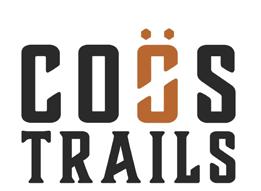
MAY 20
By Kara Hunter
The word is out that biking in the North Country is worth a trip and the Coös Cycling Club is heading into 2023 with a lot on its plate, and a sizzling level of energy behind the scenes. Goals to increase trail mileage, expand popular kid’s programming, and pilot a spring adventure ride are accompanied by a steadfast and growing weekly group ride, a thriving local mountain bike team, and regular trail work volunteer days.
The club has set a precedent of fostering healthy relationships with landowners, such as Gorham Land Company, NH State Parks, and the town of Gorham, while pairing this with strong working partnerships with local businesses. The result is an environment for steady, sustainable growth, and unique opportunities for collaboration. Add to this a hefty dose of community support, membership, and amazing funding opportunities provided through organizations such as the NH Charitable Foundation and the Northern Forest Center, and well … exciting things are happening!
Riders in the coming season will find several new additions to the Coös Trails Network. Two-year-old connector trail Howie Get There, in conjunction with last year’s continuation of Carry-On, make for some interesting new ride designs on the Pineside. This spring will see the return of trail-building partner, Tulip Trails, to complete work on the first phase of expansion into the wilds beyond Howie Roll. In addition, keep your eyes open system-wide for new tweaks and features as volunteer trail work is ongoing.
As winter wanes, plans are underway for a spring event unlike anything the club has undertaken before: an adventure-style ride (race pace optional) through North Country terrain largely unseen by the non-motorized recreation community thus far. Keep your eyes open for this one, as proceeds from the event will help to support kids’ programming and maintenance of the Coös Trails network. This event will sit on the heels of the club’s annual meeting, which boasts a day of inclusive group rides and a festival atmosphere at Hub North in Gorham on the first weekend in June.

Mention kids’ programming and eyes light up around the table at a Coös Cycling Club meeting. Quickly becoming a focal point of the club’s energy, the Pete’s Bikes program, which offers summer rides for local kids without the barriers of finding or owning gear, has recently expanded to offer a week-long, summer day camp. Shred Camp is open to kids ages 10 to 14 of intermediate skill level. Participants will learn about bike and trail maintenance while improving their riding skills and riding with peers. Check the website for details.
Let us not forget the group rides! The club saw record attendance at weekly rides throughout the summer of 2022. It’s obvious that we’re all itching to get out and ride with friends and the club understands this as an opportunity to broaden its impact. Expect to see a variety of offerings on the calendar for this coming season, from leisurely picnic rides to exploratory gravel grinds and, of course, the usual Wednesday night social.
If you like what you see, the club invites you to become a member!
66 MWVvibe.com
Photo courtesy of By Johanna Sorrell Photography
MOUNT WASHINGTON VALLEY TRAILS ASSOCIATION AND REC PATH



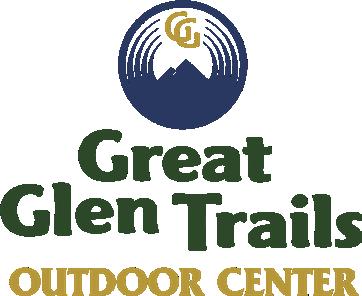

It has been at least 40 years since the community of the Mt. Washington Valley first envisioned the concept of a valley-length, non-motorized, multi-use paved path to provide a safe, non-motorized alternative transportation corridor through town, and serve as an entry-level recreational resource. This summer of 2023, through the contributions and hard work of hundreds of grant organizations, foundations, businesses, and individual community members, our dream will finally become a reality: the North Conway Alternative Transportation and Recreation Path will be finished and open for all to use and enjoy. With the approaching ribbon-cutting, it is appropriate to look back at the not-so-paved path we all took to get to this milestone, and thank all of those community members who helped us along our way. The conceptualization, siting, design, and fundraising, and even the permitting, engineering, and construction of the path has truly been a community-wide
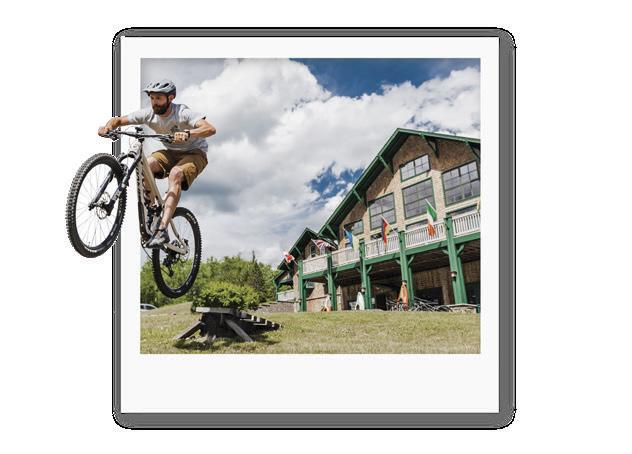

Spring 2023 67 1 Mt. Washington Auto Road, Gorham, NH 03581 mt-washington.com | (603) 466-3988 One mountain, one road, your destination for adventure. Explore more during your visit! Outdoor activities for all ages and abilities at the base of Mt. Washington. Guided Kayak Tours, Mountain Biking, Trail Running & Walking, and events! greatglentrails.com Send it! Bring the whole pack Fun for all ages
North Conway Recreation Path Hemlock Lane to Cranmore Mountain Resort Green Hills Preserve (TNC) 16 00.10.20.30.4Miles 05101,0201,5302,040Feet Cranmore Mountain Resort North Conway 16 302 302 Puddin Pond ^ _ ^ _ Hemlock Lane trailhead Thompson Road trailhead ^ _ Cranmore trailhead North Conway Grand Settlers Green OVP Walmart Mountain Valley Mall Barnes Rd Artist Falls Rd Sk mob e Rd Seavey S John Fuller School LEGEND State of NH Town of Conway Private conservation land Bypass footprint Proposed Recreation Path Mechanic St Thompson Rd Redstone NorthSouth Rd NorthSouth Rd DupreyRd Common Ct MountainValley Blvd Eastman Rd powe i ne powerline q www.mwvrecpath.org/map
TOP 2023 COÖS CYCLING CLUB TRAIL PROJECTS

A new trailhead and map kiosk are now available at Big Day Brewing! Park in the rear portion of the lot located at 20 Glen Road and gain access to the whole Coös Trails network by way of The Jungle and a quick, one block jog on Church Street. It’s a whole different ride from the east side!
Trail Projects Present/Future
2022: Carry On carries on! As per the original plan, Carry On now continues its high traverse east/west along the side of Pine Mountain, connecting to the Bear Springs Trail and providing a new option for accessing the Howie Roll descent. Incorporate the Alpine Springs climb and Carry On/Pat Down for a sweet figure eight. It’s worth noting that the former east end of Carry On now has a new name. In keeping with the airport theme, welcome Biscoff!
2023: Work continues on a new, out-and-back adventure from the top of Howie Roll. This is the first phase of a southeastern expansion for our network and travels through some very cool terrain. Do be patient as work continues on this trail in the spring. When it’s open, you’ll know it!
www.cooscyclingclub.org/coos-trails01
TOP 2023 EVENTS & RIDES
(see website and/or social media for specific details)
May 20: The Coös Frost Heave
June 3: Coös Cycling Club Annual Meeting
Wednesday Nights this summer and fall— MTB Group Ride
Meet in the picnic area at Moose Brook State Park and departs at 5:30 p.m.
June 26-30: Shred Camp
MTB Day Camp for kids ages 10 to 14. Learn skills and ride with peers.
Coös Cycling Club
www.cooscyclingclub.org
www.facebook.com - Search Coos cycling club
www.instagram.com/cooscyclingclub
68 MWVvibe.com
effort. In the early days, Steve Swenson and a small recreation advisory committee came up with the idea of a path segregated from vehicular traffic, and Conway town officials had the foresight to include the path in the town’s master plan. It wasn’t until the 2000s however, when the committee (now MWV Trails Association) conducted multiple public forums on their vision, and decided to use the Rec Path concept as an alternative transportation backbone for non-motorized connectivity across the Valley, connecting important town amenities and existing trail networks to one spine. This decision resulted in the placement of the path within the defunct Conway By-Pass corridor, commencement of work in earnest, and our project’s unofficial nickname, the “Conway By-Path.”

Fundraising began in earnest, and with the great assistance of our elected officials and the donated time of local professionals, the project secured an anchor federal CMAQ grant, matched by state grants, local foundation grants, and the donations of hundreds of community businesses and friends. Even the design engineering, construction engineering, and construction has been accomplished by local firms deeply involved in the community.

Over 2022, the Rec Path was cleared and laid out, bridges have been installed, and the underlayment placed. Now 2023, once conditions allow, Coleman Construction will put down the pavement surface, and finalize the Rec Path for everyone to use this summer. Whether you choose to run, bike, ski, skate, or scooter, or use a stroller, wheelchair, or walker–on behalf of the Mount Washington Valley Trails Association and Rec Path committee, we hope you join us on the path!

Spring 2023 69 VoIP Phone Systems featuring Voicemail to Email • Smartphone & Computer Apps • Mobile Office Serving our Valley for over 20 years VOICE, DATA, & VIDEO COMMUNICATIONS NORTHLEDGE TECHNOLOGIES INC. (603) 383-4030 • www.northledge.com Business & Home Technology IT Systems & Tech Support Smarthome Integration ASK US ABOUT OUR POWERFUL WIFI SOLUTIONS
www.mwvrecpath.org www.facebook.com/MwvRecPath
MOUNT WASHINGTON VALLEY TRAILS ASSOCIATION AND REC PATH
Photo by WiseguyCreative.com
Bethlehem Trails Association
www.bethlehemtrails.org/map
BETHLEHEM TRAILS ASSOCIATION
By Ian Dowling
Bethlehem Trails Association (BTA) was formed just five short years ago, in 2018, to provide trails and resources for human-powered recreation that support the community and promote sustainable tourism. In that time, a great mix of trails has been built for all ability levels and styles, from cross country to downhill flow trails, using a combination of hand and machine-built techniques. A unique highlight of the network is climbing to an elevation of 2,378 feet to the top of Mount Agassiz. From there you can enjoy an amazing view of Franconia Notch before descending 3 miles of singletrack, riding down 1,500 feet to the banks of the scenic Ammonoosuc River, an experience not easy to forget. Getting to the trails could not be easier; simply park in one of the public lots in the center of town to access the whole system. After your ride, you can explore all the town has to offer, from shops and galleries to cafés and breweries, without moving your car. To continue working towards the mission of supporting the community, BTA formed The Gear Library with the help of community grants and local businesses. The Gear Library provides the opportunity for anyone to borrow equipment to use on the trails and elsewhere. Anyone that is interested can rent snowshoes, microspikes, and baby sleds in the winter, as
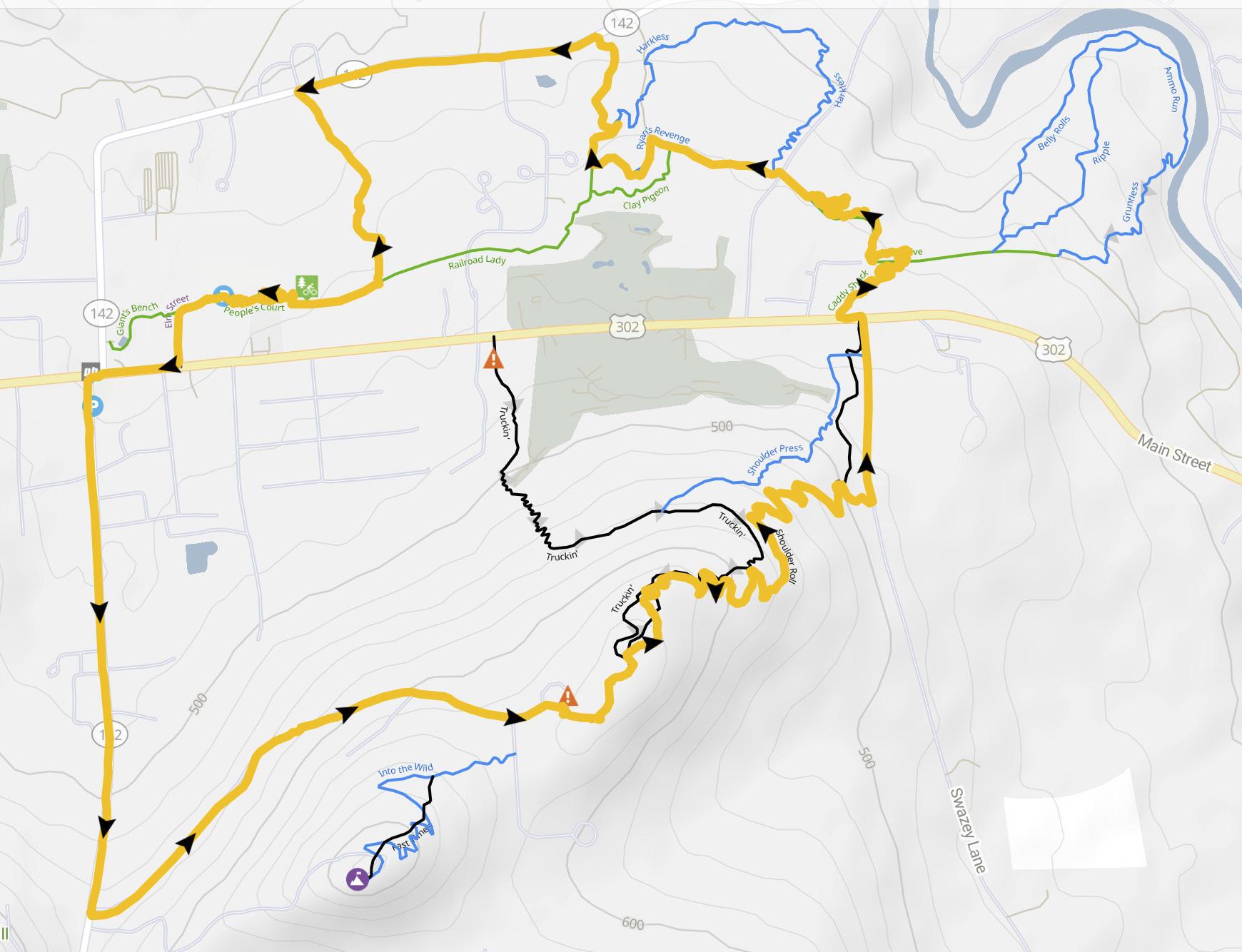
Gear Library provides the opportunity for anyone to borrow equipment to use on the trails and elsewhere.

well as balance bikes for kids, baby carriers, bike helmets, and hiking poles in the summer. As The Gear Library grows, we plan to add additional equipment to help make accessing the trails that much easier.
The Bethlehem Trails Association network is a great place to spend a day or a weekend with the whole family in the beautiful White Mountains. Experience the trails, shopping, great restaurants, and unforgettable memories.
TOP 2023 BTA EVENTS & RIDES

(see website and/or social media for specific details)

September 24: TRIKE FEST
September brings “Trikefest.” It’s a mountain bike festival that will take place at rek’•lis brewing. This festival celebrates and raises money for our three local mountain bike networks: Parker Mountain, Franconia NEMBA, and BTA. The festival features live music all day, guided rides, and raffles with amazing prizes. Last year the grand prize was a $5,000 Norco mountain bike.
BETHLEHEM TRAILS ASSOCIATION
www.bethlehemtrails.org
www.facebook.com/bethlehemtrailsassoc
www.instagram.com/bethlehemtrails
70 MWVvibe.com
Photo courtesy of BTA


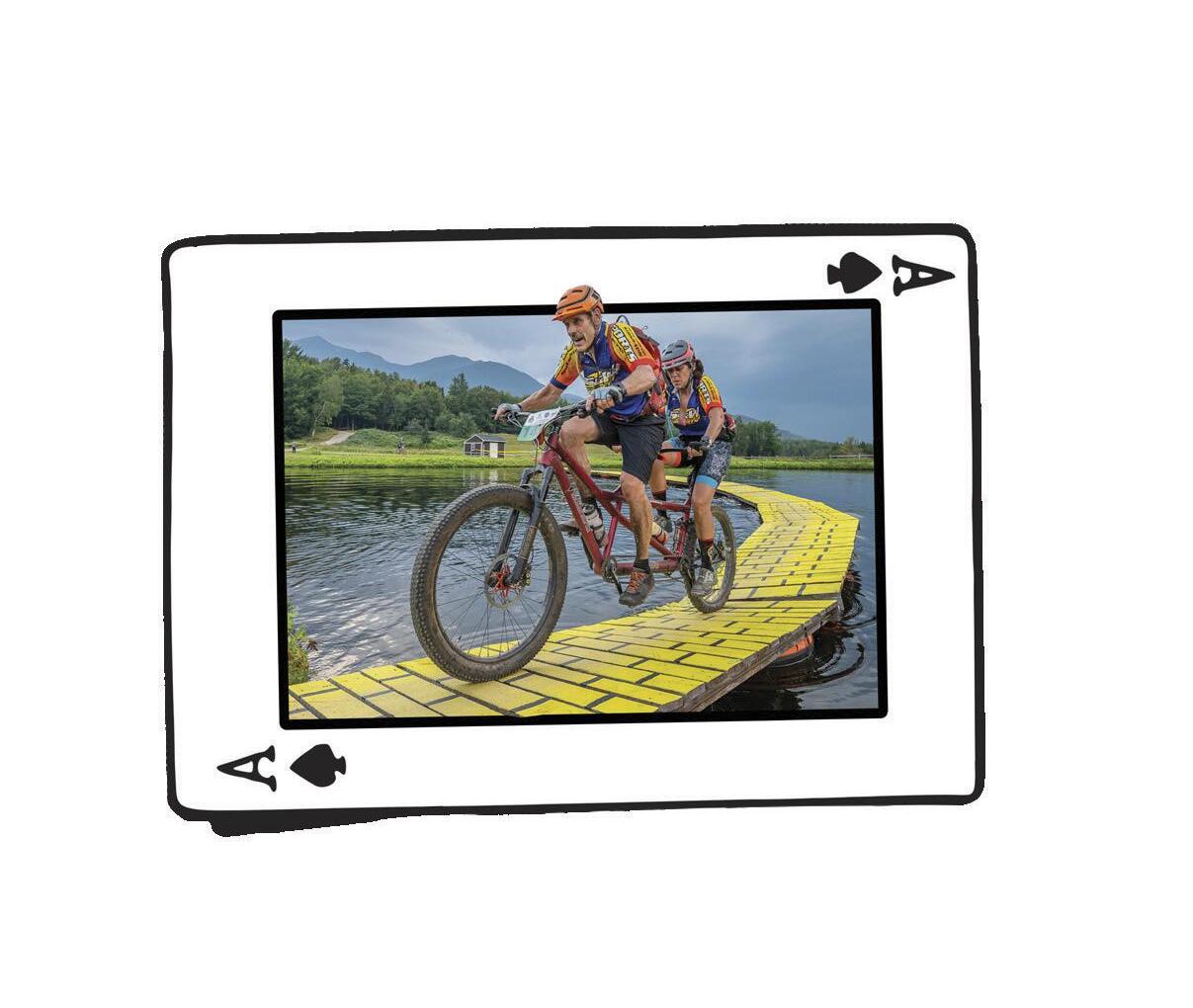
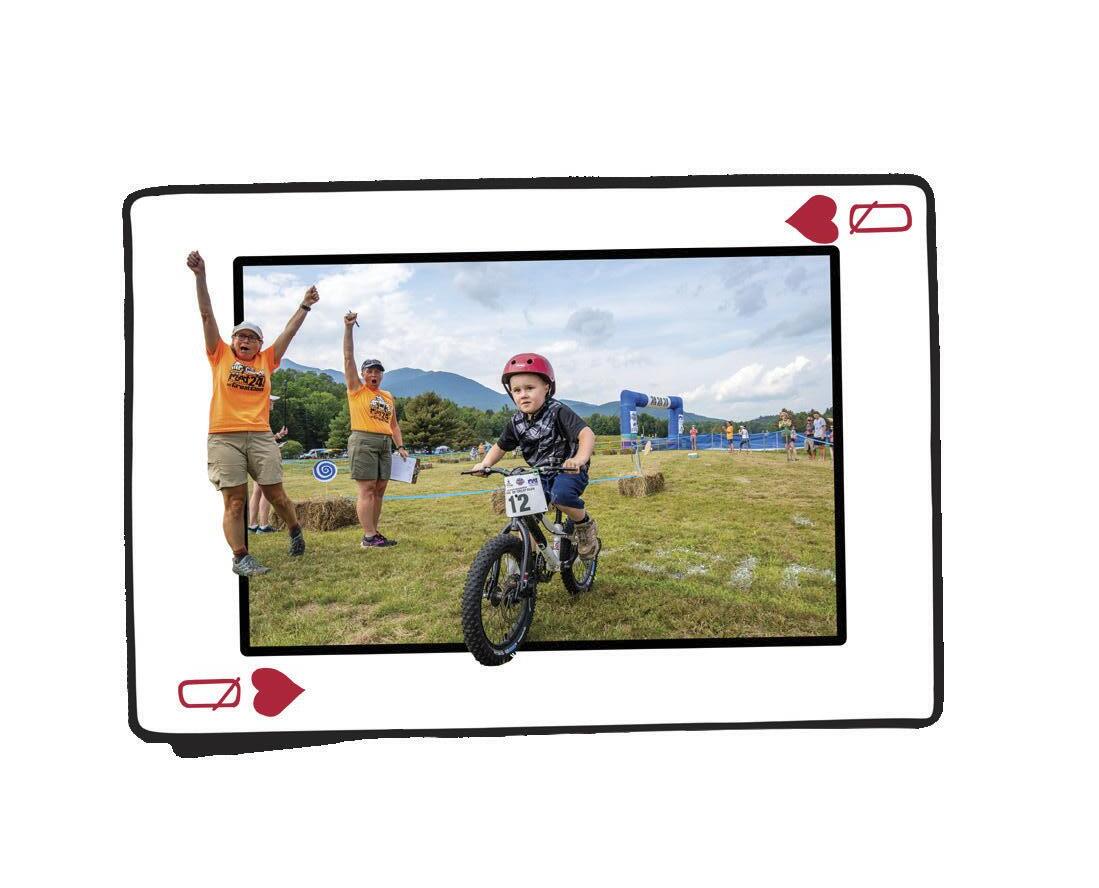

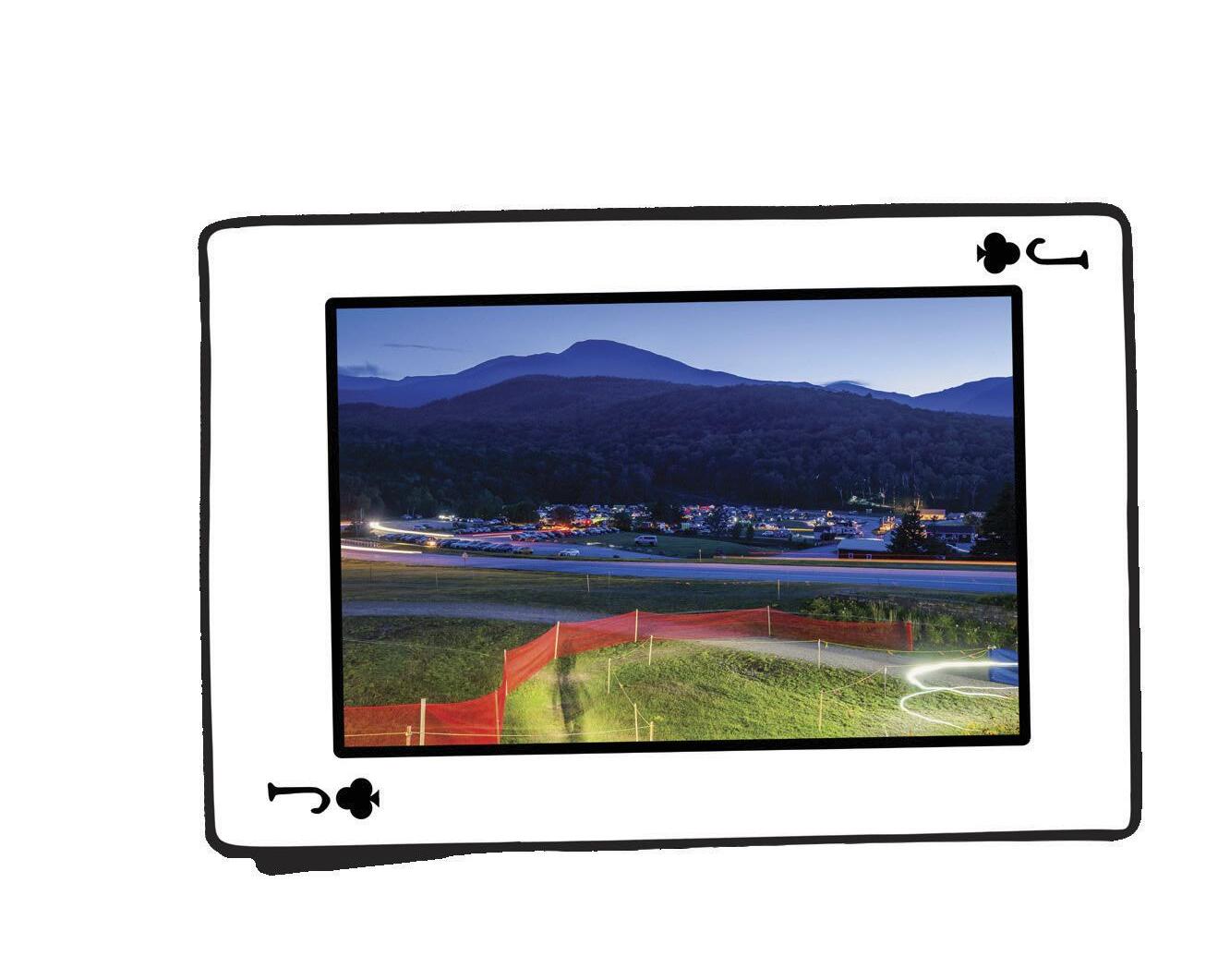



71 23 REGISTER NOW! PRESENTED BY: www.24hoursofgreatglen.com 1 Mt. Washington Auto Road (603) 466-3988 Route 16, Pinkham Notch, New Hampshire Live music, food trucks, weekend camping, kid races and games, and more! MOAT MOUNTAIN 24 HOURS OF GREAT GLEN: THE MOST SOUGHT-AFTER MOUNTAIN BIKE RACE IN NEW ENGLAND Solo riders or teams of 2, 4, or 5. Co-ed, Junior options. 12 or 24 hour races.
SPRING FISHING Our Valley Lakes
Fish Nerds takes a Closer Look at Conway, Ossipee, and Silver Lakes ... Just for the Fun of It!
By Clay Groves
There’s something special about getting on a boat before the sun rises as the fog sits in silence and the loons howl. You can’t see much, but once that sun breaks, the fog will begin to burn off and the fish will be ready for breakfast … and you will be ready for them.
The Mt. Washington Valley is home to three amazing lakes with great fishing opportunities for the most ardent angler and just regular fishers who want to have some fun: Ossipee Lake, Silver Lake, and Conway Lake. Fish Nerds guides on all three lakes using a 24-foot pontoon boat and loves all of them for different reasons.

72 MWVvibe.com
SILVER LAKE, MADISON
969 ACRES; MAX DEPTH, 164 FEET
FISH SPECIES: lake trout, landlocked salmon, rainbow trout, smallmouth bass, largemouth bass, pumpkinseed, bluegill, chain pickerel, smelt, and burbot
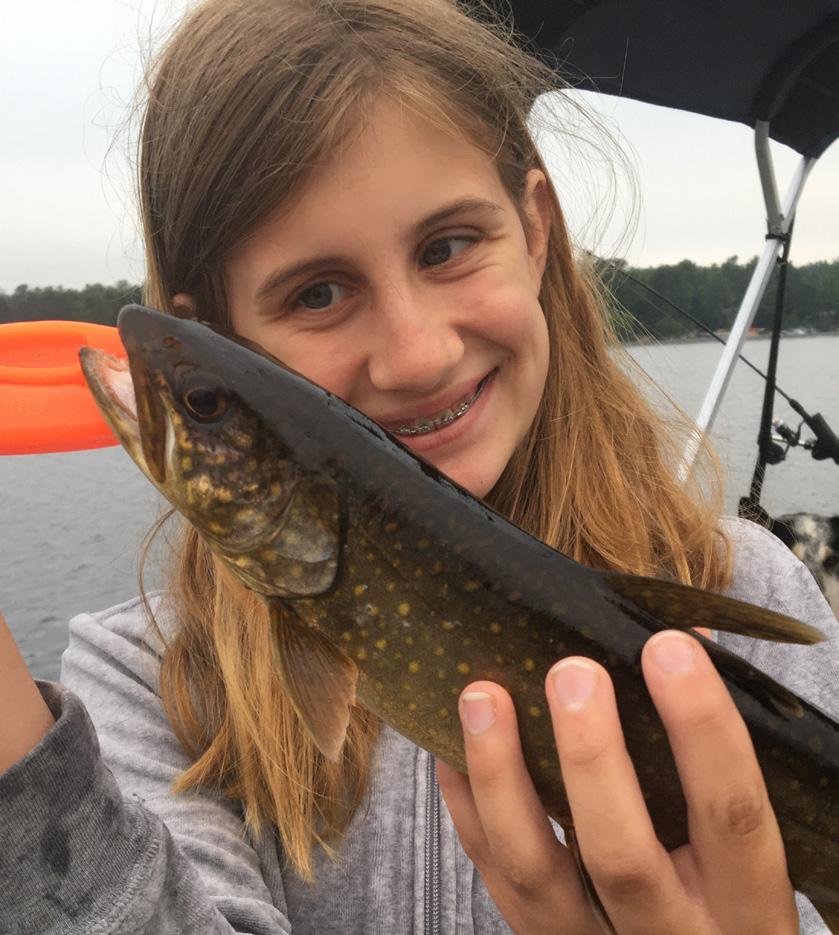
The only lake in the Mt. Washington Valley with lake trout is Silver Lake in Madison, where togue hide deep in the glacial crevasses. There are two primary ways to fish them, trolling and down-rigging. Trolling a lure behind a boat at around 2 miles per hour works quite well.

The most difficult part about this method is getting the line down deep to where the fish are. We use two methods: one is lead core; that’s a line that is literally wrapped around a lead thread. The weight of the line brings the bait to the fish. The other method is a downrigger, a pulley system with an 8-pound ball that the line is attached to, which sends the ball down to the desired depth; and the line will be exactly where the fish are. When the fish bites, the line snaps free and you just reel the fish in.
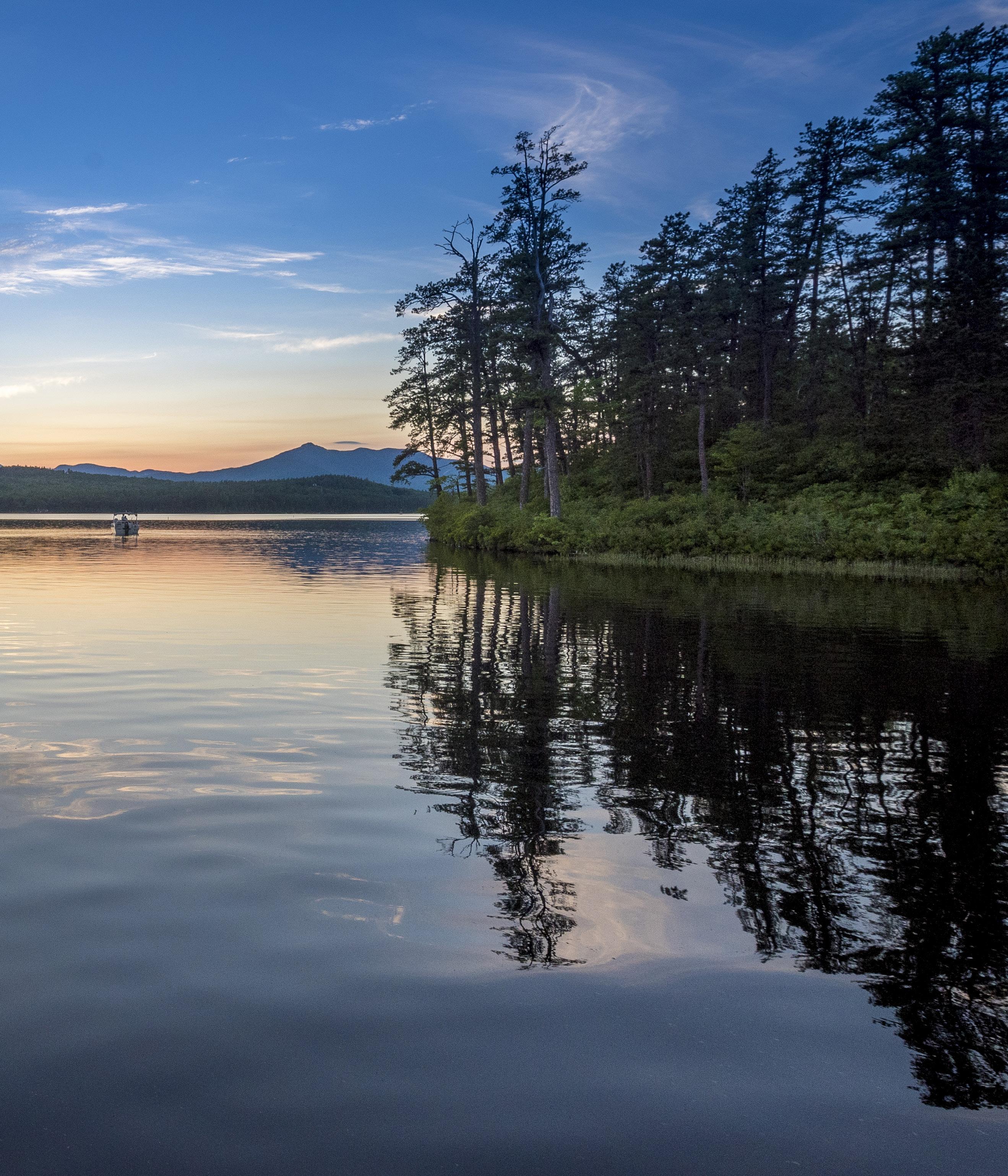
73
WiseguyCreative.com photo
Fish Nerds photo
(Silver Lake cont.) Releasing these fish is the next challenge. The fight from a moving boat exhausts them, so be sure to hold them in the water a bit, letting the water flow through their gills until they pull away from you.

Other fish that you may catch in Silver Lake while trolling include rainbow trout, smallmouth bass, and if you’re very lucky, a landlocked salmon. One of the things that is most striking about Silver Lake is the challenge of fishing it. I’ve been guiding on that lake for seven years, and every salmon, bass, or trout caught there challenges what I know about fishing.
But if you want to have a really good time, tuck your boat into a cove and spend an hour or two jigging for jumbo yellow perch. We like to keep the jigs simple, such as a 1/8-ounce tungsten jig tipped with a small plastic worm or tiny segment of night crawler. Just drop them down into the water near the weeds, and boom … FISH ON! This is a real crowd-pleaser for kids!
DID YOU KNOW?
Another notable fact about Silver Lake is that poet E.E. Cummings lived there and wrote some of his poems, and even painted, from a treehouse atop Hurricane Point.
RECIPE: Lake Trout Nuggets Wrapped in Bacon
• Filet the laker into 2-inch chunks and season with salt and pepper
• Wrap each chunk in thick bacon and skewer with a toothpick
• Bake in the oven at 350º for 20 minutes, or until bacon is crispy
• Peel the bacon off the trout and eat the bacon, throw the trout away … it’s gross
CONWAY LAKE
1316 ACRES; MAX DEPTH, 45 FEET
FISH SPECIES: chain pickerel, hornpout (same as BBH–brown bullhead), landlocked salmon, largemouth bass, rainbow trout, and smallmouth bass

If you have the desire to catch salmon, you’ll do much better at Conway Lake New Hampshire Fish and Game Department stocks this lake with salmon at much higher numbers than trout. Our favorite techniques include using the same trolling methods as mentioned previously—but don’t be afraid to let your lure sit on top of the water, especially at first light, when salmon prefer to bite. Once the sun gets higher in the sky, trout and salmon success will fade, so it’s best to turn your attention to Conway Lake’s amazing smallmouth fishing. There are dozens of islands all around the lake surrounded by rocks, boulders, and cobble—a favorite feeding ground for smallies. My favorite methods are the simplest. Use a 1/0 offset hook and a Senko (rubber worm), toss that hundreds of times all day around the rocks and get ready to catch monsters. Smallmouth bass fight better than almost any other fish in NH and will jump and cause your boating guests to scream with delight as they try to throw the hook. Once you’ve caught your fill of bass, take a break, and just float in the middle of the lake. You won’t get a better view of snow-capped Mount Washington anywhere else in the Valley!
DID YOU KNOW?
While you’re fishing, take a look at some of the "rock piles" just below the surface. Conway Lake is home to a very big common snapping turtle named Pork Chop. We’ve seen him a few times and he is a beautiful creature!
74
Nerds photo
Fish Nerds photo
Fish
RECIPE: Landlocked Salmon
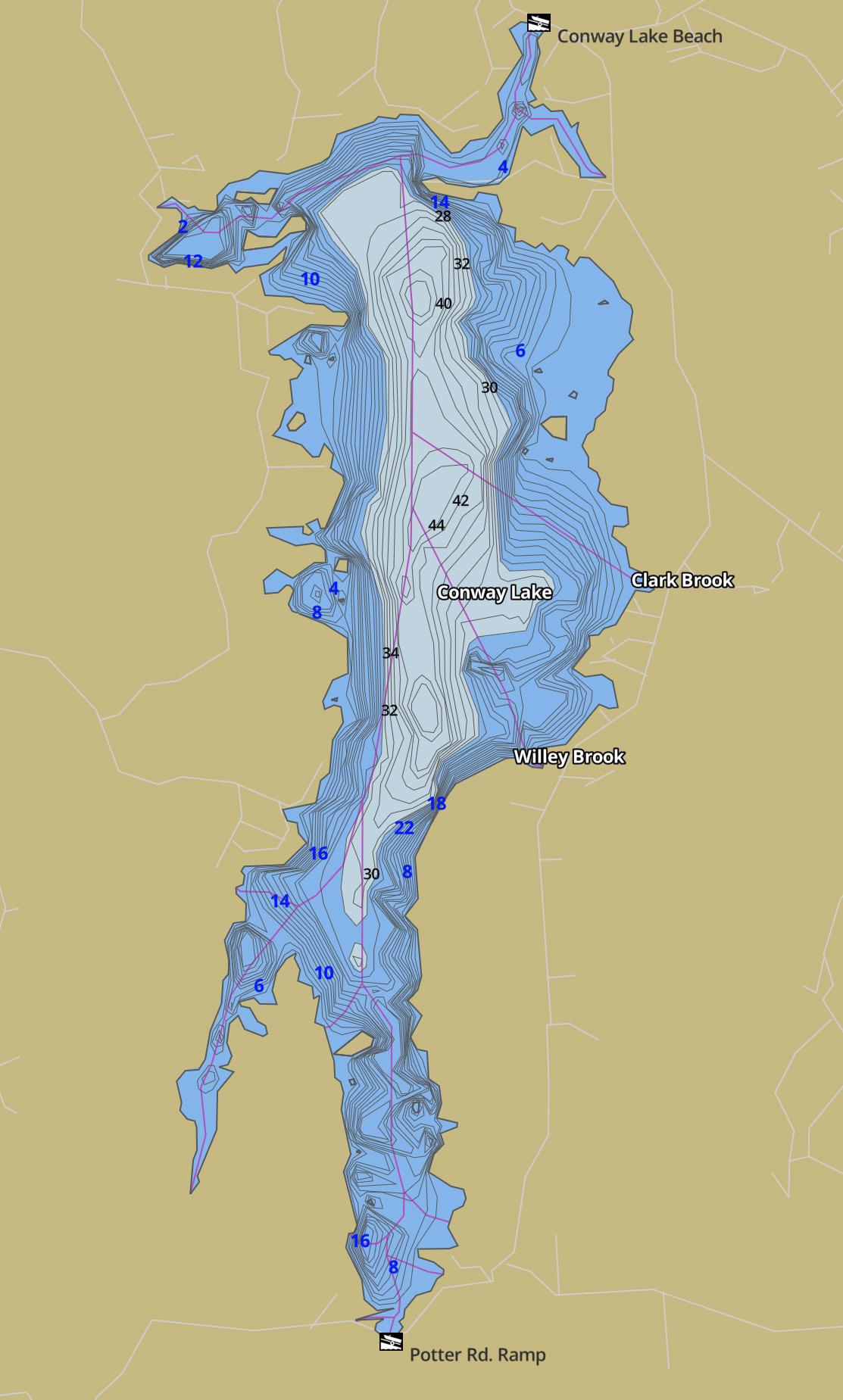
We do like to eat landlocked salmon in the spring! Here is my favorite recipe.
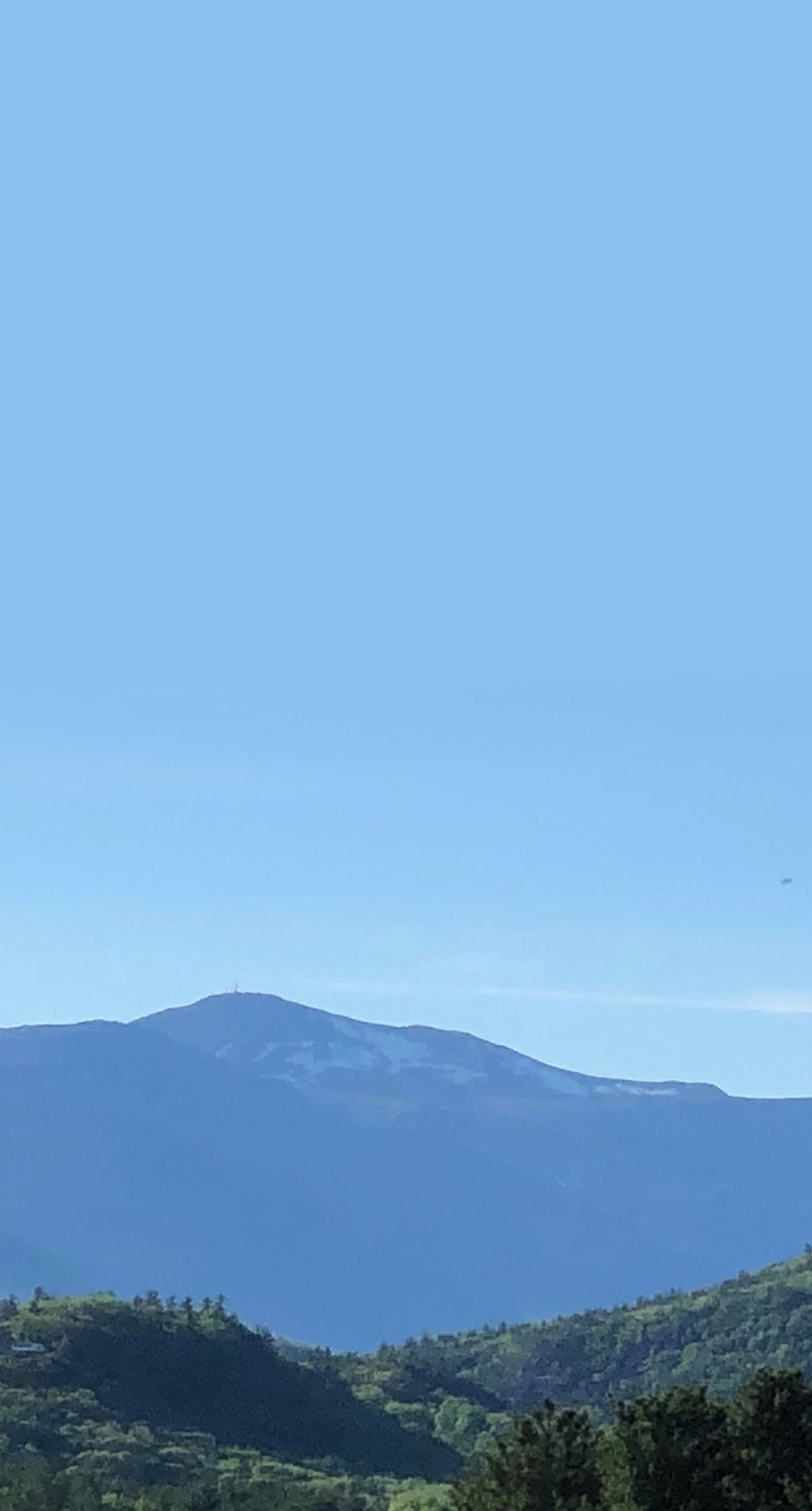

• Gather some wild fiddlehead ferns and ramps

• Take the salmon filets and pat them dry; rub them with olive oil, and season with salt and pepper
• Chop the ramp and sprinkle it on the top


• Put the salmon, skin side down, on a wooden plank on the grill on medium-high heat
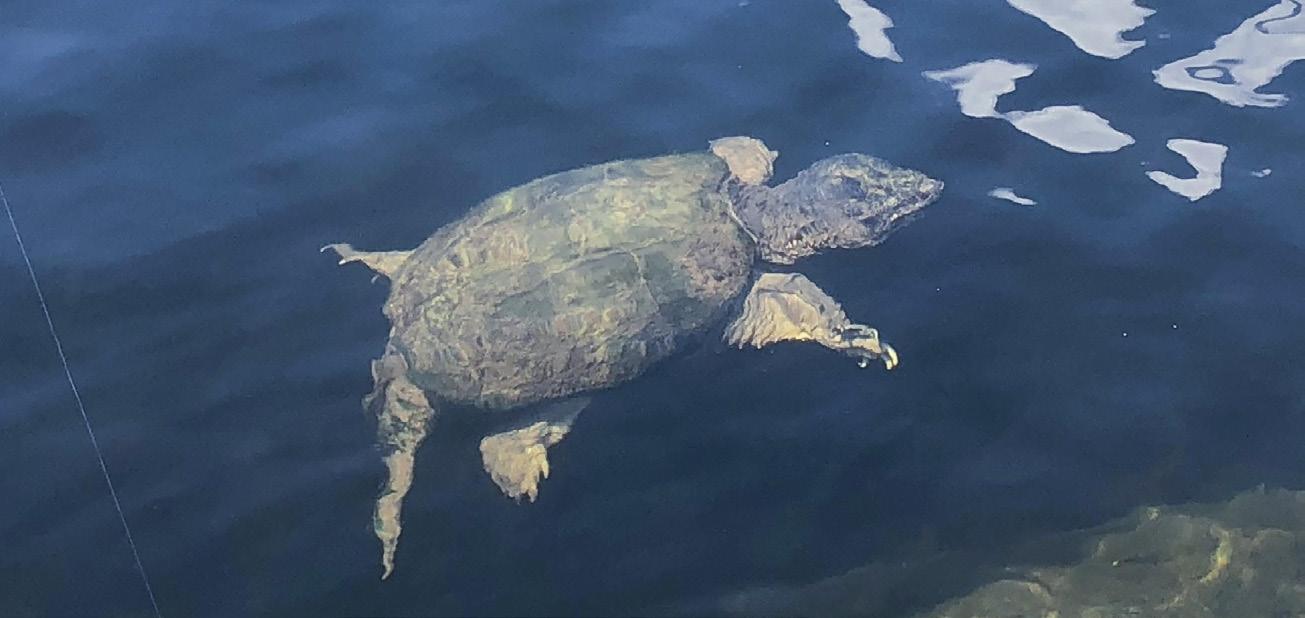
• While that is cooking, steam the fiddleheads, poach an egg, and prepare some hollandaise sauce.
• When the salmon is cooked medium/well, remove it from the heat, place the poached egg and fiddleheads on top, and drizzle with hollandaise and chopped ramps
75
Fish Nerds photo
WHITE MOUNTAIN INDEPENDENTS WhiteMountainIndependents.com Shop Small • Shop Indie Local Shop the Blue Flags! Visit us or shop online! THE WHITE MOUNTAIN INDEPENDENTS Gift-giving made easy! Gift certificates can be redeemed at any of our 20+ member retailers! Purchase certificates in increments of $25 online! • Assets Jean Co. • Bavarian Chocolate Haus • Cathedral Ledge Distillery • The Christmas Loft • Designed Gardens Flower Studio • Discount Beverage • Fields of Ambrosia • Four Your Paws Only
The Handcrafter’s Barn
It’s My Girlfriend’s Consignment Boutique
Jewelry by Tim & Friends
The Local Grocer
North Conway Olive Oil Co. • North Country Fair Jewelers
The Penguin Gallery
Ragged Mountain Equipment
RavenWood Curio Shoppe
The Root Cellar
The Rugged Mill
Soyfire Candle Bath & Body
Spruce Hurricane
Valley Artisans & Vintage Market
Veno’s Specialty Foods & Meats
White Birch Books
White Mountain Winery
•
•
•
•
•
•
•
•
•
•
•
•
•
•
•
•
OSSIPEE LAKE
3,257 ACRES; MAX DEPTH, 73 FEET
FISH SPECIES: rainbow trout, brown trout, landlocked salmon, blue gill, pumpkinseed, yellow perch, brown bullhead, white perch, largemouth bass, smallmouth bass, and burbot
So you want to have a fish fry? Grab your boat and head to Ossipee Lake! There you’ll find white perch … and Ossipee Lake has a huge population of this delicious bass. Yep, you’re reading that right, they are true bass, not even in the perch family. Another true or temperate bass you might know to include is the striped bass. And like a striper, these fish are anadromous, which means normally they are born in freshwater and migrate to the ocean and then return to freshwater to spawn. We (humans) have landlocked them, and they thrive in Ossipee Lake. ALL fishing techniques work for white perch. I like to fish with various colored jigs, small rooster tails, and spoons.
The fish can be anywhere—and when you find them, they will be in schools of
hundreds—so get ready for a feeding frenzy. I recommend you eat these fish. They are easy to filet and make wonderful flaky fish tacos. In your search for them, start at the sand bars and fish the drop-offs. The best fishing for white perch is sunset, so be prepared to stay out past dark.
Ossipee is a party lake, so be prepared for lots of other boaters, water skiers, and crowds. If you want to take a break from fishing, there’s a sandbar with a volleyball net you can anchor near and enjoy hanging with a bunch of your closest new friends.

DID YOU KNOW?
While you’re on the lake, you’ll notice the entire lake is surrounded by mountains. Actually, these are volcanoes
(603) 356-0039 · 2101 Wht Mtn Hwy, North Conway, NH
Hours: Tuesday - Friday 9AM - 5PM Saturday 9AM - 4PM, Sunday 12PM - 4PM Closed on Mondays

76 MWVvibe.com
Fish Nerds photo
called a ring dike of volcanoes that were active 122 million years ago. There is only one other view like that in the world, so take a minute to just soak it in.
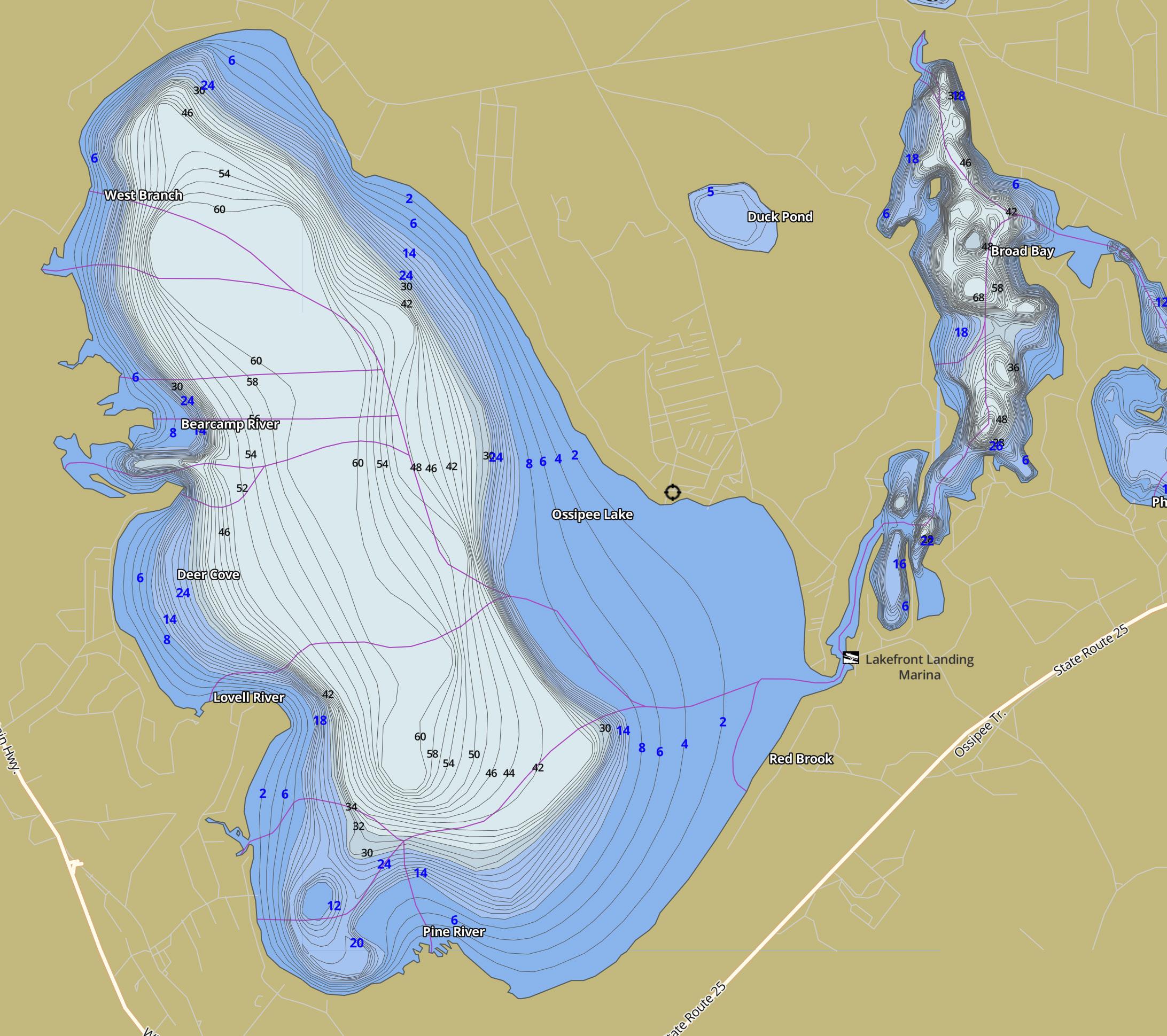
RECIPE: White Perch Fish Taco





• Filet the perch and cut it into strips
• Drench the perch in seasoned flour, then wash it in eggs and drench it in seasoned breadcrumbs

• Fry until golden brown

• Serve with flour tortillas and your favorite taco toppings
I love all of these lakes and love getting people out on them. If you want to go for a boat ride or do some fishing, look me up!

Clay Groves is the chief executive Fish Nerd of the Fish Nerds Podcast, a licensed fishing guide, and an all-around nice guy. If you would like a charter on one of the big lakes in the Valley, visit www.fishnerds.com or text Clay at (603) 986-4335.
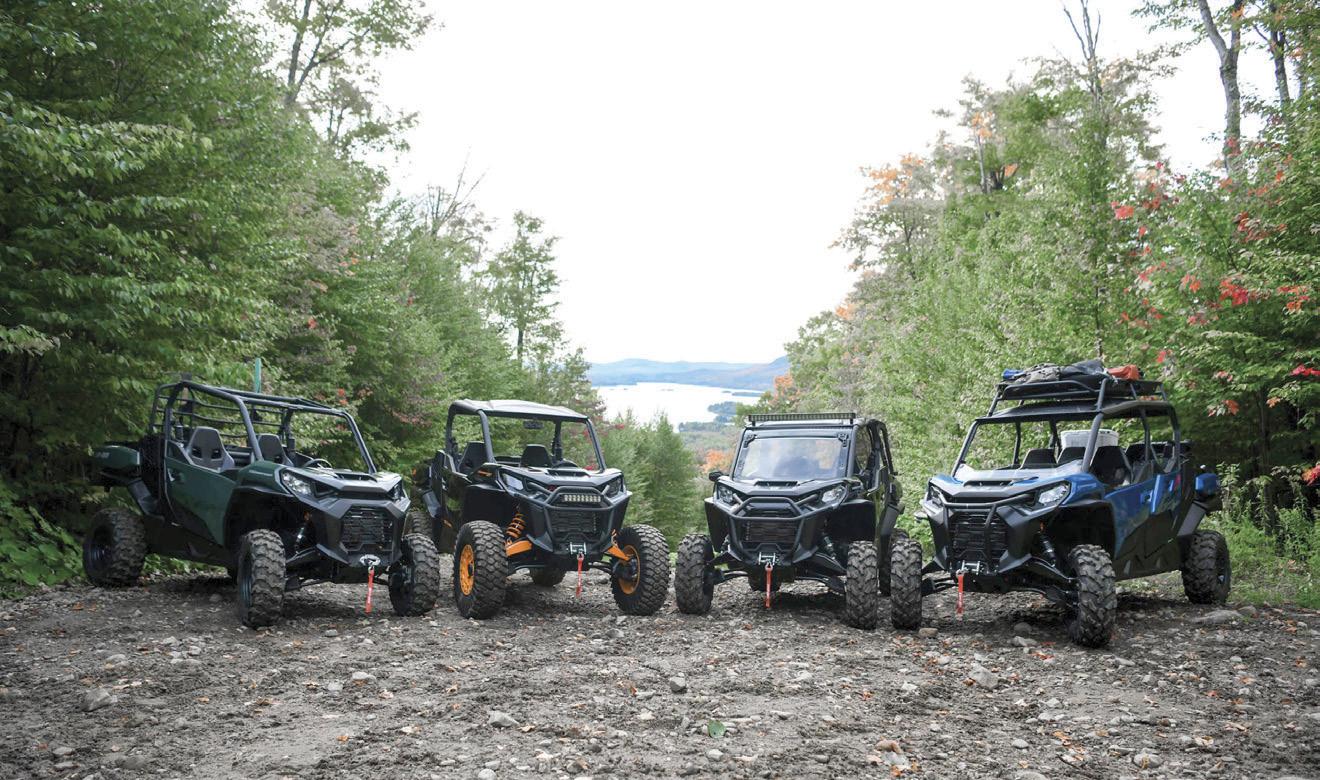
Spring 2023 77 We are the area’s leading powersports store! Stop by to check out the latest products, parts, service, repair, or maintenance. (603) 447-5855 • 1319 WHITE MOUNTAIN HWY, CONWAY, NH ProfilePowerSports.com WELCOME TO PROFILE POWERSPORTS LET THE FUN BEGIN!
TOUR OF THE NOTCHES
19th-Century Art
 By Bob Cottrell
By Bob Cottrell
Here’s something you may not be aware of: the White Mountains have attracted artists since the early 1800s and the region is home to an important school of American art. The Conway Public Library’s Henney History Room recently presented an “armchair” virtual PowerPoint tour of the notches through the White Mountains via 19th-century artworks.
They now offer this program free to local schools and community groups. The program explores the historic relationship between people and nature through artworks, literature, science, and poetry in the White Mountain tradition.
The library looks at the history and nature behind the art, the geological formations that attracted the artists—waterfalls, flora and fauna; and the tools and techniques they used in their paintings, drawings and prints, along with the history they captured in their work, such as farm and village life.
A book published in 1985 by Catherine Campbell lists over 450 artists and 3,000 works of White Mountain art. As a result, this article can give just a taste of the topic, and focuses on a few examples to show different approaches to White Mountain art.
Tour Stop #1
One hundred sixty-nine years ago, five artists stopped along the road to sketch Chocorua Lake and its spectacular backdrop. The sketch is now at the Smithsonian’s Cooper Hewitt Museum in New York City. Additional details can be found at www.tinyurl. com/ynd6sw2h. Taken together, these sketches serve as a window into the past, allowing us to get a real sense of that trip. In 2013, this same view was selected as a design for a new quarter as part of the NH State series of coins.
One of the attractions for artists and tourists to visit the White Mountains was a large number of dramatic, often tragic, stories and legends told about places in the region. Just up the
street from this view is a New Hampshire state highway marker that tells the horrific legend of Chief Chocorua—complete with a number of revenge murders.
A link to that marker can be found at www.tinyurl.com/3n4aese7 and you can read more about the legend at www. chocoruanh.com/the-legend-of-chocorua.
Tour Stop #2
The most famous view of the White Mountains from Conway can be studied in great detail on the stairway of the Conway Public Library. The vista was taken from Sunset Hill in North Conway, now the site of the Red Jacket Mountain View Resort. The view is now blocked by trees, but you can get a very similar scene from the nearby cemetery.
The print was based on an oil painting by John Frederick Kensett. Harvey Dow Gibson used a later Currier and Ives print of the scene as the basis of a mural in the Currier and Ives room at the Eastern Slope Inn.
All of the geological features, stone walls, open fields, and the main buildings have been confirmed by period maps and photographs, which help us explore the character of the town at the time. Additional information about Sunset Hill can be found at www.tinyurl.com/mu3eayw7.
While in Conway, check in with the library and the Conway Historical Society, which both have a number of White Mountain artworks, as well as tools used by the artists themselves.
As the “tour” continues on Route 16 towards Pinkham Notch, make a stop in Jackson at the Museum of White Mountain Art, where you can find wonderful examples of art and a large relief map to help you orient yourself.

78 MWVvibe.com
LEFT: This print can be seen in the stairwell at the Conway Public Library, as shown in the inset by Bob Cottrell. The print was based on an oil painting by John Frederick Kensett. The vista of the original painting was taken from Sunset Hill in North Conway, now the site of the Red Jacket Mountain View Resort. ABOVE: Drawing, Artists sketching at Chocorua Pond, New Hampshire, 1854 by Daniel Huntington. Cooper Hewitt Museum. Artist Thomas Cole’s sketches of Chocorua have been turned into a print and is featured along with a period poem on one of Tamworth Distillery’s whiskey bottles. BELOW: The Bridle Path, White Mountains, by Winslow Homer 1868.

Tour Stop #3

In Pinkham Notch, take a trip up the Mt. Washington Auto Road and you will see the mountain views seen in this Winslow Homer painting. You can also study the types of frost-shattered rocks in the foreground known by geologists as felsenmeer, or “sea of rocks.”

There are several preparatory pencil and oil sketches for this finished
artwork. It is interesting to see how Homer made changes as he developed his ideas. Scholars have suggested Homer was playing on the homophone title: bridle path (path for horses) and bridal path (leading to marriage). For related info, visit www.tinyurl.com/2yvrpkm7.
Next on the tour is a visit to Pinkham Notch and down through Crawford
Spring 2023 79
The Clark Museum
Notch. Crawford Notch is home to the well-known story of the Willey Slide, in which an entire family was killed in a rockslide, but in what some say was a warning from God: the house in which they should have stayed was untouched.
For more on this story, see the Summer 2017 edition of Mt. Washington Valley Vibe, www.mwvvibe.com/landscape-of-terror, and our blog: www.tinyurl.com/57da7wtp.
Tour Stop #4
Another tragic, but popular, tale is the story of Nancy, for which a waterfall, brook, pond, and hiking trail are now named.
In his 1882 book, The Heart of the White Mountains: Their Legend and Scenery, Samuel Adams Drake relates that she followed her betrothed, but was caught in a snowstorm, and was found frozen to death along the trail. Her ghost is said to still be heard to this day.


Thomas Cole was one of the first people to illustrate the site of the Nancy tragedy in 1828. The original sketches can be found in the Detroit Institute of Arts at www.tinyurl.com/3jnyfn9s. He also wrote the story in his journal.

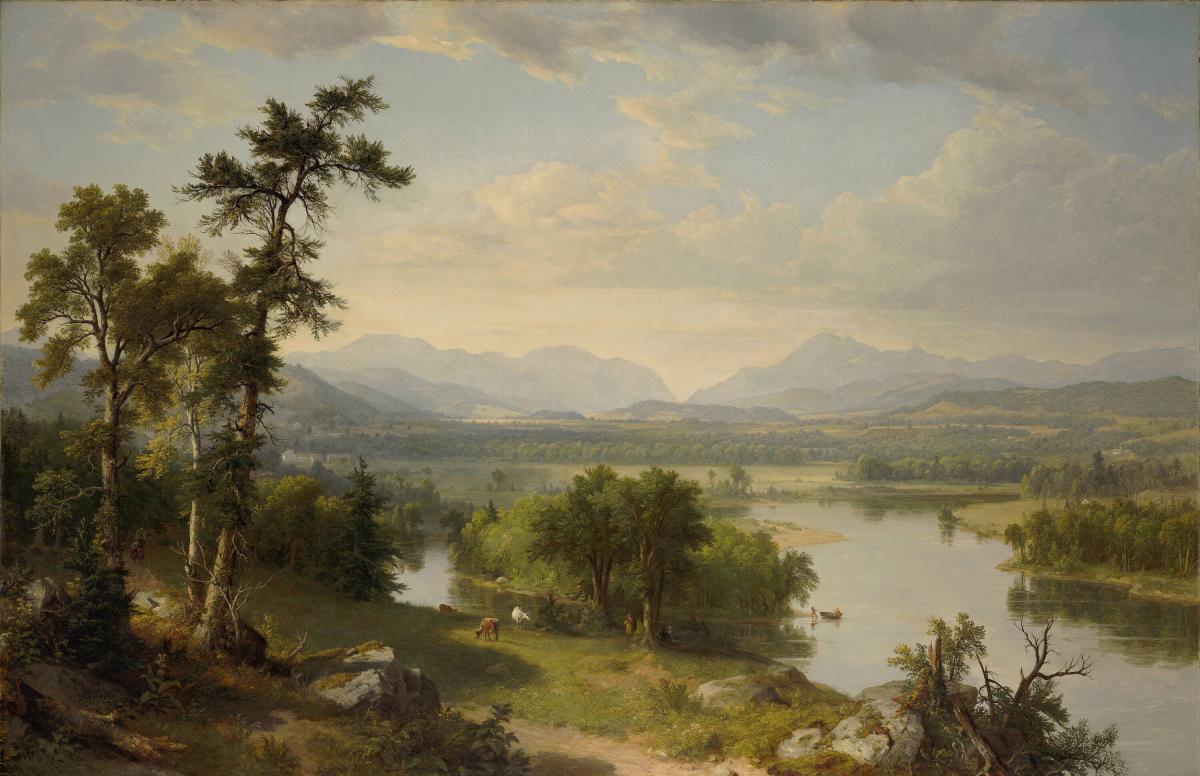
Tour Stop #5
From here, head over the Kancamagus Highway to Lincoln and north up Franconia Notch. As Interstate 93 is a divided highway, this allows you to stop at sites on the east side on the way north and others on the west as you head south. This is a good example of a landscape within a landscape, as well as another example of one artist depicting another artist while they work.
The landscape in the background shows the distinctive shape of Franconia Notch from the south.
Tour Stop #6
After reaching the top of Franconia Notch, you can head back down south, and if you take a break and climb up into the mountains, you can find this viewpoint showing Profile Lake and the Old Man of the Mountain in the distance. Old Man of the Mountain as seen online at www.whitemountainart.com/eh121. If you continue south on I-93 to exit 32, you will find that the visitor center has an excellent display of the White Mountain art and the Grand Hotel era.
The number of places still left to explore is endless. The Conway Public Library’s Henney History Room welcomes any questions. As they say, “Live Free and Study Art!”
Henney History Room Hours
Monday – Thursday – 9 a.m. to 2 p.m. 2nd & 4th Saturdays – 9 a.m. to 1 p.m.
For more info, contact Bob Cottrel at the Conway Public Library’s Henney History Room: (603) 447-5552; bcottrell@conwaypubliclibrary.org.
Conway Public Library
15 Greenwood Avenue, Conway, NH
80 MWVvibe.com
Nancy in the Snow. Samuel Adams Drake, The Heart of the White Mountains: Their Legend and Scenery, 1882. Courtesy of the Conway Public Library.
Franconia Notch from West Campton by Asher B. Durand. For more information, go to www.tinyurl.com/2yhskw3y.
Portrait of Asher B. Durand (painting in Franconia Notch, 1855) by Daniel Huntington.
ARTISTS & GALLERIES OF THE MT. WASHINGTON VALLEY
Artworks
132 White Mountain Highway, Chocorua, NH • (603) 323-8041
www.chocoruaartworks.com
Bill Fein Gallery
106 Fein Lane, Center Conway, NH (603) 356-7943
Cassidy Gallery (603) 662-2074 • www.cassidygallery.com
Cook Memorial Library
93 Main Street, Tamworth, NH (603) 323-8510 • www.tamworthlibrary.org
Edge of Maine Art & Framing
182 Main Street, Brownfield, ME (207) 935-2817 • www.edgeofmaine.com
Erik Koeppel Fine Art PO Box 325, Jackson, NH (603) 383-7062 • www.erikkoeppel.com
Fryeburg Harbor Antiques and Fine Art Gallery

506 Harbor Road, Fryeburg, ME (207) 925-2848 • www.fryeburgharbor.com

Gallery 302
112 Main Street, Bridgton, ME (207) 647-2787 • www.gallery302.com
Gateway Gallery & Gifts
32 Exchange Street, Gorham, NH (603) 466-9900 • www.gatewaygallery.biz
Harvest Gold Gallery
1082 Main Street, Center Lovell, ME (207) 925-6502
www.harvestgoldgallery.com
Jackson Art Studio & Gallery
155 Ridge Road, Jackson, NH (603) 387-3463 • www.jacksonartnh.com
Jesse Mixer Metalsmith North Conway, NH • www.jessemixer.com
Karen Eisenberg Designs North Conway, NH • (603) 662-9887
www.kareneisenberg.com
League of NH Craftsmen
North Conway
2526 White Mountain Highway, North Conway, NH • (603) 356-2441
www.northconway.nhcrafts.org
Linda Gray Intervale, NH • (603) 986-1028
www.lindagrayartwork.com
Louise Perry of Vintage Frameworks 28 Norcross Circle, North Conway, NH (603) 356-7711

www.vintageframeworks.com
Main Street Gallery/MWVArts
16 Norcross Circle, North Conway, NH (603) 356-2787 • www.mwvarts.org
Molly Mundy Art and Illustration Jackson, NH • www.mollymundy.com
Nathan Macomber Glass Studio
480 Eaton Road, Conway, NH (603) 447-1825
www.macomberglass.com
NW Cassidy Fine Art (603) 662-2074 • nwcassidy@earthlink.net
Patricia Ladd Carega Gallery
69 Maple Street, Center Sandwich, NH (603) 284-7728
www.patricialaddcarega.com
Robert Gordon Gallery Kancamagus Highway, Conway, NH (603) 356-7943
Roger C. Williams Fine Art
125 Main Street, Lovell, ME (207) 925-3380
www.rogerwilliamsfineart.com
Skyforest Gallery
407 White Mountain Highway, Conway, NH • (760) 770-3777
Surroundings Art Gallery
12 Main Street, Sandwich, NH (603) 284-6888
www.surroundingsart.com
Stained Glass Shack Studio
63 West Main Street, Conway, NH (603) 447-4949
www.stainedglassshack.com
St. Kieran Community Center for the Arts
155 Emery Street, Berlin, NH (603) 752-1028 • www.stkieranarts.org
Virginia Moore Pet Portraits & Fine Art
83 Crossover Road, Albany, NH (603) 520-8230
www.vmooreportraits.com
White Mountain Artisans Gallery

3358 White Mountain Highway, North Conway, NH • (603) 356-6546
www.whitemountainartisansgallery.com

White Mountain Photography
95 Main Street, located inside Snowflake Inn Jackson, NH • (603) 374-6050
www.whitemountainphoto.com
With These Hands Pottery
397 Tasker Hill Road Conway, NH (207) 256-2522
www.withthesehandspottery.com
(603) 662-0452
328 White Mtn Hwy, Conway, NH
Spring 2023 81
Antiques • Home Decor • Jewelry Custom Furniture
Chalk Paints 28 MAIN ST, CONWAY VILLAGE JOANNE PARADIS • (978) 387-8030 The RusticPyro@gmail.com The Rustic Pyro Wood-burned Art • Home & Cabin Decor Personalized & Monogrammed Gifts Next to the Majestic Theater! Report corrections to info@mwvvibe.com.
•
Check out these cool and quirky lesser-known “facts” about the Mt. Washington Valley!
Following the Civil War, many thriving towns were eager for the “iron horse” to reach them, out of the fear their tourism business would suffer. By 1871, the Portland & Ogdensburg line finally reached the White Mountains. Along the way, carpenters built Victorian depots in the Muscovite (Russian) design, saving the most grand for North Conway, the most northern terminal on the line. Designed by Boston architect Nathaniel J. Bradlee, the North Conway depot included a mahogany staircase, men’s and women’s waiting rooms, and a boardwalk to the impressive Kearsarge Hotel (site of the newly built North Conway Community Center).

• The White Mountain National Forest was officially established in May of 1918 after President Woodrow Wilson signed the Weeks Act of 1911. In 1914, William Logan Hall began purchasing land from seller s and within a year bought a quarter-million acres. The land purchased by Hall was mapped in 1914 and titled the “White Mountain Region.”
Tuckerman’s Ravine, the southeastern side of Mount Washington, was named for botanist Edward Tuckerman, who studied alpine plants and lichens in the area in the 1830s. The Dartmouth Outing Club made the first ascent of the mountain by way of the carriage road in 1913, followed by John S. Apperson of NY in April 1914, as the first man on skis in the ravine. The ravine attracted more and more skiers, but no attempts were made to ski the headwall. Finally, on April 19, 1931, Robert Livermore, Brad Trafford, and Robert Balch made history as the first to ski from the summit over the headwall.
The spring of 1903 in the White Mountains is known as the “Year that New Hampshire Burned,” due to dry conditions. Five hundred fires burned 10% of the forests, creating a threat to the population. Lack of detection and communication were addressed by the building of the first fire tower c.1904 on the Mount Rosemont summit. Standing 20 feet tall, it overlooked Bretton Woods with telephone access to Mt. Pleasant Hotel. In 1909, the State of NH began to fund the building of fire towers. By WWII, there was a shortage of men; so women, known as WOOFS, Women Observers on the Forest, were trained to spot aircrafts and report potential issues.
• Benjamin W. Kilburn, native of Littleton, NH, was a pioneer in photography of the White Mountains. Along with his brother, they were known for their stereoscopic images of various locations, including the Old Man of the Mountain. In 1882, he was granted a patent for the Kilburn Gun Camera, an alternative to using a tripod on the rocky White Mountain terrain.
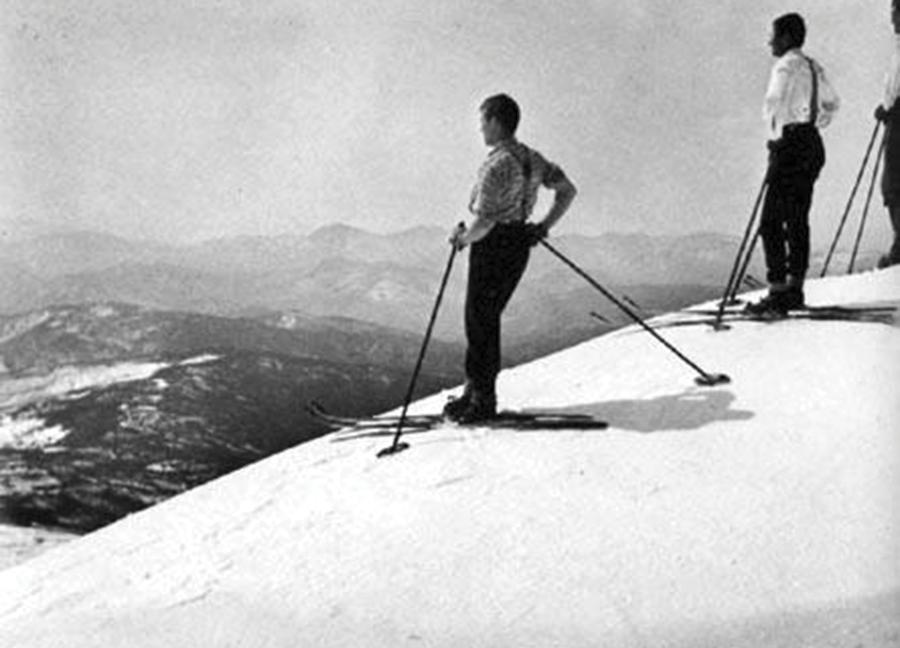
• The first summit shelter was built in 1823 by Ethan Allen Crawford, who saw the need for hikers on Mount Washington. It was re-built each spring and lead the way for permanent summit hotels in the 1850s.
• In 1858, Henry David Thoreau visited the White Mountains and slept out in nature instead of a hotel. He sustained a sprained ankle while hiking and his guide accidentally set fire to the floor of the ravine.
The White Mountains were home to a number of seasonal hotels during a time known as the “Grand Hotel Era.” Many of these hotels featured top-of-the-line amenities and hosted musicians, writers, and painters from all over. In the 1850s, a trend began to form as various hotels had musical pieces commissioned for their house bands to perform. Pieces were written in the style of polkas, waltzes, marches, and for subjects such as the Old Man of the Mountain. Hotels such as the Glen House, the Kearsarge Hotel, the Crawford House, Mt. Pleasant Hotel, and the Mt. Washington Hotel all had their own commissioned piece.

• Drs. Edwin Remick and son Edwin Crafts Remick, of Tamworth, NH, served as the only town doctors for almost a century. In the early 1900s, Dr. Remick would make house calls by buggy or sleigh, depending on the season, charging $1 or $2 for after midnight. Upon inheriting a farm, he moved his practice there and became a farmer/doctor, with his son carrying on the practice for another 58 years after his death.
• When the Mount Washington Hotel opened in 1902, it included a waterpowered printing press on the property. Their publication was The Bugle of Bretton Woods and was distributed to the guests of the Mount Washington Hotel and the Mt. Pleasant Hotel during breakfast.
Know of an interesting story, past or present, pertaining to the Valley? See something here that isn’t accurate? Let us know! Send suggestions or corrections to info@mwvvibe.com

82 MWVvibe.com 66 MWVvibe.com
Courtesy photo, from May 2017
Photo courtesy of Conway Scenic Railroad
Photo courtesy of whitemountainhistory.org
Photo courtesy of “Tuckerman Ravine: The Early Days of Spring Skiing” New Hampshire Profiles, April 1971
Orchestra at the Mt. Kearsarge House, c.1875, Pease stereoview




Spring 2023 NORTH CONWAY Services Include: Botulinum Toxins (ie-Botox) Fillers (Restylane, RHA, etc) Biostimulatory Fillers to improve skin laxity & collagen production Lifting Threads Microneedling and PRF Radiofrequency, Skin Tightening, and Body Contouring Medical Grade Skin Care IPL for Hair Removal, Vascular Lesions, Pigment, and Photorejuvenation About The Studio (603) 466 2323 www.freshfacestudio.com Fresh Face Studio is a comprehensive medical spa founded by Dr. Edwin Giron. We offer state of the art therapeutic and facial esthetic treatments using a broad range of procedures, products, and technologies. We strive to achieve an authentic, fresh, and rejuvenated look. 2506 White Mtn Hwy North Conway, NH 03860 Dr. Edwin Giron and Caitlin Behr, RN info@freshfacestudio.com Scan to learn more!













Visit our online virtual showroom for the best selection of the latest styles in furniture and appliances in the North Country! Welcome to Northern New Hampshire’s LARGEST FURNITURE and APPLIANCE showroom! Our nine-level warehouse helps to ensure availability, and we carry many manufacturers in our large showroom. An in-house team of full-time service professionals guarantees we stand behind what we sell. IT’S WORTH THE TRIP! COME IN AND GET A JUMP ON SPRING!
























































































 Tom Earle, Earle Family Farm
Tom Earle, Earle Family Farm

















































































 The trail along Zeacliff, which begins in Bethlehem, NH . Photo by Lily Hartman
The trail along Zeacliff, which begins in Bethlehem, NH . Photo by Lily Hartman
















 A spring day on Franconia Ridge. Photo by Lily Hartman
A spring day on Franconia Ridge. Photo by Lily Hartman
 By Lily Hartman
By Lily Hartman



































 By Dr. Cheryl Cullion
By Dr. Cheryl Cullion

















































































































 By Bob Cottrell
By Bob Cottrell

































